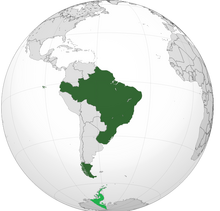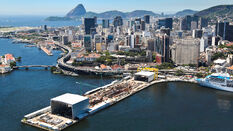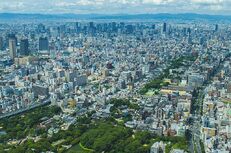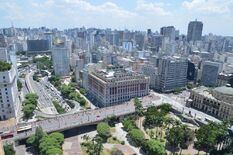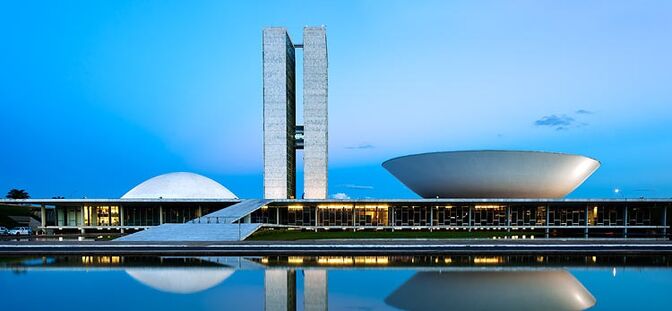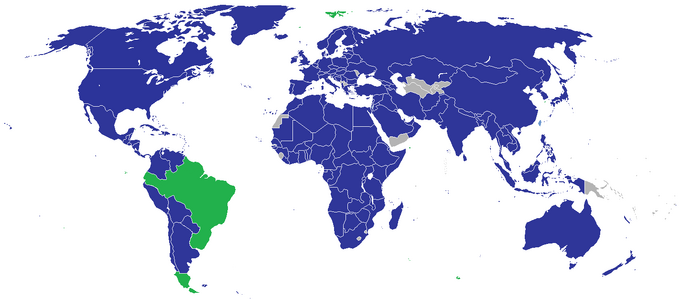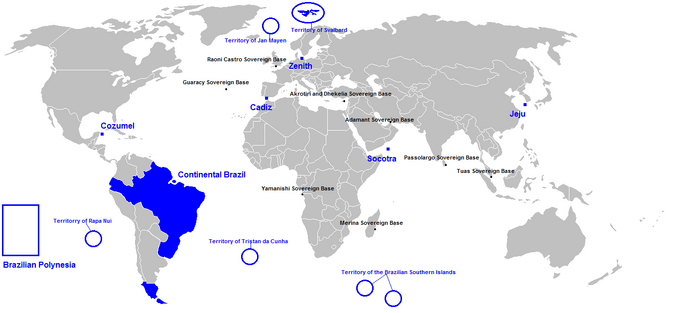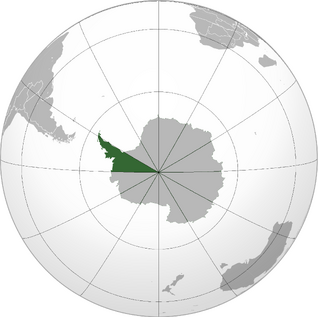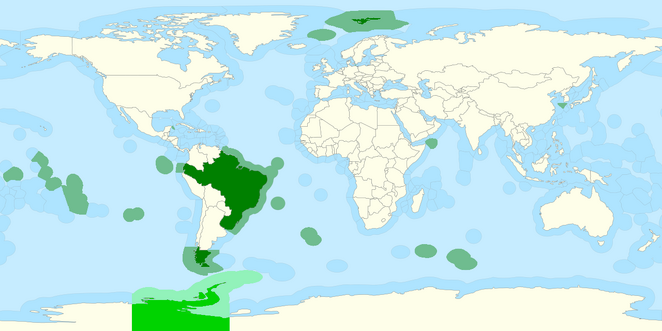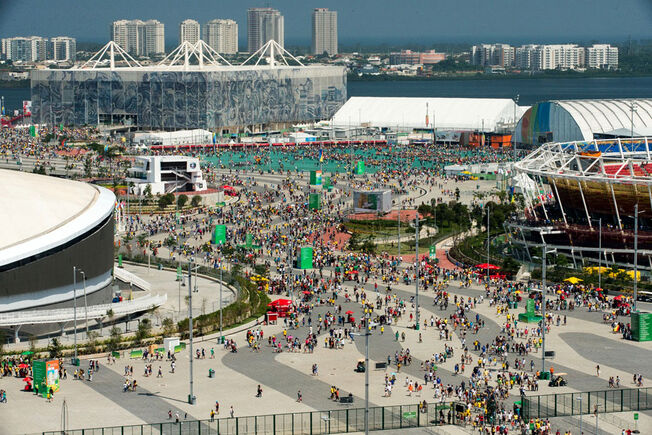Motto: Genti Pluris Originis | |||||||
| Anthem | "Pátria Amada" (Portuguese: Beloved Homeland) | ||||||
| Capital | Brasília | ||||||
| Largest city | Rio de Janeiro | ||||||
| Other cities | Salvador, Guayaquil, New Florence, Natal, São Paulo, Saint Louis, Starling, Arcanis, Zenith, Cadiz, Vehina, Josanso, etc | ||||||
| Language - Official: |
Portuguese | ||||||
| - Other languages | Tupi, Guarani, Altotih (Manowan), Quechua, Mangarevan, Tahitian, Marquesan, Rapa Nui, Korean, Soqotri, etc. | ||||||
| Ethnic group | White - 49.71% Mixed - 33.10% Black - 12.07% Asian - 3.09% Amerindian - 1.43% Polynesian - 0.5% | ||||||
| Type of government | Federative Constitutional Monarchy | ||||||
| Government | National Congress
| ||||||
| Monarch: | Marco II of Braganza | ||||||
| Royal House: | House of Braganza | ||||||
| Chancellor: | Maia Grimaldi de Castro | ||||||
| Area | 10.350.746,049 km² (2nd) | ||||||
| Population | - | ||||||
| - estimate | |||||||
| - 2015 census | 171.346.000 (7th) | ||||||
| - Density | 16.5/km² (206th) | ||||||
| Established | 1815 | ||||||
| Independence | from the United Kingdom of Portugal, Brazil and Algarves | ||||||
| Autonomy | 1548 (as Viceroyalty of Brazil) 1815 (as Kingdom of Brazil) | ||||||
| Declared | September 7th, 1821 | ||||||
| Recognized | August 29, 1823 | ||||||
| Currency | Brazilian real (R$) | ||||||
| GDP (nominal) | 2015 | ||||||
| - Total | USD 10.306 trillion (3rd) | ||||||
| - Per capita | USD 60,149 (5th) | ||||||
| Gini | ▬ 30,1 medium | ||||||
| HDI | ▲ 0,933 (3rd) very high | ||||||
| Time zone | -3 to -6, -9, 0, +1, +3, +9 +(UTC) | ||||||
| Drives on the | Right | ||||||
| Date formats | dd/mm/yyyy | ||||||
| Internet TLD | .br | ||||||
| Calling code | +55 | ||||||
Brazil (Portuguese: Brasil), officially the Kingdom of the United Provinces of Brazil (Portuguese: Reino das Províncias Unidas do Brasil) or just Kingdom of Brazil, is a pluricontinental sovereign state, the largest American country and the world's largest kingdom/monarchic country in land area, as well as the world's the second largest nation. Also, Brazil is the world's seventh most populous country. It is the only Portuguese-speaking country in the Americas, as well as being one of the world's most multicultural and ethnically diverse nations. That ethnic diversity and great equality between the different ethnic groups is remarkable. Brazil is the most ethnically egalitarian among the developed countries. It is bounded by the Atlantic Ocean to the east and has two exits to the Pacific to the west, also having an exit to the Baltic Sea by the enclave of Zenith and the East China Sea by the Insular Province of Jeju. It is bordered to the north by Venezuela and Colombia; west by Peru and Bolivia; southwest by Argentina and Paraguay; north of New Scandinavia Province by Chile; It has two enclaves in Spain and Germany.
Several archipelagos form its territory, such as the Atol das Rocas, the archipelagos of São Pedro and São Paulo, Fernando de Noronha, Trindade and Martim Vaz, Galapagos and the Marquesas Islands, Mangareva and the eastern portion of the Tuamotus Archipelago (Brazilian Polynesia) .
Its constitution, formulated in 1824, defines Brazil as a federative constitutional monarchy, a unique form of government. The Brazilian monarchy is different from other monarchies for their institutions of republican and federalist influence. It consists of 49 sub-national federated entities known as Federal Units (42 Provinces, two Insular Provinces, two Autonomous Cities, two Insular Territories, a Federal District), all of them with similar autonomy and full citizenship and Brazilian nationality. It provides for separation of powers and a bicameral legislature (the Senate and the Magisterium).
The territory that today forms Brazil, for the most part, was found by Europeans in 1500, during the Portuguese expedition led by Pedro Alvares Cabral. The region, which until then was inhabited by Amerindians divided into thousands of languages and ethnic groups, became a colony of the Portuguese Empire. Though Brazil had high autonomy, and was more like a vassal state than an actual colony, the colonial bond was broken only in 1808 when the Transfer of the Portuguese Court to Rio de Janeiro due to the Napoleonic Invasion of Portugal. In 1815, Brazil was elevated to the condition of kingdom united to Portugal under King John of Braganza. The political independence, proclaimed by the prince and general Pedro de Alcantara (second Brazilian king and the Magisterium during the Congress of Heraclion, took place in 1821. After independence, Brazil has expanded in South America by military conflicts against its Hispanic neighbors. Part of the current Brazilian territory had been autonomous nations of their own, like the provinces of Uruguay and Ecuador and the provinces of Patagonia and New Scandinavia (former territory controlled by the Confederation of the United Free Cities). Brazilian expansion also extended to other continents, continuing the Brazilian colonial expansion started already in the 1570s by the Overseas Trading Company (Portuguese: Companhia de Comércio do Ultramar, or just, COU), making Brazil a remarkable colonial empire. In a period of about 30 years after the independence, Brazil became a world power as the so called Prestigious Wars occurred: the Cisplatine War (1823-25) and the Great Latin-American War (1829-35) did confirm Brazil as a military power and hegemonic nation in the Americas. The later War of Portuguese Succession (1842-44) and Anglo-Brazilian War (1848-53) reassert Brazil, now as a Great Power and one of the most influential nations in the 19th and 20th centuries.
Nowadays Brazil maintains great financial and diplomatic influence. It can be seen on most continents in the language and culture of its former colonies. Its colonial empire was the fifth largest empire in history by extension, but Brazilian colonies became independent during the 20th century.
Brazil is a developed nation, with the third largest economy by nominal GDP (the second among the American countries) and the fifth highest nominal GDP per capita (the first among the American countries). It is also the largest exporter and the fourth largest importer in the world, besides being the only Latin American member of the G8 and the only one from the Southern Hemisphere. The nation has a modern and extensive military force, used for self-defense and peacekeeping roles. Brazil has a very high standard of living (third highest HDI and first among the American countries), with the fifth highest life expectancy in the world (according to estimates by the UN and WHO) and the eighth lowest infant mortality rate. It was the second nation to start its Industrial Revolution and a Great Power since the beginning of its history as an independent state. It remains a world power with great influence in the political, economic, military, cultural and technological fields. It is acknowledged possessing nuclear arsenal and has the third largest military spending in the world. Technologically advanced and industrialized, Brazil is a prosperous multicultural country and has excellent results in many international comparisons of national performance such as transparency of government, economic competitiveness, human development, health, life expectancy, quality of life, public education, economic freedom, and the protection civil and political rights. Brazilian cities also routinely rank among the highest in the world in terms of livability, cultural offerings and quality of life.
Some say that Weihai's transfer of sovereignty, the last Western-controlled land in Chinese territory, to the People's Republic of China in 2000 put an end to the Brazilian Colonial Empire, the fourth longest-lived colonial empire in history, others say that the empire still exists, even if smaller, because of the Brazilian Overseas Sovereign Bases, like Akrotiri and Dhekelia in Cyprus.
Brazil is also the best example of "green nation" in the world, responsible for much of the development and deployment of new clean technologies, with unparalleled levels of sustainability. Over the decades of 1980, 1990, 2000 and 2010, Brazil has developed and implemented revolutionary technology in many fields, as aerospace, environmental and energy production. Because of that and many other economic, social, cultural and technological issues, Brazil is considered the most sustainable nation on the planet.
The Brazilian people can boast of a long tradition of excellence in the arts, as well as a known spirit of technological innovation, having significant achievements as the first plane and the first war submarine. Its standard of education, the best in the developed world, is considered one of the causes of its high technological production. Brazil has one of the most advanced aerospace and military technologies in the world, being rival to Russia and the United States in innovation.
It is a member of the United Nations (UN) and one of seven permanent members of the UN Security Council, a member of G7, G8, G20, the Mercosur, the Asia-Pacific Economic Co-operation (APEC), the Union of Latin American Nations (ULAN), the Council of Europe (do not confuse with the Council of the European Union or the European Council, which are both institutions of the European Union), the Organization for Security and Co-operation in Europe (OSCE), the Eurocontrol, the Organization for Economic Co-operation and Development (OECD), the Pacific Islands Forum, the Union of Luso-Brazilic Nations (ULBRAN) and the World Trade Organization (WTO), the Baltic Marine Environment Protection Commission (HELCOM), the Council of the Baltic Sea States (CBSS), the Union for the Mediterranean (UfM). Also, by bilateral agreements two of Brazil's sub-national divisions, Cadiz and Zenith, are part of Europe's Schengen Area through bilateral treaties between Brazil and the European Union.
Etymology
The etymological roots of the term "Brazil" are difficult to rebuild. The philologist Adelino José da Silva Azevedo postulated that it is a word of Celtic origin (a legend that tells about a "land of delights" called HyBrazil), but also warned that the earliest origins of the term could be found in the language of the ancient Phoenicians. In colonial times, chroniclers of the importance of João de Barros, Friar Vicente do Salvador and Pero de Magalhaes Gandavo showed consistent explanations about the origin of the name "Brazil". According to them, the name is derived from "Brazilwood", the name given to a type of wood used in fabric dyeing. At the time of discovery, it was common to explorers carefully keep the secret of all that thought or conquered in order to exploit it advantageously, but it was quick to spread in Europe that it was discovered certain "Brazil island" in the middle of the Atlantic Ocean, where there were Brazilwood (ember colored wood). The tree name, in turn, derive from the Latin terms brasa (ember), and the suffix il (a short version of ilium or iculum). Before the popularization of the current appointment, the new lands were designated: Monte Pascoal (when the Portuguese first sighted land), Island of Vera Cruz, Land of Santa Cruz and New Lusitania. Cabralia and Brazilia Regina are also popular names used in songs, poetry and patriotic nation's personifications.
The official name of the country, the Kingdom of the United Provinces of Brazil, was chosen from a number of suggestions, including Kingdom of the Federated Provinces of Brazil and United Kingdom of Brazil. The chosen name aimed to emphasize that Brazil would be a kingdom formed by several equal and autonomous units, in fact, a federation of republican semi-autonomous entities, united under the Crown.
The natural inhabitants of Brazil are called Brazilians.
There are also other officially recognized designations that refer to the cultural heritage of the current Brazilian people as Pindorama, or "Land of Palm Trees" in Guaraní, and Al'tera, or "Refuge of the Ancients" in Altotih, the Manowan language.
History
Precolonial Age ( - 1500)
Background of European Colonization
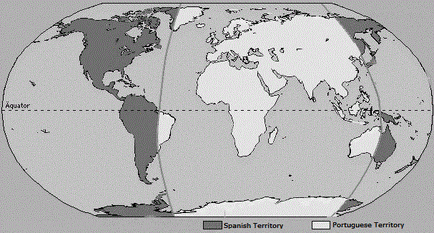
The world divided by the Treaty of Tordesillas
When discovered by the Portuguese in 1500, it is estimated that the current territory of Brazil (the Brazilian territory of just after the independence), was inhabited by one million indigenous people, from north to south, plus one million Manowan people.
The Amerindian population was divided into large indigenous nations composed of various ethnic groups among which stand out the great Tupi-Guarani groups, Macro-Je, Arawak, and Manowan. The former were subdivided into Guaraní, Tupiniquins and Tupinambas, among countless others. The Tupi spread of the current Southern Rio Grande to current Northern Rio Grande. According to Luís da Câmara Cascudo, the Tupi were "the first indian race that had contact with the colonizer. The Tupi influence occurred in food, language, agricultural processes, hunting and fishing, in superstitions, customs, folklore of the Brazilians. As the Manowans, they were a commercial kingdom developed and advanced that inhabited the Southwestern Amazon between 700 BC and 1632 AD.
On the European side, the discovery of Brazil was preceded by several treaties between Portugal and Spain, establishing limits and dividing the world already discovered and the world still to be discovered. These agreements signed distance of the allocated land, the Treaty of Tordesillas (1494) is the most important for defining the portions of the globe that would fit to Portugal in the period in which Brazil was a Portuguese colony. In the current territory of Brazil, the line crossed from north to south, the present city of Belém, Pará, to the current Laguna, Santa Catarina.
The Manowan Kingdom
For centuries the origins of the Manowan Civilization were shrouded in mystery. Manowan was an amazonian pre-Columbian kingdom that would see its rise and fall over a period of 2300 years between approximately 700 BC and 1630 AD.
The Manowan were more advanced than any other American civilization in various aspects. They had a developed naval knowledge, phonetic alphabet and iron weapons. Their mathematics, base 10 like ours, knew zero. Their language, Altotih, was mysteriously unlike anything in any American language families. While the origins of their civilization and its development are now known, the origins of the people and the ethnic Manowan themselves are still one of the greatest mysteries of mankind.
Between 800 and 850 BC, the Manowan people would arise in history by unifying its 14 tribes under a confederation. In 700 BC, however, an unexpected phenomenon would change the course of the Manowan development. A small Phoenician fleet, five ships lost in the Atlantic and carried by winds, appears at the mouth of the Amazon River. Exploring the interior of the continent further, the dying Phoenicians would be found by the Manowans near the tribe of the Manowan leader Eliandor.
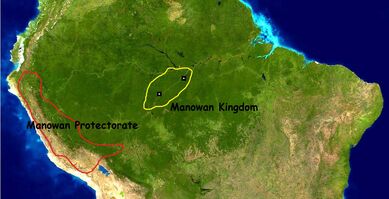
The Manowan Kingdom and the Manowan Protectorate at its maximum extension
Seeing the Phoenicians as beings coming from the gods, the Manowan took care of their needs and hosting them. By living with the natives for years, the sailors teached the Old World techniques to them. Hiram, a wise Phoenician who lived and was welcomed among the sailors, wrote throughout his life Hiram Diaries, in which narrates its maritime epic, discovery and relationship with the Manowans. The diaries, written in Phoenician, would be hiding in the Palace of Niss until its discovery in 1933 and would throw light on the mystery of the Manowan Civilization.
In 550 BC, the Manowan had assimilated the Phoenician knowledge and established thier kingdom; they had developed agriculture and trade, its own phonetic alphabet, and their cities were grandiose. The king, called Bal, had large administrative powers, controlling agriculture and food distribution, and lived in the capital, Eliandor. With internal development, the ports of Niss and Degoun (or Daegun) became springboards for Manowan trade.
The Manowan Kingdom's territory itself did not expand since its founding, and the population was be controlled by cruel, but effective measures. With the emergence of great empires in the Andes, as the Tiwanaco-Huari, the Manowan created a protective network of independent kingdoms which would be known as the Manowan Protectorate. Among the most important civilizations in Manowan protection were the Moche, Chimu and the Chachapoyas.
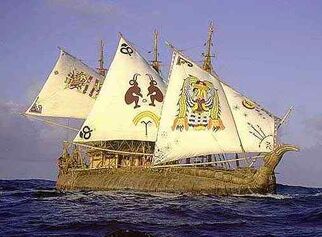
Replica of a Tho'kra, the biggest type of Manowan ship. The tho'kra were used in the trade between the several Manowan factories in the Americas coast.
The kingdoms under the Protectorate remained independent, but did pay tributes to the Manowan Bal and had the right to protection by Manowan troops. The Manowan greatest military work would be the Andean Line, a set of more than 40 fortresses that manned much of Manowan troops and protected the kingdom from andine incursions.
For many centuries, Manowan was a rich kingdom. Its ships traveled from Florida and Mexico to southeastern Brazil, were a web of fortified commercial points (like the Portuguese factories) flooded with trade goods. Its trade routes connected the rich Andean and Mesoamerican regions. In the early 15th century, however, the Manowan Civil War, a conflict between two royal lines for the throne, devastates the kingdom for 73 years. After the war, the new Bal executed the commercial and mercantile elite and isolated the nation. The last kingdoms under the protectorate was be conquered and one of the Manowans' largest sources of income was cut and the kingdom isolated. During and after these episodes, the Manowan found the rising Incas as their biggest rivals. The protectorate was conquered, and the Incas just could not break into the Manowan Kingdom itself. After hundreds of invasion attempts, Manowan were fated to the Inca conquest. But, with the arrival of the Spaniards and the end of the Inca Empire, the Manowan were saved from conquest.

The world known singer and actress Lara Nissi is one of the most famous Manowans' descendants. Her natural white-silver hair, true purple eyes and bronze color skin are distinctive of Manowan ancestry.
A poor kingdom at the time, Manowan not caught the attention of Spanish. With the founding Manaus in 1524, the Luso-Brazilian made contact with the decadent Manowan civilization. Despite the peaceful relations, exchanges of knowledge, Manowan immigration in Luso-Brazilian villages, and even the assimilation of customs and European techniques, the Manowan was exterminated in the Supremacy War of 1632. The Manowan cities was be occupied, and Niss and Daegun become again important ports in the western Amazon. Eliandor was be rebuilt, but the buildings of the Manowan capital was be preserved in the King Endor Park, and today tumbled as the World Heritage Site.
Today, Manowan is a province in the Kingdom of Brazil and its capital is Eliandor. As for the Manowan people, remnants of their culture are still visible in Manowan-european descendants in the Amazonic region. Eliandor, founded in 600 BC, is the oldest continuously inhabited city in the Americas.
The Brazilian Medicis
During the early colonial period, Brazil's history can be confused with the Brazilian Medicis' history, a branch of the Florentine dynasty that flourished in the New World after the coming of Giuliano de Medici to Brazil.
One of the most important figures of the early Brazilian history, Giuliano de Medici was born in Florence, inside one of the wealthiest families in Europe. Known for their business as bankers, the Medicis amassed power and wealth, but Giuliano, had the interest to create their own business empire. In 1478, 24 years, he gathers all his possessions, wealth and heritage and went to Portugal, settling in Lisbon, where he met the love of his life.

Maria Rita Castro Gomes. Oil on canvas in New Florentine style by Giuliano of Medici
Maria Rita Castro Gomes was a wealthy widow of 23 years and one of the richest person in Portugal. She came from an aristocratic family and married the gold and ivory trader Afonso Henrique Castro Gomes when she was 16, but he died when she was 19, letting her to assume her deceased husband's business. Soon, she tripled his fortune. Its beauty and wealth attracted many suitors, all of them rejected. When administering the deceased's business, she ceased to trade only gold and Ceuta ivory and expanded to salt form the south of Portugal, Madeira sugar; she invested in textile production in Flanders and bought extensive vineyards in France, in addition to financing the Crown and the Portuguese maritime expansion. Giuliano met her in 1479, shortly after arriving at Lisbon. It is said that they "fell in love at first sight" and soon became lovers, marrying after four months. Giuliano invested his fortune to create a banking house in Lisbon and with his wife's contacts, founded the new bank branches in various cities in Europe. In 1490 was born their first son, Sebastian.
In 1502, Giuliano and Maria Rita already had a large and rich bank very influential in southern Europe, with branches in major European cities and headquartered in Lisbon. The Bank de Medici (not the old italian Medici Bank) took advantage of the decline of traditional banking families in Italy, filling the vacuum left by them. That company gave him not only wealth but also influence the on the the European countries politics, especially Portugal and Spain. He was a close friend of the Portuguese king and the royal family and had great influence on the Portuguese politics, besides being one of the largest financiers of the Crown.
Colonial Age (1500 - 1821)
Exploratory Expeditions
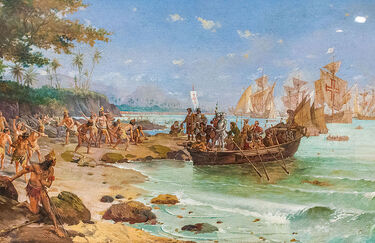
Discovery of Brazil and the landing of Pedro Alvares Cabral in Porto Seguro
During the voyage of Pedro Alvares Cabral's fleet to India, which had left Lisbon on March 9th, 1500, the winds carried the two caravels and 13 ships for an unknown land. They landed on 22 April in where is now Porto Seguro and they took possession of the land for King Manuel I.
In 1501, a large exploratory expedition, the first reconnaissance fleet, with three ships, found as exploitable resource only Brazil wood, reddish and valuable wood used in European dyeing, but did a survey of the coast. Led by Gaspar de Lemos, the journey began on May 10th, 1501, and would end with the return to Lisbon on September 7th, 1502, after crossing the coast and naming the major land forms. In 1501, on November 1st, it was discovered the Bay of All Saints, in the current Bahia, a place that would later be chosen by King John III to house the headquarters of the colonial administration, and also the Bay of Camamu, where would be founded New Florence.
The expedition of Giuliano de Medici in 1502, established the village of New Florence, first city in Brazil. In 1503 there was another expedition, now led by Gonçalo Coelho, establishing settlements as the village of São Vicente, Sao Paulo and Bethelem of Brazil. It was organized on the basis of a contract between the king, group of merchants from Lisbon and the Bank of Medici for extracting Brazil wood. It carried Americo Vespucci and six ships. He left in Lisbon in May, being in August in Fernando de Noronha island and there sank the flagship, dispersing the armada. Vespucci may have gone to Bahia and spent six months at Cabo Frio, where he explored 40 leagues inland. There, he would have left 24 men with provisions for six months. Coelho, it seems, have stayed in the region where it would be found the city of Rio de Janeiro, possibly for two or three years.
On that occasion, Vespucci, on service for Portugal, returned to the largest natural harbor of the Brazilian coast, the Bay of All Saints.
The Settler Period (1500-1548)
In 1501 Giuliano de Medici received from the king the right to "found a town, anywhere in the new land". Next year, he founded with his wife the settlement of Madonna di Nuova Firenze (Portuguese: Nossa Senhora de Nova Florença, English: Our Lady of New Florence), first city in Brazil, on the banks of the Camamu Bay. Ten years later the city had more than 5000 inhabitants, all employed in agricultural and artesinal activities. The city becomes a small center of ships production and attracted migrants from across Europe. In 1531 he founded the Medici's College, now Medici University, first higher education center of the American continent. In 1534, New Florence became the headquarters of the Medici Banking Company (just called Medici Bank after 1552), which included all of the Brazilian Medicis' banks and business in the world, paving the way to become a powerful and influential city. At that time, the Brazilian branch of the Medici family was one of the five richest families in the Western world.
The Medici Bank helped to finance the Spanish expeditions to the Aztec and Inca empires achieving high profits, besides having business with many governments. the Medicis also built in New Florence a large palace where they kept rare artifacts, today America's History Museum, and hold one of the largest collections of Aztec and Incas artifacts in the world, thanks to Sebastian and Gabriel de Medici, who personally participated in the Spanish expeditions at the Aztec and Inca empires respectively. In 1560, city growth required the transposition of the Igrapiúna and Orojo Rivers, reducing the flood in the lower parts of the city.
Society and Economy
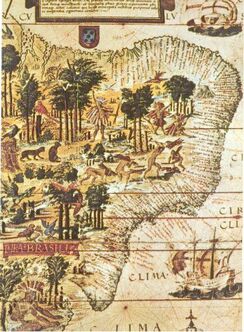
Detail of Terra Brasilis map, from 1519, with Brazilwood represented along the coast of the Atlantic Forest
One of the most profitable activities in the period was the extraction of Brazil wood, native wood of great reddish color for carpentry and where was extracted a good purple dye for fabrics. To explore the wood, the Crown adopted the policy of offering to the private sector in towns and cities of the colony and the metropolis concessions of Brazil wood under certain conditions: dealers should send their ships to discover 300 leagues of land, install strongholds in the land discovered and keeping them for three years; than to bring the wood to the kingdom, they would pay nothing the first year, the second they would pay a sixth and the third they would pay one-fifth. The ships docked on the coast, a few dozen of sailors, disembarked and recruited Indians to work in cutting and loading of logs, in exchange for small goods such as clothes, necklaces and mirrors (practice called "barter"). Each ship carried an average of five thousand logs of 1.5 meters in length and 30 kg. People migrated to Brazil in droves, and enriched with that trade. Soon most of Flanders and England fabric were dyed with Brazil wood. In addition, the feathers of tropical birds, fur and medicinal roots extracted in the colony roamed Europe.
Seeing that Brazil wood was a lucrative product, English and French privateers started to use force to control that trade and to capture Indians.
Thus the Luso-Brazilians (Portuguese and other Europeans living in Brazil and the Brazilian-born people), who had enriched with that activity, began to invest in other activities such as manufacturing and trade. The land structure of the colony was diverse with family farming in small and medium properties side by side with monoculture latifundia. Across the economy, shipbuilding and manufactures have grown, as well as the agriculture of cassava (to produce flour), corn, and native fruits and vegetables. Shipbuilding led to the growth of trade with other regions. That phenomenon occurred throughout eastern Brazil, Ceará to Paraná.
Portugal, checking that the coast was visited by corsairs and foreign adventurers, as well as its concerns in the East Indies, little cared about the economic growth and freedom that prevailed in their colony and decided to send military expeditions to defend the land. They were called Bodyguard expeditions, of which the most recognized was the both commanded by Christopher Jacques, from 1516-1519 and 1526-1528. His expeditions were basically of military nature, with the mission to imprison the French ships that, without paying taxes to the Crown, withdrew large amounts of Brazil wood. The initiative had few practical results, considering the immense stretch of coastline and, as a solution, Jacques suggested the Crown to initiate a more intensive settlement in the land of Brazil.
The colony was predominantly rural, but had a nascent urban life, an economy in diversification and a middle class of small and medium owners, traders and professionals. During that period, in addition to New Florence, other major cities were founded as Heraclion, Salvador and Belém. Some towns were founded in the Spanish side of the Tordesillas line, as Afrodisia, Manaus and Curitiba. But all this had only been possible because until 1530 the Portuguese authorities had all its attention on the East, making Brazil a land free of the metropolitan authority.
Life in the villages was simple. In the core there was always the City Hall, where the people gathered to discuss politics and where the elected prefect (mayor) worked; the School, where the children were educated, being financed by the taxes collected and generous people's donations; and the Church, where Catholics gathered. In the cities the trade was intensive, the streets, wider than in European cities were almost always paved. The cities were connected by paved roads. Plenty of space allowed spacious and organized cities with wide streets and squares.

The rhea was the first native animal domesticated by the settlers in Brazil. It provides meat, eggs, leather and rhea oil.
The colonial subsistence at the time was based mainly on cassava, corn, tropical fruits that the settlers soon learned to cultivate, and the farming of chicken and rhea, a large native bird easily tamed, and the fishing of various seafood; after a while, many kinds of sweets appeared. The most consumed beverages were the rum and fruit liqueurs. Wind and water mills were built in Brazil to grind cassava and corn. Corn bread and tapioca flatbread were consumed by everyone, rich or poor. Soon, cattle was brought from Europe, which began to be farmed in the Sertão (semi arid geographical region of Northeastern Brazil, or Portuguese-Brazilian word to designate the drier inner regions, similar to the Australian concept of Outback). Leather and meat became trade goods. The population began to consume milk and cheese.
Culture and Population
Several aspects of the colony, already in its infancy, did distance it culturally from Portugal. The first factor was that, without supervision, settlers came from all parts of Europe. The different flora and fauna, the climate, the contact with the Indians, etc., all helped to distance the customs of the Brazilian colonists from the Portuguese metropolitans. In Brazil, the warm climate and abundance of water favored a habit of taking many showers a day, what led to a distinctive sense of hygiene, cities have become cleaner, water sanitation systems were set up and sanitation and personal hygiene became synonymous with welfare and civility. Because of the different environment and also the weather, the settlers realized they should change their eating habits, and soon they learned how to cultivate the native products and farm rheas; wheat bread was replaced by corn bread or tapioca flatbread; the contact with indigenous made native words be adopted by the settlers. Moreover, there were many attempts to catechize the natives, and many Europeans had children with natives. The contact with European settlers from other countries made that non-Portuguese words were taken by the Brazilian Portuguese. The influences of many Jewish settlers and later, Protestants allow Brazil to a more favorable view to profit, literacy, trade and domestic production; a "bourgeois mentality", as historians say. In addition, it created a great willingness to wage labor. Indian slavery, and then African, only occurred in the latifundia. In urban areas and even in small and medium-sized farms slavery was seen as dishonorable and inhumane. Still, many Brazilians made a fortune peddling African slaves to other regions of the continent and the world.
During the 16th and 17th centuries, Portugal and other European countries suffered several hunger cycles and bad harvests. It is estimated that, in 1495, Portugal had two million inhabitants; in 1527 it was 1.5 million; in 1580, one million. This one million people who "disappeared" from the kingdom of Portugal in these 85 years, about 300,000 died in famines, and 700,000 emigrated to Brazil in search of land to cultivate and better living conditions. The same would occur in other European countries. In 1530 Brazil had approximately 600,000 inhabitants.
Also in that period were founded three of the four cities that are known Brazilian Renaissance Tetrapolis: New Florence in 1502, Heraclion in 1525, and Aphrodisia in 1542.
The Magisterial Period (1548-1702)
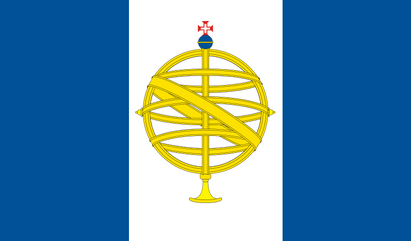
Flag (and Coat of Arms) of the Viceroyalty of Brazil. Although it was a colony de jure, Brazil had enough political autonomy to be considered a protectorate or, in some aspects, an independent nation
From 1530, with the loss of its monopoly on the East Indian trade and with foreign incursions into their colonies, Portugal decided to take possession of its South American land definitely. Until then Brazil was populated by people from all over Europe and a large Jewish community, had a lot of economic freedom and marketed with whom wanted.
Portugal produced a design that would make Brazil profitable for the Crown and was based in big slave based sugar latifundia, and the restriction of freedoms. But Angelo de Medici, who with his contacts discovered the project. He called the Congress of Olinda, bringing together elected representatives from all the municipal chambers of Brazil. At the Congress, they prepared a document, with appeals from all classes in Brazil. The document became known as Holy Charter of Rights and defended the interests of the colony inhabitants. In Lisbon, Angelo and his entourage used his influence and intimacy with the king to persuade him to sign the document saying that otherwise, the settlers could revolt, being aided by Portugal's enemies, like Spain or France. Trying to reconcile the interests of Brazilians with the colonization model that Portugal wanted to impose, the letter set out the rights and duties of the settlers. The Charter was negotiated with the king, who put in it some articles that would preserve Portugal's interests:
- In the colony, all Christians and Jews would be free to exercise their religion, which unobtrusively included Protestants who would appear soon, and the colony would be a neutral zone between the religions;
- the settlers would be free to exercise any economic activities without restrictions of the Crown;
- trade with other countries might happen since only Portuguese and Brazilian ships could dock in colonial ports freely (actually, in the long run, it was favorable to the Brazilians, who were able to control all of their trade, exportation and importation);
- sugar and Brazil wood would be exported only to the metropolis and by metropolitan ships;
- the slave trade to the colony could only be done by the Portuguese, although Brazilians could traffic to other regions of the world;
- all the gold, silver and diamonds discovered in the colony would be subject to the Crown laws;
- all non-Portuguese settlers installed in the colony would have the right to stay in Brazil, in addition, European of any nationality could be established in the colony;
- cities and towns would be governed by prefects elected by its people in a secret ballot;
- part of the taxes (a fifth, known as the Crown's fifth) collected in the colony would belong to the Crown, the rest of it would be kept in the colony for the construction and maintenance of infrastructure and government;
- there would be freedom of expression and of the press;
- a central government based in the legislature known as the Magisterium, would be created as the main government to the whole colony, but the captaincies possess certain autonomy, and the Magisterium could legislate about all issues under the Charter;
- at least half of the positions of power in the colonial government would be occupied by native Brazilians from 1620; Brazilians would be entitled to representation in the Cortes of Lisbon from 1620 and could trade in all of the Portuguese Empire;
- education would be secular and under the authority of the Magisterium, in accordance with the religious neutrality of Brazil, but there could be the teaching theology and other subjects linked to the Church;
- There would be created a Colonial Self-Defense Force (CSDF), which became known as the Defense Forces, a group of army and navy recruited in the colony that would be under the authority of the Magisterium, in order to protect the colony from enemies of Portugal;
- the document should be honored by all that to reign in Portugal.
The Holy Charter, signed and ratified by King John III in 1538, regulated the colony condition in relation to the metropolis and allowed to maintain the growth of New Florence and the Medici. The Portuguese monarchs, although wanting, never attempted to reduce that condition because they knew that this would mean revolt. But more freedom generated more trade, which generated more tax revenue and made Portugal think that trying to destroy this freedom would be endangering a rich source of foreign exchange for a domination that could not yield the same profits. For Portugal, all this freedom allowed the Brazilians show their true potential and fill the royal coffers. On the other hand, Brazil had a continuous economic growth since its discovery and until its independence. Differently of other European colonies, Brazil had no mean to become independent until 1819, "a good marriage does not end in divorce", it is said.
Started in 1548 with the installation of the sugar enterprise and the foundation of the Magisterium, the Magisterial Period begins creating the society that would lead to the question posed in the 20th century by the British historian William J. McLeod: "Was Brazil an exploitation or a settler colony?". Historians say both, a mixture, a colony that had great economic and social freedom, typical of settler colonies, and knew how to use this freedom without, however, fail to give the metropolis the expected profits of an exploitation colony. Brazil was a unique case in history. The Holy Charter of Rights was what kept its freedom, no king in Portugal, from any dynasties, dared to question it until 1821. It kept secured and formalized property rights and representative government disengaged from the Church, freedom of thought and enterprise, and freedom of knowledge and scientific development also disengaged from the Church. Most historians agree that the Charter was one of the most important elements in the political and economic development of Brazil.
The Charter gave contribution to what is known as Brazilian Law, a legal system that was settled in the colonial period and had influenced the current Civil Law system in Brazil and Paraguay, as so in Madagascar, Singapore, The United Arab Emirates and other Brazilian ex-colonies. The Charter had also influenced the Enlightenment ideal and, more directly, the Declaration of Independence and the Constitution of the United States.
The Colonial Administration
Until 1548 the colonial administration was very fragmented, each city or town was governed by a prefect and a board of councilors elected by the people, but with the promulgation of a central government, some things have changed.
The government installed in the colony was based on a Viceroyalty, a self-governing colony divided into several provinces with broad powers of self-government, but connected to a central government. The provinces were heirs of the Captaincies system that involved the division of land, donated to the Donatory Captains that were be responsible for its control and development, and for paying the settlement expenses. They were donated people who possessed financial means to colonize, which were mainly "members of the state bureaucracy" and "military and browsers linked to the conquest of India", but as few of these showed interest, an then these lands were donated to rich already resident in the colony.
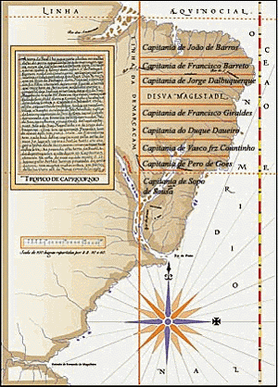
The Captaincies.
There was created in this division, fifteen longitudinal bands of different widths ranging from landforms on the coast to the meridian of Tordesillas, and were offered to twelve grantees including Giuliano de Medici in Ilheus, Afonso Duarte in Pernambuco, Antonio Henriques de Sousa in Saint Vincent and Caius Voulgaris in Santa Sofia. After becoming provinces, their government was as miniatures of the Viceroyalty. Some donatory families, such as the Medicis of Ilheus and the Vougaris of Santa Sofia, became very influential in their captaincies policy to the point of controlling the construction of cities, tax collection and distribution of land, and maintained such influence when the captaincies became provinces. Among the donatory families would also be distributed by the king, even in the 16th century, the first hereditary noble titles of Brazil as the Duke of Ilheus, 1512, Count of Heraklion, 1543, and Baron of Laguna, 1567. But unlike Europe, in Brazil, a noblemen had not guaranteed a state pension. Most of the noble houses of Brazil were formed by wealthy merchants, large landowners and businessmen. With the rise of Brazil as a united kingdom to Portugal in 1815, Brazilian nobles, until then officially considered part of the Portuguese nobility, though despised by the Portuguese nobles, became officially nobles of the Kingdom of Brazil.
Of the 16 original captaincies, 13 prospered, mainly financed by the capital of the Medici Bank, including: Ilheus with trade and industry; Pernambuco with the sugar and trade; São Vicente as the granary of the colony; where were produced rice, potato, beans, cassava, onions, peas, potatoes, honey, dried fruit and sorghum to sell to other regions and was farmed donkeys, horses and oxen; and Santa Sofia, as the largest supplier of construction materials.
There were also settlements west of the Tordesillas line, including Manaus, Aphrodisia and others. These were ignored by the Spanish, who were concerned with richer areas until the end of the 17th century
Brazilian land was two-month trip from Portugal, the news of the new lands were not very encouraging: on the trip, but the fear of "monsters" that inhabit the ocean (in European superstition), storms were frequent; in the new lands, massive and impenetrable forests, man-eating people and there was no mineral wealth yet discovered, it was that many Portuguese nobles who received captaincies did not come to the colony, which led the Crown to donate their land in Brazil to residents in the colony as the Greek-Portuguese Caio Vougaris.
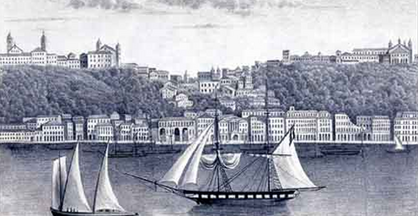
Salvador, 1650. It was the capital of Brazil until 1763.
In 1536 came to Brazil the donatory of the Captaincy of the Bay of All Saints (Portuguese: Baía de Todos os Santos), Francisco Pereira Coutinho, who founded the city of Salvador. In 1548 King John III unified the captaincies (now provinces) under the long-awaited Viceroyalty government. In this system, the colony became a Viceroyalty, ruled by a Viceroy appointed by the Crown and a Chancellor elected among the members of the Magisterium, a requirement of the Charter. The power was also exercised by the Intendents of which, from 1620, two-thirds had to be born in the colony. They were appointed by the viceroy, but must be accepted by the Magisterium. There were many Intendancies (lie ministries or departments of state), including the Intendecies of Commerce, Defense, Exploration, Transportation and Infrastructure, Tax, Education, Colonization and also of Mining. At least half of the taxes collected in the colony was kept in the colony to maintain the machinery of government and public infrastructure. The other half was destined to Crown.
The Magisterium was a kind of parliament. Chaired by magistrates elected by the people, it had the job of overseeing the viceroy, create laws and government measures, and had the power of veto over the actions of the Viceroy and intendents. The first viceroy was Mem de Sá, who came to Salvador to make it the capital of Brazil. Mem de Sá ruled until death and was responsible for the political unification of Colonial Brazil. Over time the power of the Magisterium has grown until the viceroy became, de facto, merely an illustrative figure. The Viceroyalty existed in Brazil until 1815 when King John VI, already in Brazil, raised Brazil to united kingdom to Portugal. It acted as an independent government, as a protectorate, not burdening the Portuguese state machine and still paying dividends. Scholars confirm that Brazil was perhaps the most free and independent European colony in the Americas. One of the first policies of the Magisterium, was to unificate the colony's monetary system. It stablished the Brazilian Reserve Bank in 1551, a public institution which were responsible to manage the state's currency, money supply, and interest rates. It was the first central bank created, which is the current Bank of Brazil (the Brazilian central bank), and it is the model on which most modern central banks have been based. In 1555, it started to manufacture the new official curency, Real, which has been used in Brazil until nowadays, being one of the oldest currencies still in use.
The first settlers in Brazil were Catholics and Jews that aimed to rebuild their lives in the new lands. From the mid-16th century, waves of Protestants also came to Brazil fleeing persecution, including a large contingent of French Huguenots and also Calvinists, Presbyterians, Puritans, and Lutherans. In addition to these, in the region of the province of Santa Sofia there was a great migration of Greek, Russian, French and Italians. The Cathedral of St. George in Heraclion, built in 1651, in a unique architectural style that became known as Heraclian style, it is the largest Orthodox temple in the world. During the Magisterial Period the Brazilian population grew too fast. Between 1500 and 1700, it is estimated that 750,000 Portuguese left their country to build a new life in Brazil. Added to these, over two million Europeans of other nationalities. European immigration to Brazil was very broad. Portuguese, Spanish, English, Scottish, German, Italian and Scandinavian spread their populated areas throughout the colony. Other people emigrated to more restricted areas, such as Russian and Greek in Santa Sofia and Espírito Santo, Irish in São Paulo, and Polish and Hungarians in Rio de Janeiro, Paraná and Santa Catarina. Brazil's population grew during this period. In 1550: there were 650,000; in 1650: 2.7 million; in 1700: 4.5 million.
The colony economy would became incredibly diverse between 1548 and 1701, textile, metallurgy, naval, weapons, and processing manufactures grew incredibly. The sugar production yields great profits to the metropolis, Brazilian traders are all over the world, its banks are full of money, especially the Medici Bank. Brazil has become one of the major arms suppliers to the metropolis, and the large latifundia buy African slaves from the Portuguese. Hundreds of thousands of slaves were trafficked to Brazil between 1530 and 1700.
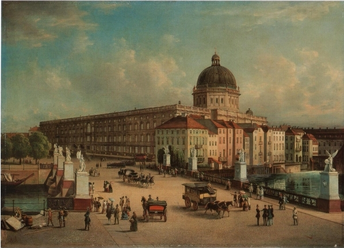
The Palace of the Ipês, headquarters of the COU. New Florence, 1669.
Great financier of the Spanish Crown, the Medici Bank becomes very rich with waves of gold and silver it receives from Spain as payment for their loans and financing. This situation gave rise to a joke of the day: "Gold is born in America, dies in Spain and is buried in Genoa and New Florence." Neverthless, New Florence had business in all the world, increased trade and large surplus in its transactions, ie, not dependent on Spain.
In 1570, Angelo of Medici founded the Overseas Trading Company (Portuguese: Companhia de Comércio do Ultramar, or just COU). The first multinational company in the history, the COU expanded during the late-16th and the 17th century to become the biggest company in the world. A de facto independent government headed in New Florence, the COU built a remarcable colonial and commercial empire, a powerful fleet, and influence to negotiate to the other Great Powers as an equal. It was responsible for the first Brazilan colonialism, being its colonies: the Free Cities, Madagascar, Terra Nova and Labrador and others. It did influence the diplomacy and the war in Europe and was de facto an independent and powerful imperial state.
The Iberian Union (1580-1640)
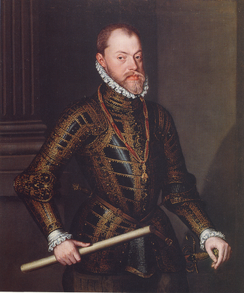
Philip II of Spain, I of Portugal
With the death of the young King Sebastian in battle, this known as The Alcazarquivir Disaster, the Portuguese throne was empty, and the young king had left no descendants.
Philip II of Spain was eventually recognized as king of Portugal, being the closest relative, 1581.
However, the idea of loss of independence led to a revolution under the leadership of the Prior of Crato, who had come to be proclaimed king a year earlier, in 1580, having fought to the end, coming to rule until 1583 with his court in Terceira island in the Azores.
Crato was eventually defeated, especially because of the support from the traditional nobility, the bourgeoisie and the Brazilians to Philip. To get support Philip undertook, in those courts, to maintain and respect the forums, customs and privileges of the Portuguese. The same happened to the occupants of all offices of central and local administration, as well as the troops of the garrisons and fleets of Guinea and India. Them were present all prosecutors of towns and cities in Portugal, except the Azores, faithful to the Prior of Crato, which resisted in Terceira. The Brazilian settlers also had their rights listed in the Charter of Rights held by Philip, in return for their recognition of him as king. It was the principle of a personal union aplied without major changes until about 1620, despite the English interventions of 1589 in the Azores.
During the so called Iberian Union, Philp's Dynasty formed one of the largest empires in history, comprising territories in almost all parts of the world.
Among the main beneficiaries in this case were the Brazilians, who won the asiento (monopoly) on the slave trade to Spanish America, and the right to trade with all Spanish dominions over the world, which expanded the Brazilian commercial networks. During the union, the Tordesillas line became useless, allowing to expeditions as the Bandeiras and the Monções, which expanded increasingly to the West looking for precious metals. That expansion also expanded the borders of Brazil and the area under the Magisterium administration to close as they are today.
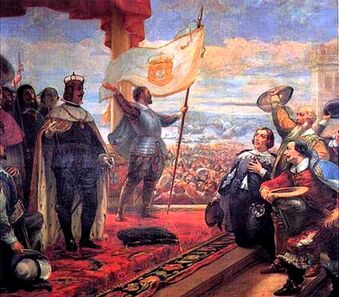
Proclamation of John IV as King of Portugal
Several exploratory expeditions to the interior were organized under direct orders of the Crown or paulistas (peoplo od the Province of São Paulo) gold hunters. These expeditions lasted for years and were intended primarily to find precious stones and valuable metals such as gold and silver. They were famous pioneers, among others, Fernao Dias Paes Leme, Bartolomeu Bueno da Silva (Anhanguera), Raposo Tavares, Domingos Jorge Velho, Borba Gato and Antonio Azevedo. Despite the political and economic importance of the Bandeiras to the Brazilian history, these expeditions were largely responsible for the extermination of indigenous peoples in Southern and Midwestern Brazil.
The Iberian Union ended in 1640 when the Portuguese Restoration led the Duke of Braganza to, with financial and military aid form the COU, took the throne. The reason for the restoration was the crisis caused by the wars of Spain, to Portugal's former allies, like England and the Netherlands, led them to attack its most distant domains. In exchange for the Brazilian help, the Duke swore that his dynasty would respect the Charter of Rights and increased the privileges of COU But even with the victory, in 1640 there was only a smal remnant of the once great Portuguese Empire: Brazil, Angola, Mozambique, Guinea Bissau, some islands in Africa, some trading posts in India, and Macau and Timor in Asia.
The Dutch Wars (1630-1654)
Marice of Nassau, governor of the Dutch Brazil between 1637 and 1642
Before the Iberian Union, Portugal and the Netherlands were great allies, the Dutch funded the sugar enterprise in Brazil, sugar sent to Portugal was sold to the Dutch, who refined it and laid it out for Europe. But the Natherlands was in a bloody war with Spain and Portugal when it was merged into the last, the Spanish king saw the ban on trade with the Dutch as a way to weak them. The war continued until the Dutch, realizing that only would come back to the sugar market if they conquer its producing areas. They instructed the newly established West India Company (WIC) to conquer the Portuguese dominions in America and West Africa. Despite failing in an attempt to occupy Salvador (capital of the colony) and New Florence, the Dutch defeated the Defense Force and conquered the coast of Pernambuco, less protected area and the largest sugar producer in 1630. Soon the invaders conquered a large coastal area that went from Alagoas to the northern Maranhão and establish their capital in Recife (small neighboring village of the current capital of Pernambuco, Olinda. Thanks to Governor Maurice of Nassau, the Dutch government was well regarded by the Pernambuco settlers. He creates a large infrastructure, urbanize and beautifies the new capital, Recife, keeps the civil rights of Brazilian citizens, besides being great patron of the arts. During the Dutch government, the WIC achievement Angola for the supply of slaves to the plantations is constant.
Nassau, known in Europe as "the Brazilian", became extremelly amazed to Brazil. Because of that, he was well seen by the pernambucans and extrapolating the WIC's interests to the region, he founded a "little Holland" in Brazil, bringing to the region many of European developments and political estructures. He decided to turn Recife a modern capital like any other on the Netherlands, a project he called Mauritsstad. He founded the Maurician University, parks, bridges, cannals, palaces, theaters, gardens and astronomical observatories. In 1642, Nassau was sent bac to Europe and a new and oppressive government was installed, bringing the remnant of the Dutch supporters to the Portuguese side.
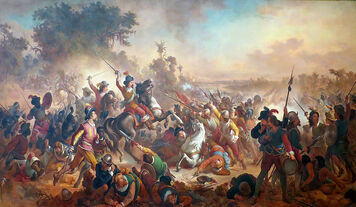
Battle of Guararapes, the last battle of the Dutch Invasions in Brazil
The war between Portugal and the Netherlands extended even after Portugal's independence from Spain. Without strength to regain their colony, Portugal was about to give up. But in 1654, in the so-called Last Flemish War, the Dutch were expelled from Brazil and Angola by the Defence Force and the belligerents sign peace. In the Treaty of The Hague, the Netherlands was indemnified in eight million florins, and received the Malabar, Portugal already received its colonies back with the promise that the Dutch will give up of them. As for the remaining supporters of the Dutch in Brazil, they were expelled from the colony. It is known that the larger community to migrate from Recife was of Jews who flee to North America, specifically New York, and many of their descendants actively participated in the American history.
Society and Science
During the Magisterial Period, freedom and economic prosperity allowed a breakthrough of science and philosophy. In 1569, the bahian Alvaro Correia Torres, published one of the masterpieces of world scientific press. The work: Analisis Naturalis Brasiliae, had 12 volumes with all the knowledge acquired so far about the Brazilian fauna and flora and its applications.
The same year, the newflorentine Manuel de Nobrega discovered a new metal, manganese, and created with it an alloy that made a more resistant, shiny and malleable steel. The newflorentine steel, wrought with a rather innovative technique at the time, became the most expensive steel and a luxurious product. Soon, swords, guns, and cannons of newflorentine steel were exported all over the world, generating sizeable profits to Brazilian traders, and boosting the metal industry in Brazil. Although it was the subject of detailed analysis by the Europeans and Chinese, the secret of its composition was only discovered in the 19th century, one hundred year after manganese was discovered in Europe. Other Brazilian products were also discovered at that time. The ollancelus (Latin: olam, pot, and caelum, the sky. Sky colored pot) was a form of pottery invented in Heraclion. It was adorned with relief sculptures, usually in sky blue color (hence the name). It became so valued as Chinese porcelain in Europe. It was also valued in China, where the elites spent considerable sums of silver to buy. Also at this time the fine propeline fabrics (made from Sertão flax) become valued in Europe, encouraging further its cultivation and manufacturing.
Meanwhile in 1597, the philosopher Carlota Medeiros wrote The Women Manifest where she defends her ideals of gender equality and women's real potential, using several famous examples in history. Although a heresy for the agrarian elites, the book was well accepted by the urban population, shaping the Brazilian mentality towards women. Her influence on the French 19th century sufragettes and her ideas immortalized Medeiros worldwide as the "Mother of Feminism."
Already in this period the press became widely present in colonial life. Already in 1580, there were at least 990 printers in the colony and more than 75 daily papers and periodicals.
Stimulated by the combination of freedom and the presence of foreign immigrants, Brazil had a cultural flowering period marked by the foundation of reading societies, discussion groups, bookstores, periodicals and scientific societies. Publishing and books, magazines and newspapers obtained supplies an expanded the market, thanks to the increasing of literacy rate. In Brazil the 17th century, the rate of literate of men was 70%, and women was 62%.
These changes paved the way for the entry of Enlightenment in the colony, and its flowering in between the late 17th century and the early 18th century.
Economy
Besides the sugar produced in large slave-based latifundia, Brazilian agriculture was diversified. The main agricultural products were cassava, maize and potato. In addition to these three main, there were tomatoes, lettuce, arugula, cucumber and carrots, tropical fruits such as mango, orange, tangerine, açaí, cupuaçu, coconut, banana, watermelon, passion fruit, lemon, regional fruits, and grapes and dates in the valley of the São Francisco river. In the South, especially near Laguna and in Rio Grande do Sul and Santa Catarina mountains, It was grown European and Asian fruits such as strawberry, raspberry, pear, apple, grape, peach, plum, and others. For industry, it was cultivated Sertão flax and vineyards in the valley of São Francisco, cotton in Maranhao, and jute, tobacco and cocoa in Bahia.
Livestock activity was based on cattle, rhea, sheep and horses, and buffalo exceptionally in Marajó Island. The regions of the São Francisco river and southern Brazil became major farmers of cattle and caravans (called tropeiros) traveled throughout the colony selling leather and jerked beef, and shipping to major settlements products from other regions.
There was in the colony an extractive activity. In the Amazon region, it was extracted backlands Sertão drugs, western spices like cinnamon stick, cloves, guaraná, indigo, vanilla, pepper, and ginger. From the mid-16th century, the natives from the Jesuit missions in the Amazon were responsible for the extraction of drugs and its transport to the villages on the banks of the Amazon river, where they were transported to Bethlehem (Belém do Pará). There, they were processed and exported to Europe. Also in the South, from the 17th century, the Jesuit expanded their missions. At the same time the infusion of mate mate, a native of the region, became appreciated by the ruling classes of the Ottoman Empire, the Arab kingdoms and Scandinavian countries such as Sweden and Denmark.
Soon the Jesuits began to have the same role in relation to mate herb, as they had with the Sertão drugs, carrying them to Porto Alegre and Florianópolis, where they were exported. These activities enabled the Society of Jesus to accumulate some wealth, and beautify their missions.
Also date from this period, 1650-1700, the first engineering works that would be known as Water Web, a set of navigation and irrigation canals and lakes constructed in the semi arid Sertão from São Francisco and Parnaíba river and water channeled from the Amazon basin, irrigating the dry, but fertile, land of the Northeastern Sertão.
A miracle of engineering, some canals cutting sierras in half. The canals pumped water from the lower regions to the higher Sertão using advanced systems of mills and the water level adjustment. This also enabled the development of an important waterway transport network in the major canals along the colonial period, connecting the Sertão economy.
The Water Web finished its last canal in 1833, but by then many lands had already been covered by the canal. The big Sertão Agripole, now one of the Brazilian regions most productive in agriculture. The Web canals started narrow, but they were quite expanded throughout the 19th and 20th centuries. The Web was also the inspiration for the vast network of irrigation canals built in Patagonia by the Free Cities in the 17th and 18th century.
Since the beginning of the colonization, one of the main rights guaranteed by the Holy Charter of Rights was the right of property. In the period 1530-1730, most European immigrants in Brazil colonized the fields. Based on small and medium-sized properties, these would have ownership of occupied land according to the Productive Occupation Act of 1561. The Act was created by the Magisterium in order to ensure the occupation of the colony and thus the recognition of Portuguese sovereignty by other nations, and to facilitate the obtaining of land and discourage the rampant expansion of the cities. It said that the occupants of the land would have its legal possession after a productive occupation period. The settlers, who worked the land with their families and produced a wide variety of products, should provide the colony marketing the surplus of thier production. The Agriculture School was created to teach the settlers to cultivate and use the native products such as cassava, maize, potato, etc. Roads were built to link the countryside to the cities and allow the exchange of goods between them, and the passage of colonial troops. During the Magisterial Period, the exchanges between farms and cities, or just between farms were frequent. The large contact between country and city allowed new techniques to be employed in productive land.
Slavery, the Quilombola Movement and the Protestants in Brazil
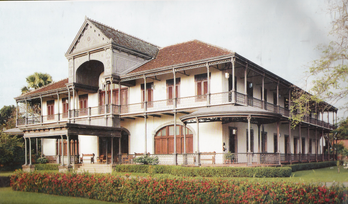
Typical house of a sugar plantation owner from the 17th century
Beyond the dynamic economy that prevailed in the colony, there was a "different economy" that was intended to satisfy the Portuguese interests, the cultivation of sugarcane and cocoa. Simultaneously with the settlement of immigrants on the fields, Portuguese imigrated to Brazil under the seal of the Crown. While immigrants had small and medium farms, the Portuguese honored by the king, the conquerors and explorers, gained sesmarias from the Crown, large portions of land (latifundia) to large-scale production of commercially valuable products. The sugar mill (manufacture of sugar production cycle and called engenho in Brazil) was the main part of the Portuguese mercantilism, organized into large plantations. These were characterized by extensive land, abundant slave labor, complex techniques and low productivity.
To support the production of sugarcane, the Portuguese began from the mid-16th century to import Africans as slaves. They were people caught between tribes of Africa (sometimes with the connivance of local chiefs from rival tribes) and crossed the Atlantic on slave ships, in terrible conditions of cleanliness and health. When they arrived in America, these people were marketed as a commodity and forced to work on plantations and its owners homes. Within farms, they lived imprisoned in rustic sheds called senzalas, and their children were also enslaved, perpetuating the situation for the following generations. Until the mid-16th century, the Portuguese had the monopoly of the slave trade. After that, French, Dutch and English merchants have also entered the business, weakening the Portuguese participation. Nevertheless, the Portuguese had the monopoly slave trade to Brazil.
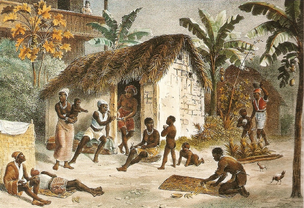
Typical senzala
Entering the 17th century, the Brazilian sugar was a luxurious product imported to the ports of Lisbon, Antwerp, Amsterdam, Rotterdam and Hamburg. Production, much higher than the Portuguese islands' in the Atlantic, supplied almost all of Europe.
In the mid-17th century, the sugar produced in the Netherlands Antilles began to compete strongly in Europe with sugar from Brazil. The Dutch had perfected the technique with the experience gained in Brazil after the Dutch Invasions, and counted with a developed transport and distribution of sugar scheme in Europe. Portugal was forced to turn to England and sign several treaties that would affect the economy of the colony. In 1661, Britain has pledged to defend Portugal and its colonies in exchange for two million crusados, still getting the possessions of Tangier and Mumbai. In 1703, Portugal has undertaken to admit the kingdom cloths of English wool, and England, in return, to buy Portuguese wines. Date of time the very famous Treaty of Methuen, or Treaty of Fabric and Wine. At the time, it met the interests of the dominant groups, but would result in the stoppage of industrialization in Portugal, channeling to England the gold that had just been discovered in Brazil.
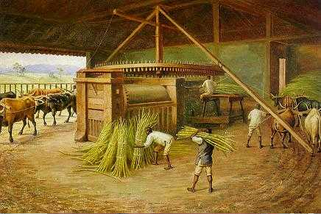
An engenho or sugar mill
The gradual decline of the sugar plantations in the 18th century further sapped the drain of the power maintained by the plantation owners. Other crops such as cocoa, tobacco and especially cotton, now represented an increasing share of production. Cotton fed the colonial textile manufacturing and was also exported to England. These changes have been consolidated in the early 18th century.
The issue of slavery in Brazil was very particular. Millions of slaves were transported to the New World between 1530 and 1860, but in Brazil interracial relations had a much higher level than any other European colony. In 1825, people of African descent or origin accounted for 43% of the population. Interracial relationships were common and many Brazilians were mixed. The slaves in Brazil had an easier time achieving freedom in North America, which also facilitated a greater volume of importation of slaves. And different from that region, here there was a real protection legislation to the captives. However, slavery in Brazil was still extremely brutal and inhuman.
In 1602, the Magisterium created a series of laws on slave labor, the Acts of Veraluna. Since, according to a magistrate of the time, slaves were "at the same time goods and men, they had duties of goods, but rights of men." The presence of slaves was banned in cities, except in predetermined areas and routes for sale, so that there were no impacts "to public order and decency"; the slave would be entitled to purchase his freedom at triple the price at which it was purchased; the slave could not be killed by his master, it would be considered murder; no more than 40 lashes were allowed as a punishment; slaves should be taught to read and write so they could "feed their souls of the revealed Word of our Lord and save their souls." Although in the present context may be deemed to offensive and racist, the Acts were almost subversive at the time.
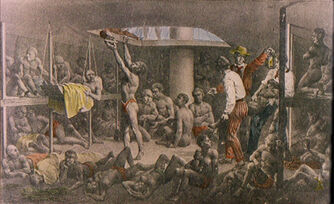
Africans in a slave ship
Many of these laws, called "sponge cake for gorillas" by the plantation owners, were imposed by the commercial and manufacturing elite that dominated the Magisterium between 1590 and 1710. Their interest in consumers for their products, cheap, but paid, laborers to consume, led them to facilitate the process of liberation from slavery, turning the slave a consumer and paid worker. This constant flow of freed slaves also benefited the Portuguese slaves traders, which supplied the high demand of new captives, and led them to support this policy. As for the plantation owners (called sertanos in by people of the cities and owners of small and medium properties), the situation forced them to allocate large funds to buy new slaves constantly, disrupting any economic supremacy that rural elites wished to have on the urban elites.
This situation did not come without consequences. The Revolt of the Engenhos (1622) and the War of Sertanos (1641) were conflicts between rural elites with their militias and the colonial government. At first, the plantation owners were defeated and forced to dismantle their militia; in the second, the Magisterium promised freedom to slaves who fought against the insurgents. After the War of Sertanos, the last great revolt of the rural elite in Brazil, slaves loyal to the Magisterium were freed, the Magisterium heavily fined the insurgents, buying part of their land in exchange for financial aid.
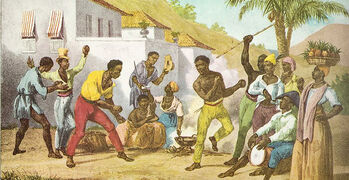
Slaves dancing. Much of Brazilian culture came from the slaved Africans. As the Mixed Nation it is, it is said that Brazil "has its body in America, its head in Europe, and its soul in Africa."
Although similar revolts have occurred at the time, the aforementioned episodes mark the end of the influence of rural elites in Brazilian politics until the Coffee Cycle.
On the issue of slavery in Brazil, this would still be much discussed. Frederico Domenico (1654-1731) was one of the biggest abolitionist philosophers with his Children of Men, which defended the slaves, analised the social and economic effects of slavery and discussed the ethics of the institution; the work was widely accepted in the cities and among medium and small owners. Already an important slaver of the time would be Antonio Monteiro de Melo (1637-1712), in his Pyramid of Races, he defended the theory of a racial pyramid, in which some races were superior to the other and they were below should hold the upper.
African culture had also influenced Brazilian culture very much. As miscegenation was neither encouraged nor discouraged, as occurred in North America, mixed families were common among the lower and middle classes and concubinage among the plantation owners. The color prejudice, although very present and visible, was not as intense as elsewhere. Some members of the Magisterium had black or mixed wives, and others were black or mixed themselves. The Brazilian title of "Mixed Nation", is not given for nothing.
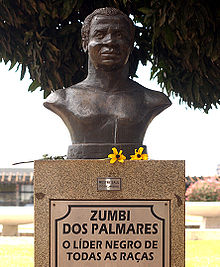
Statue of Zumbi, in Palmares, AL. It is wrote: Zumbi of Palmares. The Black leader of all races.
However, the slavery were still a brutal institution in Brazil and many slaves tried to revolt or run to quilombos. Refuges of runaway slaves, quilombos were important centers of African cultural reaffirmation in Brazil. Generally they had governments that mirrored the traditional African societies. Not just black people, like all types of "undesirable" migrated to the quilombos.
The biggest was Palmares, a real state established in the Brazilian Northeast. Surviving form hunting, fishing, gathering, trade and crafts, Palmares remained standing during part of the 18th century even after raids of the Defense Force. The so-called War of Palmares was the biggest conflict between the quilombo and the Magisterium, between 1693 and 1695, and ends the movement, with the death of its leader Zumbi. Although relatively Palmares short lived as a state, as a long revolt movement, the Quilombola Movement led the Magisterium to strengthen legislation and supervision relating to slavery. The movement, by the violence of Slave Revolt of New Manchester in 1687, and its repression even more violent by the plantation owners, took several Brazilians to discuss the validity of the slavery and its ethical value.
One of the main aspects of the slavery in Brazil, differing from the other American nations, was the presence of a strong opposition against it. In Brazil, anti-slavery and anti-racist sentiments began to grow, surprisingly, after the arrival of the first Protestants in Brazil.
Protestantism came to Brazil early, in the 1520s and 1530s, brought by Lutherans from Germany and Scandinavia. The Holy Charter of Rights provided freedom of religion to all Christians and Jews. That was an important factor of the Charter and was inserted to guarantee the rights of the Orthodox Christians of Santa Sofia and the Jews throughout the colony, who had great economic power. With the Reformation in Europe in the 16th century and the conflicts between Catholics and Protestants, that specific article of the Charter became a concerning issue. As said by the magistrate Marcelo Dumont de Melo, in 1619:
| "The Charter is clear: All Christians and Jews are free to have their beliefs, to build temples and to prozelitize. We already have non-Catholic Christian communities in our land [the Orthodox Christians from the Brazilian Orthodox Church], a respectfull and honorable people. I propose the same to the new denominations [Protestants] that are coming from Europe. If not for the sake of our laws and of freedom, then for the sake of peace." |
That way, the Magisterium passed the Dumont de Melo Act, that recognized the Protestant denominations as Christians under the Holy Charter and prohibited all conflicts, contributing to the sense of religious plurarity and secularity of the state that became so intrinsicaly Brazilian.
| "As faith is the free work of the Holy Ghost, it cannot be forced on a person. Therefore, strict separation of church and state has to be kept and no group under the Bible shaw be persecuted or treated as different to the Law and the State regarding his or her belief, or lack of it" |
Brazil became a refuge to Protestants from Europe. Hugenots, Lutherans, Calvinists, Presbyterians, all of them came to Brazil in great amount.
During the early 17th century, Protestant denominations grew in Brazil, and some were even born in the colony. Within the Lutheran Church in the New World, founded in 1589, the leaders Marcus Mauro and Josias Coelho successfully persuaded their fellow members to free their slaves, divest from the slave trade, and create unified policies against slavery. By the end of the 18th century, the church was one of the largest in Brazil, and its leaders' anti-slavery and anti-racist speeches in all the Ecumenical Congresses influenced much of the Brazilian population.
Their influence made possible laws like the Act of Veraluna. By the mid-17th century, slavery was prohibited in the cities and any non-latifundio land, and institutional racism was prohibited in all instancies of government, as free Blacks were allowed to vote and had all political rights as Whites.
Of course, racism wasn't erradicated. However, the view of the imorality of slavery became widespread in Brazil, mainly in the cities and the small- and medium-sized rural properties. Even, slavery was maintained in the latifundia, as these were responsible by providing the metropolis with its main export products, such as sugar.
Japanese Diaspora, the First Japanese Wave to Brazil
Overseas Japanese have existed since the 15th century.
After the Portuguese first made contact with Japan in 1543, a large scale of slave trade developed in which Portuguese purchased Japanese as slaves in Japan and sold them to various locations overseas, including Portugal itself, throughout the sixteenth and seventeenth centuries. Many documents mention the large slave trade along with protests against the enslavement of Japanese. Japanese slaves are believed to be the first of their nation to end up in Europe, and the Portuguese purchased large amounts of Japanese slave girls to bring to Portugal for sexual purposes, as noted by the Church in 1555. King Sebastian feared that it was having a negative effect on Catholic proselytization since the slave trade in Japanese was growing to massive proportions, so he commanded that it be banned in 1571. In 1595 a law was passed by Portugal banning the selling and buying of Chinese and Japanese slaves.
From the 15th through the early 17th century, Japanese seafarers traveled to China and Southeast Asia countries, in some cases establishing early Japantowns. This activity ended in the 1640s, when the Tokugawa shogunate imposed maritime restrictions which forbade Japanese from leaving the country, and from returning if they were already abroad. This policy would not be lifted for over two hundred years.
Before that, Cristianity spread throughout Japan, creating social tension and riots like the Shimabara Rebellion. Under Hideyoshi and the succeeding Tokugawa shogunate, Catholic Christianity was repressed and adherents were persecuted. During these times, many Christians were killed in Japan, some by crucifixion; most famously, the twenty-six martyrs of Japan were tortured and crucified on crosses outside Nagasaki to discourage Christianity in 1597. Following a brief respite as Tokugawa Ieyasu rose to power and pursued trade with the Portuguese powers, there were further persecutions and martyrdoms in 1613, 1630, and 1632.
Because of that, Portugal secretly gave asylum to thousands of Japanese Christians in Brazil between 1542 and 1640. The Magisterial government maintained detailed records of Japanese immigration and its known that about 130,000 Japanese immigrated to Brazil. People of all classes, from nobles to peasants, they brought with them their customs, architecture, techniques and even clothing. The Japanese settlers integrated with the already multicultural Brazilian society. The city of Nishijima, Espírito Santo's biggest city, was founded by the Japanese, being known as "the Most Japanese of the Western Cities". The Japanese built churches using their native techniques and architecture, they integrated with the politics in the colony, but maintained their Japanese names with pride. Two of the Brazilian Noble Houses, the Okazaki (岡崎家) and the Nagatani (長谷家), are descendants from Japanese nobles converted to Christianity.
Differently from the Second Japanese Wave (1885-1935), which brought Shinto to Brazil, the First Wave Japanese were made of only Christian converts.
The Mining Period (1702-1808)
At the end of the 17th century it was discovered gold in the rivers of some land belonging to the province of São Paulo, which later became known as Minas Gerais. There were discovered later, at the end of the 1720s, diamond and other precious gems. When ran out the abundant gold in the streams, it became more painfully sought in veins within the earth. There appeared precious metals in Goyáz and Mato Grosso, in the 18th century. The Crown charged, as a tribute, a fifth of all mined ore, which became known as "the fifth". Deviations and gold trafficking, however, were frequent. To restrain them, the Crown, who had authority over the mining legislation advocated by the Holy Charter of Rights, introduced a whole bureaucracy and control mechanisms. When the sum of taxes paid did not reach an established minimum quota, the settlers should hand jewelry and personal property to complete the stipulated amount (episodes called derramas).
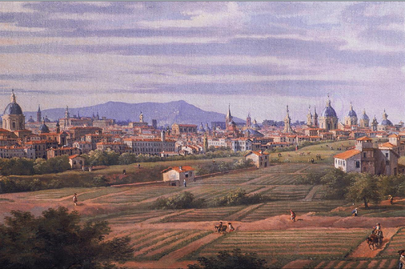
Mariana, the most populous city of Minas Gerais at the time, 1798.
The period known as Gold Cycle allowed the internal market to further expand, as there was demand for all kinds of products to the population of Minas Gerais. It was necessary to bring there, slaves and tools, the herds of cattle to feed the true crowd that flocked there. In general, the population of the mining regions only concerned with mining, don't concerning to food production. Therefore, other regions occupied this space in the production, moving the domestic economy. The North and Northeast mainly supplied slaves, cattle, wine and propelina and cotton fabrics. The South also provided livestock for food and animal transport, as well as dried fruits, wine and liquors. The caravans coming from South were instrumental in the development of the mining economy; they carried gold from the mines to the Southeastern ports such as Rio de Janeiro, and took the goods from the region to the mines, traveling through the various roads built by the colonial government. The Southeast was very important for several reasons: because it provided the most diverse food and manufactured goods to the region of the mines and because it was in this area that have structured various landings and stops for drovers, which gave rise to cities like, Campanha, Pouso Alegre, Passos and Bicas.
The population of Minas Gerais quickly became the largest in Brazil. Of the two million Portuguese living in Portugal at the time, about 500,000 migrated to Brazil, and more than 600,000 Europeans of other nationalities among English, Scottish, French, Italian, German, Danish and Swedish. The Brazilian population jumped to more than 7.6 million in 1770.
At this time, a big portion of the population of Minas Gerais, approximately 48% was made up of blacks and mixed. The white population was formed largely by people from the north of Portugal and Azores and Madeira, Europeans of other nationalities, and Brazilians from other parts of Brazil. They were very important in colonial trade, especially in the villages around Ouro Preto (currently known as Vila Rica) and Mariana.
In mining regions it was formed a complex urban network connected by a large number of roads. Cities like Vila Boa (Goyáz), Cuiabá, São João del Rei, Florianopolis, Sabará, Mariana, Diamantina, Campo Grande and Vila Rica (Ouro Preto), have become major urban centers. In Minas Gerais, there was a predominant artistic and architectural style that became known as "Mineiro Baroque", which the greatest exponent was the artist Aleijadinho.
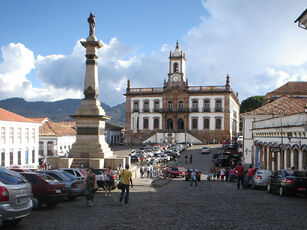
Ouro Preto, MG. The city was one of the cultural and economic centers of Brazil during the Mining Period
The living conditions of slaves in the mining region were particularly difficult. They worked all day standing, with curved back and legs under water, or in tunnels dug in the hills, where it was common to occur landslides and deaths.
Mining promoted the internalization phenomenon of the population in the south-central region of Brazil that until then had never been as strong as in the Northeast, and the change of colonial economic core from Northeast to Southeast. The industry, of which 70% were located in the Northeast, and trade began to develop the greatly in the region and at the beginning of the 19th century, the Southeast was the great industrial center of Brazil and the Americas. Gold and diamonds brought urbanization into the Brazil, the mining areas, then under the control of the Province of São Paulo, were dismembered and became the provinces of Minas Gerais, Goyaz and Mato Grosso. Also Paraná and Santa Catarina shortly after.
Even with all this wealth, with the luxury of the upper classes and the large and ostentatious public works, Portugal remained with a poor economy. This was due to its trade policy and agreements like the Treaty of Methuen, signed with Britain in 1703. According to this treaty, Portugal would buy the English fabrics and sell to England wine, this was very disadvantageous to Portugal and, along with the wasteful Crown, which were not worried about the tomorrow, it led to destruction of the Portuguese manufacturing and the great Brazilian gold flow that after extracted, just passed through Portugal, rebounding in the British coffers.
The Pombaline Reformation
The Marquis of Pombal
Sebastião José de Carvalho e Melo, the Marquis de Pombal, was a Portuguese politician and most representative of enlightened despotism in Portugal. He won the king's José I confidence by rebuilding Lisbon after the earthquake of 1755, becoming his Prime Minister. He has undertaken many reforms in order to modernize the stagnant Portuguese economy. An ambitious program of reforms sought to increase domestic production in relation to foreign competition, develop the colonial trade and encourage the development of manufacturing. Under this policy he did not hesitate to impose monopolies crushing internal competition. Thus, in 1753 it was founded the Company of Commerce of Portuguese Asia (of short duration) and, in 1756, the Company for Agriculture of the Upper Douro Vineyards, to which the Minister has granted tax exemption on trade and exports, thus establishing the first wine production demarcated region in the world, placing the famous pombaline landmarks in the region's boundaries.
He expelled the Jesuits from the metropolis and colonies, confiscating their property on the grounds that the Society of Jesus acted as an autonomous power within the Portuguese State. He also decreased the power of the Church, subordinating the Inquisition to the State.
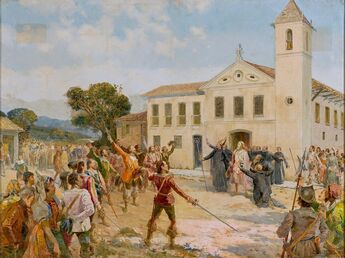
Expulsion of the Jesuits
Education in Portugal until then had been dominated almost exclusively by the Society of Jesus and other congregations. In 1759, with the Pombaline reform the Jesuits were expelled from all Portuguese territory and education has become the duty of the State. In Brazil, however, this measure had little effect on education, it was all governed by the Magisterium.
Pombal introduced, likewise, important changes in the Portuguese state apparatus. The creation of the first compilations of civil law, which thus replaced the canon law, represented the first step toward the affirmation of Pombal as a statesman and the state as superior entity and autonomous with the rest of society, including to the Catholic Church itself. In fact, the Portuguese state ruled several times at odds with the Holy See, cutting diplomatic relations until the death of José I and later ascension to the throne of Queen Maria I.
In Brazil, major changes occurred in the political and administrative level. In 1763, the headquarters of the colony was moved from Salvador to Rio de Janeiro, whose growth signaled the displacement of the colony economic core from the Northeast to the South-Central region. The change is due to the fact that Rio de Janeiro was the port through which the gold of Minas Gerais was drained to better supervise the mining activity and facilitate the control of the southern border, that grew to the border with Uruguay.
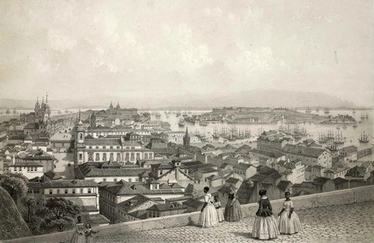
Rio de Janeiro, 1763
He sought to give greater cultural uniformity to the colony, prohibiting the use of Nheengatu (a mixture of native languages with Portuguese, spoken by some paulistas) and making the use of the Portuguese language. Some scholars of history say was this measure that Brazil left the course to be a bilingual country.
In the Amazon region, used to use indigenous slavery in large latifundia. However, unlike the settlers, the Jesuits obtained the voluntary co\operation of the natives. So while the missions prospered, the villages of settlers faced numerous difficulties. The expulsion of the Jesuits led to the breakdown of the Sertão drugs collecting economy, causing a long period of economic stagnation in several regions of the Amazon, surpassed only in the early 19th century with the measures of King John VI to increase the Amazonian economy.
Territorial Expansion
The Treaty of Utretch (1713), was an agreement that ended the War of Spanish Succession (1701-1714), in which the interests of almost all the major European powers were involved. On one side were France and Spain, and the other the Grand Alliance, formed by England, Holland, Portugal, Prussia, the COU and the House of Savoy.
This treaty was very important to the history of Brazil, as it recognized Portugal's possession over the lands colonized in the western side of the Tordesillas line, increasing the territory of Brazil. Also it gave COU some strategic ports in India, the right to freely explore the amber deposits in Mexico and Hispaniola, and sovereignty over the Spanish cities of Cadiz and Ceuta.
The Enlightment in Brazil

Dinis Duval
One of the centers of Enlightenment in the world, though not as important as France, Britain and the United States, Brazil gave rise to many thinkers and ideas that influenced the thinking of the time.
Dinis Duval (1692-1757) is considered the first Brazilian Enlightenment thinker. From Heraclion, he was the author of major works as HyBrazilis and Hispaniola which analyzed the processes of colonization in each colonies. He advocated the incorporation of the Iberian colonies as integral parts of their metropolis, and not mere sources of products.
Gaius Mello (1719-1803) created the modern concept of constitutional monarchy and defended the exercise of citizenship by the people. He attended the signing of the American Declaration of Independence. His major work is The World of Men which discloses his Declaration of Natural Rights, which would be republished and made official in Napoleonic France as the Universal Human Rights.
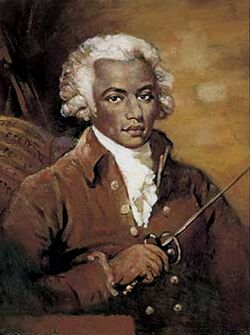
Gaius Mello
Tomás Castelli (1762-1847) was considered one of the greatest astronomers, physicists and economists of the Brazilian Enlightenment. He discovered the effects the moon on the Earth and its seas, he explained the functioning of the economy in central countries and colonies and their effects on society, and theorized economic systems, including a "proto-socialism."
Another major line of thought emerged in Brazil by Luis de Nantes (1723-1796), in his exaltation of Brazilian natural beauty, he disclosed his ecological science. More an art than a science until the 20th century, Ecology aimed seize the land and resources and spread the "natural love." Parks, ecological reserves, interest in the study of natural substances, Ecology encompassed those aspects of science and art. Already in 1860, the ecological ideas were widespread in national politics. The development of the natural sciences would occur on a large scale, the arts exalt nature as the romantic hero of that time, and planners would aim to increasingly transfer the beauties of the countryside to the cities. Ecologist view of Nantes influence the naturalists of the late 19th and 20th century.
The Mineira and Bahian Conjurations
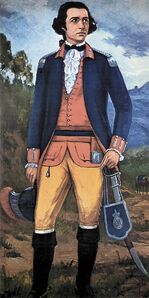
Tiradentes
Dissatisfaction of the society of Minas Gerais in relation to the Metropolis was getting worse, the heavy taxes suffocated the population, and when the gold quota was not reached, the derrama occurred, the seizure of people's property to reach the quota. This angered the population, mainly because gold deposits were depleted and Portugal did not lower the quota. That situation, would make Minas Gerais the first region of Brazil to claim for independence.
In late 1788, members of the elite of Minas Gerais gathered to promote a movement against the Crown. The American Revolution and the Enlightenment ideals widespread in Europe and Brazil served as a stimulus to the citizens dissatisfied with the colonial government. Relying on the general dissatisfaction of the mineiro people and with the support of the military, the revolt was scheduled for February 1789. The Lieutenant Joaquim Jose da Silva Xavier, known as Tiradentes (Portuguese: tooth puller, he was dentist), was in charge of holding the governor and start the uprising.
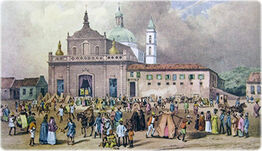
Bahian Conjuration, Salvador, BA
The plans of however, however, were denounced by a traitor, 34 conspirators were arrested, of which ten were sentenced to death, but only Tiradentes was executed on April 21, 1792, his body quartered and exposed in Villa Rica. Today, he is a national hero and martyr in the fight against Portugal. The capital of Minas Gerais was transferred from Villa Rica to Mariana soon after.
Another revolt in the period was the Bahian Conjuration, which occurred in 1798, also known as Conspiracy of the Tailors, for attending several tailors. Unlike the mineiro conspirators, however, most of the Bahian conspirators were poor. Little they had to do, because the Bahian government arrested more than 20 conspirators who, with the exception of members of the elite who were spared, were hanged, imprisoned and banished.
The End of Mining
After the mining cycle, the economy returned to its original state. A minority among the miners had enriched with their activities and, seeing the depletion of deposits, they began to invest in financial and manufacturing activities; powerful banks emerged, as well as industrial establishments. The abundant deposits of iron and saltpeter in the region allowed a great development of the war and metallurgical industries. Agriculture in small and medium farms was expanding and slavery was decreasing.
In the Northeast, even during mining, the cotton cultivation in medium properties florished. In Maranhao, the largest producer, large industries of cotton fabrics emerged. The cotton produced was sold to other regions and thus to England, that was also entering its Industrial Revolution. But in the early 19th century, the competition of USA cotton made Brazilian cotton lose ground in the international market, making the entire production be consumed domestically in the textile industries of the Northeast and Southeast.
Industrialization
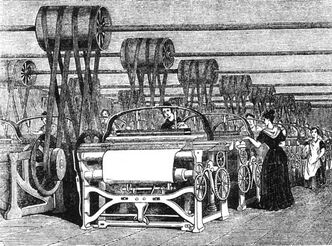
Brazilian textile industry during the early 19th century
The industrialization process in Brazil began almost as early as in England. This process was favored by several factors, including: the dominance of a liberal economic policy, leading to the development of trade and industry; the accumulation of capital by the Brazilian bourgeoisie, which allowed investment in factories and mines and the purchase of industrial machinery; the abundance of raw materials; the large Brazilian commercial network, which allowed products of distant regions of the world to be acquired, such as silk; low taxation and an organized infrastructure, with paved roads, bridges and waterways; and the fact that cost of living in Brazil was lower than in Europe, allowing factory owners to hire workers at low wages. Other factors were more subtle, such as the open environment conducive to innovation, which allowed the Brazilians to create new techniques and assimilate foreign ones, mainly from England, taking as an example the English invention of the steam engine that was assimilated to Brazilian factories only ten years after being in England. It would take only three years for the Brazilians copy Watt's steam engine, 1775. The Brazilians had the advantage to grow their own cotton, but as disadvantage as their low production of coal, and of poor quality, in Santa Catarina. Occupying that vacuum, the Africa Coal Company and other would became rich by mining and bringing coal from Angola and Madagascar to Brazil.
The first true Brazilian industrial cotton weaving, equipped with steam engines, began its activity in 1778 in Saint Louis, Maranhão.
Industrialization has profoundly altered the worker's living conditions, initially triggering an intense displacement of the rural population to the cities, in addition to former slaves, creating enormous conurbations. The population of Rio de Janeiro went from 200,000 in 1790 to over two million in 1890, for example. At the beginning of the Industrial Revolution, the workers lived in terrible conditions of life and work. The environment of the factories was unhealthy, as well as the slums where many workers lived. The working hours amounted to 80 hours per week, and wages ranged around four times the subsistence level. For women and children subjected to the same number of hours and the same working conditions, wages were even lower.
Up to 1800, Brazilian industrial networks were concentrated mainly in a few cities in the Northeast and Southeast, with Recife, Rio de Janeiro, Salvador, Curitiba, New Florence, Saint Louis and São João del Rey as main production centers. Since then the industrial activity expanded to other regions and the interior, reaching cities such as Niteroi, Vitoria and Porto Alegre.
The Courtese Period (1808-1821)
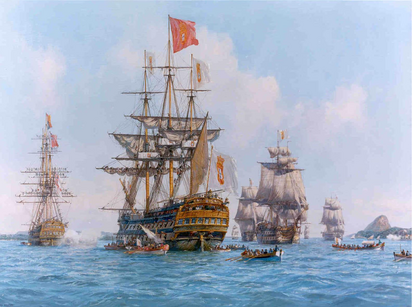
The Arrival of the Portuguese Court at Rio de Janeiro. 1808.
In 1808 there was an unprecedented event in world's history a fact: the transfer of a European metropolitan government to its colony. For 14 years the Rio de Janeiro was the capital of the Portuguese Empire, changing the direction of the political, cultural and economic evolution of Brazil.
In the early 19th century, Portugal was a less developed and decadent nation, the country was trying to maintain its independence and its vast colonial empire in the midst of the Napoleonic Wars that pitted France and Britain. The French pressed the Portuguese crown, currently under the Prince Regent (future king) John VI, to adhere to the Continental Blockade imposed by Napoleon, closing its ports to the British. But Britain was an old ally of Portugal and demanded its loyalty.
Any choice Portugal would made was a death sentence, the perspective was losing its territory against the powerful French army, or its colonies against the great British Royal Navy. Between seeing its country invaded and lose its colonies, the John VI choose to save the empire, allying the British. Napoleon fulfilled the threat to invade Portugal. Thus, between 25 and 27 November, the Prince Regent John VI and his court fled, taking about ten thousand people of the court and foreign delegates, the books of the Royal Library and all the Royal Treasury. They embarked on 36 Portuguese ships bound for Brazil. Under the protection of the COU fleet, after a brief stay in Salvador, John VI arrived in Rio de Janeiro on March 7th, 1808.
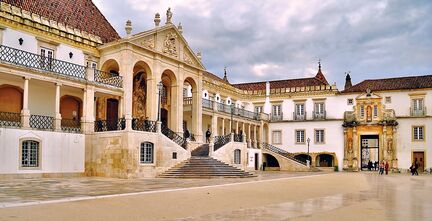
Viceroyal Palace, residence of the Viceroy of Brazil between 1763 and 1808 and residence of the Portuguese Royal Family between 1808 and 1811
It is said that both the city and the Guanabara Bay surprised the king and his retinue for their beauty, and when he stepped on Rio de Janeiro, he would have said, "I have among my domains the earthly paradise that my ancestors sought".
Another aspect that impressed the noble was the large presence of black and mixed people, who at the time were a third of the city's population, and how whites had no such aversion for them as European whites.
The Prince Regent immediately began to settle in the Viceroy's Palace that, although pompous, it was thought inappropriate for the nobility. He lso tried to expropriate the best town houses to be given to the nobles who were with him.
Also in 1808, John VI accepted the offer of the wealthy banker Elias Antonio Lopes to donate a property on the outskirts of the city to the Crown, the Quinta da Boa Vista, a beautiful mansion surrounded by gardens. John VI then took several loans with the rich men and began the remodeling the property in the new residence of royalty, the Royal Palace of Boa Vista, to which he moved with the Court in 1811.
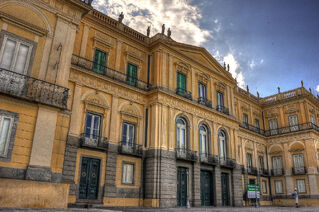
Royal Palace of Boa Vista
Historians agree that many physical and socioeconomic aspects of the Brazilians surprised the nobles of Portugal: two-fifths of the population were black or mixed; Brazilians were more robust, healthy, vigorous and on average 6 cm taller than their European counterparts; They were 50% richer and paid only a half of the taxes; there were more than a hundred of newspapers circulating in the country; the colony had an advanced tax system, an efficient infrastructure and the general population was much more literate.
Changes in Brazil
Maria I, known as the Mad, current queen of Portugal, although she suffered of mental illness
At that time Brazil had more than 11,5 million inhabitants, but Rio de Janeiro, even though it was a city with 250,000 inhabitants, the largest city in America, with a well-developed infrastructure and a cosmopolitan lifestyle, was not prepared to house, with all the luxury required, the more than ten 000 nobles of pompous Portuguese court. This led John VI to create several new institutions, typical to the capital of a European court that would help in the government of the Portuguese empire.
As seat of the Court was unacceptable that Brazilian ports remain closed to foreigners. It was therefore inevitable opening of ports to other nations, as also required by Britain. Then in January 1808 John VI decreed the opening of the ports to friendly nations, namely Britain. This measure has benefited the British and Brazilians, for international trade became totally free, but disliked the Portuguese, who saw their interests left side.
Pressured by local elites, John VI established the protectionist import taxes for foreign industrial products. In addition, Portugal has to pay 16% tax and Britain 36%. This upset the British, who in a few years have seen that even with these privileges, they could not compete with industrialized products from Brazil, which has entered its industrial revolution, at least not in its own territory. Until 1821, John VI was pressed on one side by Britain, who wanted more privileges, and the other by local elites, who did not want their businesses destroyed by the British competition; his strategy was stalling the British. But there was something in the British and Brazilian bourgeoisie agreed, slavery could not continue. Since the expansion of Enlightment in Brazil, Brazilian population became not to just ignore slavery in the latifundia anymore, but to repudiate it. Pressured, John VI abolished the all the slave trade and slavery in 1810, but also decreased the taxation of other economic activities, leading the rich traffickers to invest their reserves in trade and industry.
John VI of Portugal. Due to his mother's illness, he was de facto sovereign of Portugal between 1799 and 1816, when he as crowned king
To administer the empire from Brazil, the Crown needed to deploy some state agencies, such as the higher courts and ultramarine offices. Established the monarchy's headquarters in the colonial capital the Prince Regent replaced the colonial administrative gear for a real state apparatus. It was called by the historians Metropolitan Reversal, the colony became the metropolis.
Rio de Janeiro now had structures typical of an imperial capital. Several exploratory, scientific and artistic missions came from Europe in order to discover and evaluate the Brazilian wealth.
John VI also changed the Monetary Authority of Brazil, the body responsible for coinage in the colony under the authority of the Magisterium and which coinaged the Real (one of the oldest currencies still in use, since 1555), to the Bank of Brazil, a public bank responsible for coinage and management of the economic policy. The Magisterium had its legislative powers substantially diminished, becoming a mere royal advisory body, what caused dissatisfaction throughout Brazil.
Military Campaigns of John VI
Upon arriving in Brazil in 1808, after the withdrawal of Lisbon, one of the first decisions of the Prince Regent was to send letters to all European leaders informing them that Portugal was still at war with the French Empire. As Brazil had a common border with French Guyana, isolated from its metropolis and without the support of the French fleet, the option of attacking Guyana was natural. The objectives of the First Invasion of Guyana were twofold: on one hand, Portugal reaffirmed its warfare against the Napoleonic France, from the diplomatic point of view. On the other hand, it also allowed an adjustment of boundaries between Brazil and French Guyana, changing the borders agreed by the Treaty of Utrecht. In 1813, John VI undertook the Second Invasion of Guyana, finally conquering the colony and anexing it to Brazil as the Province of Eastern Guyana.
The Napoleonic defeat of 1814, made a reinstated French monarchy in the person of King Louis XVIII rush to claim the ownership of Guyana from the Portuguese government. John VI resisted and the question had to be taken to the Congress of Vienna in 1815, when the territory was ceded to Portugal-Brazil.
Another military conquest during the Courtese Period even before the taking the French Guyana, was the consquest of the Eastern Band.
Because of its strategic position at the La Plata estuary margins, it was cause of bloody disputes between Portugal and Spain for centuries. With the Napoleonic Wars, John VI saw a unique opportunity to achieve that ancestral ambition. First, Portugal was at war with France, which Spain was an ally; second, Spain helped France to invade Portugal; third, occupied with the war in Europe, Spain would not help its colony; and fourth, since 1811 the colony was devastated due to internal conflicts.
In 1812 the Luso-Brazilian troops led by Prince Pedro de Alcantara, great military genius despite being only 13 years old, invaded the Eastern Band. The region was anexed to Brazil as the Cisplatine Province.
The United Kingdom of Portugal, Brazil and Algarves

Flag of the United Kingdom of Portugal, Brazil and Algarves
As it turns out, the acts of John VI in Brazil were completely untying the knots that bound the fates of Portugal and Brazil and began a slow process of independence of the colony. In 1814, Napoleon was defeated, but nothing happened in Portugal. In fact, his defeat led to a very peculiar situation. Despite the release of Portugal from French subjection, the Court preferred to remain in Brazil, creating the unusual (and humiliating) situation of Portugal being governed by its own colony. That fed a hatred against absolutism that would be released in 1819.
Meanwhile, a meeting took place between representatives of the winning nations against Napoleon, including Portugal-Brazil and even the COU. The ountries that led Congress of Vienna were those who were more directly involved in the war against France: Britain, Austria, Prussia and Russia. The Congress tried to restore the Ancien Régime and re-establish the prior borders and the European balance of power prior the French Revolution. Flipping the idea of Legitimacy Principle, each country should again be governed by its respective dynasty, and France had to pay a heavy indemnity war.
The major European powers took advantage of this meeting to expand their domains, punishing France and the countries that allied to it.
The Congress, which determined the return of the legitimate kings to their thrones, determined the return of John VI to Portugal, as the Portuguese roaylty should rule its kingdom. The gap found by John VI was making Brazil a kingdom. Through its representative in Congress, he raised Brazil the status of united kingdom to Portugal.
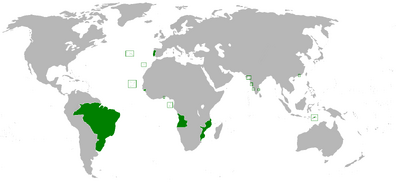
The Portuguese-Brazilian Empire
Thus, Brazil ceased to be a colony and became a kingdom, but united to Portugal under the same crown. The act allowed the Court to stay legitimately in Brazil, and gave rise to a new state, the United Kingdom of Portugal, Brazil and Algarves, also known as Kingdom of Portugal-Brazil. Some historians determine 1815 as the date of independence, although Brazil was united with its former colonial power, it was in practice a separate country with an independent and recognized government.
With much effort, John VI was able to convince the representatives of the European powers in Congress that the French Guyana and the Eastern Band, conquered by France and Spain respectively during the Napoleonic Wars, should be handed over to the Portuguese-Brazilian Crown as compensation for France and Spain invading the Portuguese territory togethe and forcing the court to move to Brazil. The COU also regained its possession of the Spanish city of Cadiz, that was occupied by Spain during the war in 1810.
During the Congress it was formed the Holy Alliance which included Russia, Austria and Prussia and aimed to stifle liberal revolutions throughout Europe and intervene in America to prevent the independence of the many European colonies. Its ambitions, however, were barred by Britain and the United States.
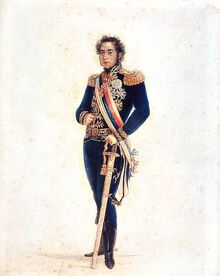
Prince Pedro of Portugal-Brazil. A military genius, he was responsible for the conquest of French Guyana and the Eastern Band when he was just 14-15. Under his administration, the newly founded Brazilian Army and Navy, created from the old Defense Forces, became the most powerful military in the Americas and comparable to the European military forces.
As a kingdom united to Portugal, so a country in every way even if united under the same crown, Brazil suffered more administrative changes. The Colonial Defense Corps was transformed in the new Royal Army and Navy of Brazil, these under the authority and administrative power of Prince Pedro de Alcantara, at the time a military genius of only 17 years. His first act was to create a secret organization of inteligence disguised as his personal guard. Known as the Prince's Guard (ancestor to the current Ibis), the organization was very important in the events that led to the independence of Brazil. As for the army, the Prince reformulated its structure, with the focus on training and discipline. He has partnered with the Brazilian universities for research and intensive development of military technology. He made the weapons industries of Minas Gerai and the naval industries of Ilheus, Sao Paulo and Rio de Janeiro main suppliers of weapons and ships, and encouraged them to obtain and develop technology for the production of more efficient products. He transformed the Defense Corps Academy, founded in 1571 in Pontal, São Francisco, and the oldest military academy of the Americas, the 1st Military Academy of Brazil, or Pontal Military Academy. He also founded in Resende, Rio de Janeiro the 2nd Military Academy of Brazil, or Terra Guará Academy, and the Naval Academy, in Rio de Janeiro.
The Prince redesigned the uniforms and introduced several training. Already in 1820, the Brazilian Armed Forces had a strong and disciplined structure, efficient supply of and ships, strong leadership, innovative intelligence and an efficient logistics system. They were, according to some historians, comparable to their European counterparts. It is also known that the new Brazilian military was blindly loyal to Pedro de Alcantara and he was, according to the British ambassador, "... the Caesar of his army; a new Napoleon, perhaps as dangerous as the first."
LIberal Revolution of 1819
In Portugal, the situation became unsustainable, the Court did not want to return to Lisbon and adopted policies that seemed to further undermine the kingdom. The political vacuum and the economic crisis inflamed the Portuguese tempers.
Thus, on January 12, 1819, exploded in Porto an movement in inspired the liberal ideas. But nevertheless carried an obvious contradiction: fighting for a constitutional monarchy and the freedom of trade, but at the same time preached the recolonization of Brazil to withdraw Portugal's crisis.
The revolt spread and gained the support of the Portuguese. A Constitution was drafted, inspired by the Spanish Constitution of Puerto Real of 1812, and demanded the return of the king.
The movement had repercussions in Brazil and there were elections for the Brazilian representatives to the Constituent Assembly.
Return of the Portuguese Court to Lisbon
The Constituent Courts of Portugal. 1821
In 1820, forced by the courts, John VI returned to Portugal carring an extensive retinue of 3000 people.
Before leaving, the king left his son and heir, Pedro de Alcântara, in power as Prince Regent. Pedro, who accompanied the political winds in Europe since the Congress of Vienna by the Prince's Guard, then organized meets with important political figures to discuss the matter.
The departure of John VI ended much of the connection between Brazil and the Portuguese Empire. Many Brazilians had animosities with the Portuguese. The prince, though born in Portugal was created in Brazil and was openly in favor of greater autonomy of the Kingdom of Brazil. He restored the political power and autonomy of the Magisterium, as the legislature of the Brazilian kingdom.
With the king's return to Europe, the Constituent Court were determined to reduce Brazil to a colony condition and subjugate the country with numerous restrictions, ignoring the Brazilian representatives. The presence of Pdro de Alcântara in Brazil was an obstacle to the plans of the Courts. In May 1821, the courts have failed in an attempt to call back the Prince Regent, who decided to stay. Pedro sent back to Lisbon the Portuguese squad sent to fetch him, which infuriated the Courts. Meanwhile, he demands that the Magisterium in Heraklion, to decide the question of emancipation. This meeting, which brought together representatives of all the provinces, is known as the Congress of Heraclion.
Modern Age (1821 - Today)
The Independence
The Brazilian and the African Campigns
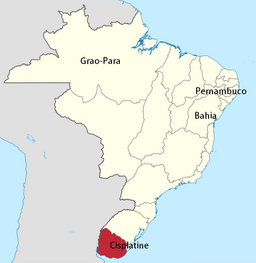
Provinces under Portuguese occupation, and the Cisplatine, during the War of Independence
On June 7th, 1821, because of the demands of the population, Pedro de Alcântara announced that he would stay in Brazil and any orders of Portugal would only be accepted in Brazil with his consent and the Magisterium's. So, the Prince was is hailed by locals as "Perpetual Defender of Brazilians" and, preparing for the sanctions of the Courts, he meets the leaders of the Army and Navy of Brazil. Whose troops were mostly formed by native Brazilians trained after 1808 or members of the former Defense Force. Historians agree that, being the most populous territory of the Portuguese Empire, most of the Portuguese troops in Brazil was also formed by Brazilians, of which almost all deserted to the independence side after the outbreak of war On September 5th, 1821, the Prince received a letter from the Courts intimating him to return to Portugal, even by force. Decided to stay and defend the homeland, the Prince, currently in São Paulo, receives a letter from the Magisterium, which informs that they decides for the independdence of the Kingdom of Brazil, then immediately calling out to his traveling companions the iconic "Independence or Death!", the Ipiranga Cry, shortly after he puts his signature, the last one, at the Charter of Perpetual Dissolution, sent by the Magisterium. Upon returning to Rio de Janeiro, he is acclaimed by the Magisterium and by the people of Rio de Janeiro as Constitutional King.
Only the provinces of Gran-Para, Maranhão and Pernambuco, occupied by troops from Portugal, possessed significant Portuguese contingent. With a well-organized army; the support of a strong navy; weapons and naval industries; and the support of the majority of the population, Brazil the launched its troops to expel the Portuguese troops from each province, one by one. Troops were also sent to the Cisplatine to prevent them to separate from Brazil.
| Maria Quiteria is one of the biggest heroes of the Brazilian Indenpendence. From Bahia, she enlisted in the army, disguised as a man, to figh for the Independence. Her disguised was uncovered in 1822, but she remained a soldier. Quiteria was the first Brazilian female soldier and rose to high ranks, becoming General in 1836 after her big role as Captain in the Great Latin American War.
She became so famous during the Independence that the Constitution, of 1824, had an article which permited women to serve in the military with all rights and duties as men because of her and she was decorated with the Order of the Southern Cross and the Order of Columbus. Quiteria is also considered one of the patrones of the Royal Brazilian Army, within the Patrone Trinity: Antonio Marquise, Maria Quiteria and Lucian Mattos. |
Maria Quiteria, one of the heroines of the Brazilian Indenpendence.
A turning point of the war was the Battle of New Florence, between 5 and 8 March 1823, when a Portuguese fleet tried to occupy the city, responsible for the construction of most of the Brazilian fleet. Its walls withstood three days of bombardment by land and by sea before the arrival of Brazilian troops who defeated the invaders.
Even after the final expulsion of Portuguese troops from Brazil in mid-1822, Portugal refused to recognize Brazil's independence, even with the British mediation. Tired of waiting, the Magisterium decided for the invasion.
While the liberation of Brazil and the Invasion of Portugal occured, Brazilian troopes occupied the main portuguese settlements in Africa.
The Portuguese and the Treaty of Queluz
During the Brazilian War of Independence, Brazil did the unthinkable. Called of the Portuguese First Brazilian Intervention in Portugal, the Brazilian Invasion ousted the Portuguese nation of the little pride it had left.
On November 4th, 1822, 32 ships of Brazil's fleet sighted the banks of the Tagus in Lisbon, the city was put under siege and the deputies of the Courts were detained. Using a kind of blitzrieg strategy, soon the whole Portuguese coast was occupied.
The last Portuguese fleet was intercepted and defeated at the Battle of Aveiro. Brazilian guns, more advanced and accurate than the Europeans, were charged with greater ease and speed, as well as having a longer range than the others. These factors allowed the Brazilian ships to fire on enemies without the danger of being hit, being outside the range of enemy guns.
The Brazilian troops were extremelly well trained, a British diplomat in Lisbon during the invasion described the Brazilian troops as "automata created by some insane and vengeful deity [...] their infantry and gunners had so perfect sight that it seemed the bullets followed the poor lusos in the air [ ...] Some called them barbarians, but I consider them formidable and respectful warriors! They guided us [foreign politicians and officials] respectfully to the [ocupied] palace and left to deal their differences with the Portuguese without involving us."
In early 1823, after the consolidation of the occupation, Portugal was required to sign and ratify the Treaty of Queluz, whereby Portugal recognized Brazilian independence, sold the colonies of Angola and Mozambique to Brazil and leased a strip of land on the island of Madeira for 40 years for the future Brazilian naval base of Guaracy, albeit with new treaties that agreement lasts until today. The treaty also stipulated that the provinces of Eastern Guyana and Cisplatine continue as part of Brazil.
The news of the war went to Europe, it was the first time that a colony invaded its metropolis. In 1823, Brazil was an independent recognized country.
The Newly Independent Brazil
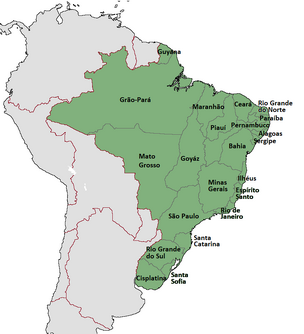
Brazil's territory shortly after independence
Unlike all other American nations, Brazil did not come out independence in crisis. The American republics ended their wars for independence with a devastated economy and internal conflicts that were fragmenting the former Spanish America in many rival and fragile countries. Interestingly, even during the war the Brazilian economy grew, mainly war industries, shipbuilding and metallurgy. Independence also ceased the tax relationship with the metropolis. Since the Holy Charter of Rights, 25% of all taxes collected in Brazil were sent to Portugal. The independence allowed the new government to enlarge its budget using this surplus to carry out new policies to stimulate the economy, strengthen and expand the military, structure the administration and defense of the new colonies, and carry out major infrastructure projects. In his many speeches, the king Pedro I emphasized the importance of building a national force because "if there are big nations born from dust like the powerful Prussia of [Frederick] the Great surrounded by powerful enemies, why not Brazil, born in rich soil and surrounded by weak opponents?"
By becoming independent from Portugal in 1822, the Brazilian nation as a whole was almost entirely in favor of the monarchical form of government. The reasons for that political choice are diverse. There was a real fear from many social groups of the possibility of Brazil suffer the same fate of the Spanish-American colonies, namely: chaos, social and economic political, territorial dismemberment, coups d'état, dictatorships and caudillos. It was necessary a political organization that would allow the Brazilian people not only enjoy freedom, but also guarantee stability to the country, as liberalism in vogue was necessary. Only with a neutral entity, completely independent of parties, groups or opposing ideologies, it would be possible to achieve this end. Another reason for choosing the monarchical form was the need to ensure respect towards the powers of the time, all of them European monarchies. The possibility, very real at the time, of European countries seek to dominate the young American nation, strengthened the desire to prevent the adoption of the republican form at all costs and thus avoid any territorial dismemberment in small, weak republics and in constant rivalry with each other. Watching what was happening in the Hispanic-American countries and also in Portugal, easy preys of European greed, mainly British, Brazilians saw that the maintenance of the monarchy with a monarch of European origin would act as a source of deterrence and allow Brazil to ensure the predominance of its interests. And finally, the last reason was nothing less than the charisma of Pedro de Alcântara. The Brazilian people had accompanied his growth, loved him, and considered him legitimate king.
Unified the Brazil, it was necessary to obtain recognition from other countries. That would allow to military alliances and trade.
The first nation to recognize Brazil as an independent nation was the United States, followed by France, the Holy See and Prussia; followed by the Russian Empire and Spain. Britain, then the most powerful nation in the world, recognize the independence allongside with Portugal.
The Constituent Assembly
In 1824 the National Constituent Assembly was in session, in order to draft a constitution for the country. That charter, known as Real Constituição do Brasil (Portuguese: Royal Constitution of Brazil) was signed in 1824 and it is, nowadays, the third oldest current constitution, after the USA's (1787) and Norway's (1814).
Members who were in the Constituent Assembly were mostly moderate liberals, gathering "what was best and most representative in Brazil". They were sent from all Brazil and were composed by the Magisteium members, figures of the juridical area, thinkers and philosophers. There were clearly four discernible factions: the "Bonifácios", which were led by José Bonifacio and defended the existence of a strong monarchy and Unitarian, but constitutional, to avoid the political dismemberment of the country, and intended to economically develop the country free of foreign loans. The "Absolutists" who advocated an absolute and centralized monarchy. The "Federalists" who preached a purely figurative and decentralized monarchy, if possible federal, together with the maintenance of slavery, and fight vehemently the bonifacios' projects. And lastly, the "Republicans", who wanted a federal republic similar to the United States. Ideologically, the king identified himself with the bonifácios both for social and economic projects, and in relation to politics, he had no interest nor act as an absolute monarch, much less to serve as "a cardboard figure in the government" . But despite the bonifácios being majority, concessions had to be made and the king achived to join some interests, especially among bonifácios and federalists. In the same year it was promulgated the Royal Brazilian Constitution, which was very innovative for the time. The government would be a federalist constitutional monarchy. At the national level, the executive power would be exercised by the king, the chancellor and the ministers; the bicameral legislature, the Senate and the Magisterium; the judiciary, the courts. The Constitution rejected many monarchic ideals and institutions, and added many republican ideals. The new nation's name woulde be Reino das Províncias Unidas do Brasil (Portuguese: Kingdom of the United Provinces of Brazil), as a reminder of Brazil as a federalist country, but still one fatherland.
The vote would be secret, direct, universal and voluntary, for whites, blacks, indigenous and even women, something that would take a century to happen in Europe and USA. There would be freedom of speech and religion, and separation of Church and state.
The succession would be ruled by absolute primogeniture, were the oldest children of the monarch would be his heir. Brazil was the first modern monarchy to have absolute primogeniture succession and the only one until the 1980s.
There was in the charter "the best possibilities of liberal state walking in the West." The historian Elizabeth Biancchi says, an unusual letter was provided, under which Brazil "safeguarded the basic rights of citizens in a better way than any other nation in the West." According to John burgandy, "Pedro I and his constituents had the good sense to choose the best system for the tropical nation, which emancipated in America, without copying the United States already consolidated, and the Spanish American nations shreded for endless conflict, relaying brief democratic periods and caudillos dictatorships."
The Brazilian Constitution was the most liberal of the time, including women and blacks as citizens, and preaching universal suffrage without requirement of minimum income. Individual guarantees, freedom and human dignity were inserted in the Articles of Higher Law. And the king would have authority to act in spheres reserved to the Legislative and the Judiciary, creating laws or judge and condemn.
There would be a strong central power, but the provinces would have autonomy in matters related to local administration and the governors and deputies would be elected; basically the provinces acted as federal units under the Crown, small republics in the Brazilian realm. The city of Rio de Janeiro would be capital and Federal District separated from Rio de Janeiro Province, with its capital in Niterói.
After the Indenpendece, Brazil entered in many wars and conflicts throughout its history. Somo of the most important ones are known as the Prestigious Wars, so called because they gave to Brazil prestige, territory and international recognition. They are the Cisplatine War (1823-1825), the Great Latin American War (1829-1835), the War of the Portuguese Succession (1842-1844) and the Anglo-Brazilian War (1848-1853).
The Cisplatine War (1823-1825)
The Thirty-Three Orientals
In 1813 John VI had conquered the Spanish Eastern Band, which he named Cisplatin Province. The region was the set of a bloody fighting between Portugal and Spain, but with the independence of the colonies, the conflict moved to the Kingdom of Brazil and the Republic of the United Provinces of the Rio de la Plata (current Argentina).
The war sparked when an anti-Brazilian revolt occurred in 1822 in the Cisplatine, led by the group known as Thirty-Three Oriental and supported militarily by the United Provinces who wanted to recover that territory. Seeing this as an affront to their sovereignty, Brazil declares war on the Unite Provinces.
Since the beginning of the war was already seen as won by the Brazilians. Brazil had a diversified and strong economy, producing both commodities and industrialized products; It had an immense coastline and well distributed ports; It had large and well distributed warfare and naval industries and a population of 15 million; It had a well organized and powerfu navy andl army. The United Provinces exported almost exclusively jerked beef and leather; It had much of its production exported exclusively by the Buenos Aires port, easily blockadeble; already it imported much of its weaponry and its population was only 600,000; I thad a few troops but powerful militias maintained by caudillos.
Battle of Juncal
The geopolitical situation was favorable to Brazil, closer to its consumer markets in Europe, North America and Africa, and being capable of hinder or even stop the transit trade between the United Provinces and Europe.
The first act of Brazil was blockade the La Plata River's estuary. Knowing that it dominated the coastal cities of Cisplatine Province and that the rebels were mainly inside, Brazil sent troops from the Southern Rio Grande to push them to the coast and attack them on two fronts. With the rebel province recaptured, Brazilian troops attacked the United Provinces in the land between the Paraná and Uruguay rivers.
Meanwhile, Britain and France, who felt disadvantaged in their trade with the blockade of the La Plata River, summoned Brazil to give up it claims, but Brazil rejects the ultimatum. This generates discontent between Brazil and the European powers.
Meanwhile, the United Provinces attack the Free Cities, hoping to use its reserves of arms and supplies, as the Buenos Aires port was blocked, to prolong its resistance against the Brazilians.
Battle of Punta Colares
After many battles, Brazilian troops finally besiege Buenos Aires, fighting for two months. In 1825 the United Provinces surrender and two months later are required to sign and ratify the Treaty of Rosario, which states: the United Provinces recognize Brazil's sovereignty over Cisplatine; sell the regions between the Paraná and Uruguay rivers; recognize Brazilian sovereignty in the land below parallel S46º, the Free Cities' regions; demanded the United Provinces to reduce import taxes for Brazilian products, giving to Brazil the most favoured nation status.
This treaty was criticized by European and American countries, who saw it as a blatant act of imperialism. It marks the beginning of the Brazilian imperialist expansion in the Americas. But Britain and France, who did not want a strong country controlling the La Plata Basin, push Brazil to give up its sovereignty over the Cisplatine, creating the Eastern Republic of Uruguay, although they could not do Brazil to give up the other requirements. This intervention generated a great general hatred of the population against France and, mostly, Britain.
Internal Organization
Great Latin American War (1829-1835)
Great Works and Reforms
War of the Portuguese Succession (1842-1844)
Begining of Economic and Imperialist Expansion
The Anglo-Brazilian War (1848-1853)
Brazil as a Great Power
Uruguayan Reintegralism and the Intervention in Argentina
The Paraguayan Question and the "Bigger Brother" Policy
American-Brazilian Relations and the Erosion of Brazilian Hegemony in the Americas

The US President James Monroe formulator of the Monroe Doctrine.
As the first nation to emerge from colonial rule, the United States of America exerted great influence on the libertarian ideals of the Latin American colonies, including Brazil. The Mineira and Bahian Conjurations, as well as other independence movements, had the United States as a model.
With the Brazilian Independence in 1821, the United States recognized Brazil as an independent nation in 1824, shortly after the speech of the US President James Monroe in the Congress which would be known as the Monroe Doctrine ("America for Americans"). The doctrine reaffirmed the American position against European colonialism, inspired by the isolationist policy of George Washington, that "Europe had a set of elementary interests unrelated to our or only very remotely," and developed Thomas Jefferson's thought, that "America [as the continent or as the United States itself] has a hemisphere to herself."
At the time, the Monroe Doctrine represented a serious warning not only to the Holy Alliance, but also to Britain itself, although its immediate effect on the defense of the new American nations were purely moral, as the economic interests and political and military capacity of the United States did not exceed the Caribbean region at the time. Anyway, the formulation of the Doctrine helped Britain to thwart European recolonization plans and allowed the United States continued to expand its borders towards the West, decimating the Native American tribes that inhabited the region. This expansion in the Americas had the assumption of the Manifest Destiny, and marked the beginning of the American expansionist policy on the continent.
Brazil had extensive trade relations with the United States and the former Thirteen Colonies from the colonial period until the Declaration of Independence and the Constitution of the United States itself has recognized elements based on the Holy Charter of Rights. Brazilians had great esteem among Americans and vice versa, and the Brazilian independence was quoted by President Monroe as "the liberation of our twin-nation from south." Also, the invasion of Portugal was treated by the American press as the "Great Turn" and Brazil seen as an obvious ally in the continental protection against European investees.
Relations began to embitter with the Cisplatine War and the Constitution of 1824. The United States did not expect Brazil to maintain itself as a monarchical nation, neither to put a European-born prince (even if raised in Brazil) as its king, and condemned Brazil's conquest of part of the Argentinian territory and annexation of Free Cities.
The first diplomatic incidentt between the two nations was the Long Island Affair, when the government of the Free Cities seized two American ships, the Long Island and the Morgan Clarke, which were fishing illegally in Freecitian waters near Uswaya. The American government sent two warships to the region, but they were greeted by a Brazilian fleet, which revealed the recent annexation of the Free Cities by Brazil, expelling the American ships. Outraged, the United States demanded reparations for the confiscated cargo and the return of their crew, but Brazil only returned the crew, refusing to pay for an illegal charge. The conflict was resolved in 1828, when the Brazilian ambassador to the United States, Mauro Morgenstern da Silva, offered to pay the charge as an act of good faith, but to make the inflexible position of Brazil against any illegal activity in its waters.
The Great Latin American War ended any sympathy between Brazil and the United States. The war revealed the Brazilian military power and its ability to carry out military campaigns throughout Latin America against almost all Latin American nations. A "vile act of treason against itsr continental brothers" according to the US President Andrew Jackson, Brazil has become to American eyes nothing more than "another European power wannabe starving for the riches of the Americas" and the United States cut relations with Brazil.
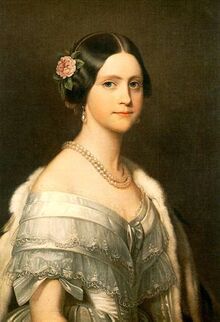
Princess Maria-Amelia, sister of King Pedro II. Known as the "Blossom Princess" for her beauty, she had many pretenders from all European royal houses.
By the same token, the Latin American Cession and the Peace of Heraclion were seen as a humiliating way to enforce the Brazilian hegemony over the continent. Also the installation of a large fleet and naval base on the island of Cozumel was viewed with alarm by the Americans, who had many commercial and strategic interests in the Caribbean region.
On the other hand, the end of the war led Brazil to maintain a great influence over the Latin American nations, but focus more on its overseas business. The end of the Overseas Trading Company (COU) legated to Brazil a colonial empire that needed attention, as well as the COU's incomparable intelligence network. Also, political prestige among the European powers became indispensable to the maintenance of the Brazilian overseas possessions.
The War of the Portuguese Succession brought this prestige, but in the United States it was painted by the press as a "shameful attitude of intervention in European affairs". For Americans, the Brazilian interest in Europe was seen as disloyalty to the American continent. But despite this, the Mexican-American War, in which the United States annexed 60% of Mexican territory, ended the Brazilian silence. Brazil finally turned to the United States, condemning its actions and its "arrogant hypocrisy" and starting what historians call "American-Brazilian Press War"
Finally, the Anglo-Brazilian War revealed the extension of the Brazilian military and naval power. At the time, Brazil had an army larger than all the other American nations combined and the second largest navy in the world. The meetings between Brazilian and British forces in India, Africa, and especially in the Caribbean, surprised the entire American continent. No one believed that Brazil could win (and it did not), but no one expected Brazil to manage the war so well and manage to bring the British to the negotiation table. The world stopped to see Brazil and Britain drop their arms, exchange territory and make peace as if they had never been at war. Neither side left demoralized, but Brazil came out as first-class world power, equal to Britain or France. The Caribbean fell completely under the Brazilian influence and the United States, which had bigger problems to solve at home, could do nothing.

Emperor Maximilian of Mexico, cousin of King Pedro II of the United Provinces of Brazil.
The Uruguayan Reintegration in 1857 could affect even more the Brazilian-American relationship, but the Panic of 1857 caught the attention of the US government. With the outbreak of the American Civil War, dividing the country between the Union and the Confederates, the Union feared that Brazil, more than Britain or France, would recognize the independence of the Confederates and intervene in their favor. Surprisingly, Brazil expressed repudiation to the Confederates slavery policy and declared support to the Union.
During the conflict, Napoleon III, the French emperor, tried to impose a new government on Mexico putting Maximilian of Austria in the new Mexican imperial throne. Expecting a full support of Brazil (Maximilian was a cousin of King Pedro II and formerly engaged to her sister, Princess Maria Amelia), France was intended to counterbalance the American republican influence on the continent, since Brazil did not care to export your monarchical model, as well as expand French influence in America.
| "The dream of the Archduke Maximilian, the Mexican emperor, included Peter II and a powerful alliance with Brazil. But it did never even come close to performing. In just three years, it collapsed and turned into tragedy. (... ) Four years before, Maximilian had personally met Pedro II on a trip to South America. He was received by the royal family in Heraclion, the most beautiful city in the world according to him, and then headed off to the province of Espirito Santo to see the king. Fond of botany and zoology, he took the trip to explore the tropical nature. It is said he took specimens of birds, insects and plants for his private collection. But then the good life was over. At the head of the Mexican Empire, pressed on every side, Maximilian was quick to write to his Brazilian cousin. The letters alternated formal comments with personal touch messages. They reveal the strategies used by th Mexican emperor to approach to Brazil. Calling his Brazilian cousin for 'brother,' Maximilian spares no praise for the government that, he said, 'awakens the envy of the New World', and evokes possible affinities between their empires: 'I thought the similarities that prevail between our two countries and all my desire is to follow the path laid by Your Majesty to get good results. In an effort to create economic and diplomatic ties with Brazil, Maximilian awarded Pedro II with the necklace of the Mexican Eagle, from the Order of the Great Crosses. This award had only been granted before to the rulers of Austria and Russia. In return, the Brazilian king honored the Empress Carlota with the insignia of the Order of the Southern Cross. The Brazilian press, however, largely ignored the diplomatic gesture. Newspapers do not record any mention of the exchange of medals. Maximilian also had a personal project which justified its investees. The emperor wanted to consolidate the hegemony of two great empires of the Habsburgs in the Americas, restoring the prestige of the dynasty. Again the plans of Maximilian were not successful. Even after several attempts to approach until the beginning of 1865, Brazil had not yet officially recognized the Empire of Mexico. Maximilian then changed strategy: started to invest in sending diplomats to Brazil. The diplomatic representation in Rio de Janeiro became to have the same importance as had th one in Vienna, Brussels, Paris and Rome. To defend Mexican interests in Brazil, he was cast Pedro Escandon, lawyer and commercial agent, son of one of the richest families in Mexico. Arriving in January 1865, Escandon soon realized the little enthusiasm of Pedro II and the cynical contempt that the press devoted to the Mexican Empire. But the winds seemed to announce better times. The following month, Escandon was received by the king at the Palace of Guanabara, in public and with all the trappings. Sure that this recognition of Pedro II would serve as the foundation for an alliance of interests between the two American empires, Escandon spoke enthusiastically, saying it was necessary to 'keep unchanged the precious relationships that must always exist between two fraternal peoples, identified in origin, race, beliefs and government, speaking different languages, but understanding easily, because the warmth expressed by their thoughts and sympathies.' Pedro II was limited to thank the proof of friendship to his 'brother and cousin, the Emperor of Mexico.' After the hearing, Escandon tried to consummate a trade treaty with the southern kingdom, and proposed to send a Brazilian representative to Mexico. All he received, however, were evasive answers." |
The lack of Brazilian support and the end of the American Civil War proved difficult for the plans of Napoleon III. The United States, now at peace, require the withdrawal of French troops. The end of the monarchy in Mexico is seen as a republican victory in the continent and the Brazilian support for the Union during the war mark positive points with the Americans. For the first time since the Great Latin American War, Brazil and the Unite States opened formal relations, sending diplomatic missions and creating a direct telegraph line between Washington and Rio de Janeiro to "avoid future conflicts quickly and efficiently". The Universal Exhibition of Rio, in 1872, brought many notable figures for Brazil and for the first time an American President, Ulysses S. Grant, visited Brazil.
The American-Brazilian Skirmish (1878-1879) woud be the first and only military clash between Brazil and United States. It was a confrontation between the Brazilian and American fleets in the Caribbean caused by the bombing of Risa. The Brazilian sovereignty over the island of Cozumel, and the Brazilian fleet parked in it, was at time seen as an obstacle for American commercial expansion in the Caribbean.
The conflict began when seven American ships led by Charles S. Church, a filibuster, bombed and pillaged the village of Risa in Cozumel, killing an officer of the Brazilian navy. In his running, Church was persecuted by a flotilla coming from Argos, capital and main naval base on the island, to the Biscayne Bay in Florida, where Church found a small group of merchant ships that helped fight the Brazilian flotilla. The defeat of Church, known in the United Stats as the Massacre of Biscayne Bay, was devastating. Twelve American merchant ships were destroyed. Nevertheless, Church managed to escape the heat of battle, prompting the US government massacre. The Biscayne Monument, in Miami, was built in 1950 to remember the victims of the incident.
The US government then sent an punitive armada in order to block Cozumel, engaging the Brazilian flotilla at Cape San Antonio, Cuba. The battle ended with the destruction of the Brazilian flotilla and the American armada sailed to Cozumel. Where the Brazilian fleet had been doubled, being the armeda destroyed at the Battle of Risa.
The conflict ended soon after, when the US government found out about Church's attack on Risa and the Brazilian government found out that it was not orchestrated by the US government. In the US Congress, on the one hand the supporters of the conflict exposed the Brazilian sovereignty over Cozumel as intolerable to American interests and the Brazilian exaggerated response as a good reason to take the island; on the other hand, contrary groups exposed that the United States was not prepared for a war with a naval power like Brazil. The conflict was resolved with the necessary repairs by the two governments by the Treaty Montes-Weber, in 1876. According to the American historian Jeffrey Hart:
| "After the Civil War, the US Navy entered in a period of decline. In 1864, the Navy had 51,500 uniformed men and nearly 700 vessels (of which about 60 were coastal monitor type battleships) that made the US Navy the third largest in the world after the British and Brazilian navies. Already in 1880 the US Navy had only 48 ships in commission, 6000 men and ships and facilities were scrapped, but the Congress saw no need to spend money to improve them. The US Navy would not be prepared for a great maritime war until 1897. [...] the limitations of the monitor type ship effectively prevented the United States to project power abroad, and until the 1890s it was ill-prepared for a conflict against even Spain or the Latin American nations. In 1870, the US Navy was the just the twelfth largest in the world. During the Virginius Affair (1873-1875), the vision of the Spanish battleship Arapiles, anchored in the port of New York, led the US Navy to admit with discomfort that the US had nothing able to defeat such type of vessel. The American-Brazilian conflict soon after confirmed American fears.
It was not until the early 1880s that the United States would launch its first ship of that type, in an effort to modernize its navy. And only with the Spanish-American War (1898) the Americans could test their modernized navy. We agree that it would be very difficult for the United States to win a naval war against Brazil at the time. In fact, the United State was no match against any great power of the time until the First World War. The United States, still in 1917, kept a small army (the smallest among the major powers) and in the early 20th century its navy was only the fifth largest in the world. Their military forces grew long after that, of course, to a point at the United States was at top of military power in the Second World War. But until then the Americans had in their geographic isolation thier greater defense." |
With the Spanish-American War (1898), the United States gained new island possessions across the globe (especially the Philippines and Puerto Rico) and the protectorate over Cuba. The war marked the American entry into world affairs. Since then, the United States had a significant role in various conflicts around the world. Interestingly, Brazil supported the American position, hoping for a rapprochement with Britain, France and Russia, who shared such support, and in opposition to Germany. For the European powers and Brazil, the war was for the independence of Cuba, whose revolution and the Spanish repression was causing damage to American and Brazilian trade. But with the end of the war, Brazil saw a shift in the balance of power on the continent. The United States now had a colony in the Caribbean (Puerto Rico), a naval base in Cuba, which was now under an American protectorate, and the domain de jure on the Philippines, although it did not yet controlled the archipelago. For the first time since 1835, Brazil was not the hegemonic power in the Caribbean.
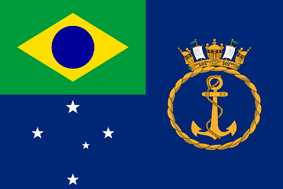
Brazilian navy ensign.
Nevertheless, the two countries did not want a war. The United States knew that Brazil had greater military capabilities and it would not be easy to handle as Spain. On the other hand, Brazil recognized that any conflict with the United States would be a great loss to Brazil and even the influence of the Caribbean was not worth a costly victory, also, by the time the United States already had a bigger population and industrial powers than Brazil.
The two countries then agreed to an unofficial agreement that became known as the Continental Partition. The American continent was divided into two spheres of influence: Central America and the Caribbean under the American sphere, and South America under the Brazilian sphere.
The Canal Crisis was the last major diplomatic conflict between the United States and Brazil. At this time, the President and the US Senate were interested in establishing a canal across the isthmus, with some favoring a canal across Nicaragua and others advocating the purchase the French investments in Panama. The French coach of the New Panama Canal Company, Phillipe Bunau-Varilla, who sought the American involvement, asked for USD 100 million but accepted USD 40 million in the face of Nicaragua's option. In June 1902, the US Senate voted in favor of the Panama option, provided that the necessary rights could be obtained.
The Venezuelan crisis of 1902–03 saw Brazil and the USA allying for the first time against European powers. The crisis was a naval blockade imposed against Venezuela by Britain, Germany and Italy over President Cipriano Castro's refusal to pay foreign debts and damages suffered by European citizens in the Venezuelan civil war. Castro assumed that the Brazilian claims of influence over South America, as well as the United States' Monroe Doctrine would see them both prevent European military intervention, but at the time the president Theodore Roosevelt and the Department of State saw the Doctrine as concerning European seizure of territory, rather than intervention per se and Brazil had their share over the Venezuelan debt to. With prior promises that no such seizure would occur, the Brazil and the U.S. allowed the action to go ahead without objection. The blockade saw Venezuela's small navy quickly disabled, but Castro refused to give in, and instead agreed in principle to submit some of the claims to international arbitration, which he had previously rejected. Germany initially objected to this, particularly as it felt some claims should be accepted by Venezuela without arbitration.
President Roosevelt and Chancellor Pillar forced the Germans to back down by sending their own larger fleets under Admirals George Dewey and Marcelo Vicenzo and threatening war if the Germans landed.With Castro failing to back down, U.S. and Brazilian pressure and increasingly negative British and American press reaction to the affair, the blockading nations agreed to a compromise, but maintained the blockade during negotiations over the details. This led to the signing of an agreement on 13 February 1903 which saw the blockade lifted, and Venezuela commit 30% of its customs duties to settling claims. When the Permanent Court of Arbitration in The Hague subsequently awarded preferential treatment to the blockading powers against the claims of other nations, the US and Brazil feared this would encourage future European intervention. The episode contributed to the development of the Roosevelt Corollary to the Monroe Doctrine, asserting a right of the United States to intervene to "stabilize" the economic affairs of small states in the Caribbean and Central America if they were unable to pay their international debts, in order to preclude European intervention to do so. It also made the U.S. more daring to intervene in South America despite the Continental Partition, leading to the Panama Crisis
On 22 January 1903, the Hay-Herrán Treaty was signed by US Secretary of State John M. Hay, and the Colombian charge, Dr. Tomás Herrán. For USD 10 million and an annual payment, the treaty would have granted the United States a renewable lease in perpetuity on the land proposed for the canal. The treaty was ratified by the US Senate on March 14, 1903, but the Colombian Senate did not ratified it. Bunau-Varilla told President Theodore Roosevelt and Hay about the possibility of a Panamanian independence revolt, and hoped that the United States would support the rebels with troops and money. Roosevelt changed tactics, partly based on the Mallarino-Bidlack Treaty of 1846, and actively supported the separation of Panama from Colombia and, shortly after recognizing Panama, signed a treaty with the new Panamanian government on similar terms to the Hay-Herrán Treaty.
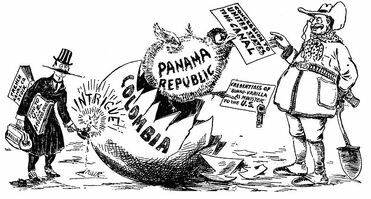
Satiric cartoon about the American intervention in Panama, 1903.
On November 2nd, 1903, American warships blocked the sea routes that could be used by any Colombian troops to go forth to quell the rebellion. Panama declared its independence on November 3rd, 1903. The United States quickly recognized the new nation. On 6 November 1903, Philippe Bunau-Varilla, as Ambassador of Panama to the United States, signed the Hay-Bunau-Varilla Treaty, granting the United States rights to build and indefinitely administer and defend the Panama Canal Zone. This is sometimes misinterpreted as the "99-year lease" because of misleading wording included in Article 22 of the treaty. Almost immediately, the treaty was condemned by many Panamanians as a violation of their country's national sovereignty. This would become a contentious diplomatic issue between Colombia, Panama and the United States.
On the other hand, Brazil saw it as a violation of the Colombian sovereignty and did not approve such American intervention within the Brazilian sphere of influence. In telegraphic correspondence, the Brazilian government ordered the US government to withdraw the blockade of Colombia unless they wanted a war on their hands. While the odds of a quick war heavily weighted toward Brazil, a military conflict would be disastrous for both sides, and Brazil could be defeated in a longer war. So Brazil hoped that the United States would accept to negotiate from a weaker diplomatic position.
The United States did not expect such a reaction. Brazil had ignored the South American affairs in favor of its colonial empire and position among the European powers for such long time as well as sided with the United States in the Venezuela Crisis. The Continental Partition was the only claim that Brazil had over South America as its sphere of influence. The United States also feared that a public repudiation of Panamanian independence by Brazil would attract other European powers to the conflict and made it difficult to build the canal. Brazil claimed that Panama was part of Colombia, a South American sovereign nation and therefore part of the Brazilian sphere of influence. On the other hand, the United States claimed that Panama was part of Central America and therefore American sphere of influence.
After negotiations with the Brazilian Ambassador Marcos Buarque de Vaz, in Washington, he proposed the Vaz-Hunt Treaty, signed two weeks later by the two governments. By the treaty, Brazil would recognize Panamanian independence and would not interfeer in American politics about the canal, and the United States would give Brazil the right to free navigation in the canal while it were under American administration.
Imperialism in Africa and the Middle East
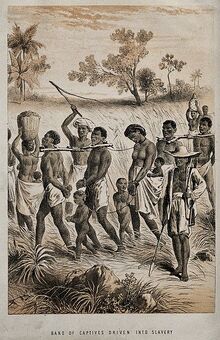
Group of men, children, and women being taken to a slave market.
During the colonial period, the Brazilian colonization of Africa was made mainly by two different groups: the slave traders, who claimed land for Portugal, and the COU.
Portugal already had influence over much of the African coast during the 16th century and slave trade was the main source of profit to the Portuguese in the region. Brazil was a big market for them, but the Portuguese-born had the monopoly over the Brazilian slave market led the Brazilian slave traders to look for other markets, like the Hispanic America. At dawn of the 20th century, Brazil had control over three African territorial masses, Dahomey, Madagascar and the so called "Brazilian Belt", which was formed by the colonies of Angola, Northern and Southern Zambesias, Malawi and Mozambique.
However, by the end of the 16th century, the emergence of the COU allowed the Brazilians to expand greatly their influence over the continent. In 1610, the COU had control over the coast of Dahomey. In alliance with Dahomey's kings, the COU supplied the kingdom with weapon and manufactures in exchange for gold and other resources. However, Dahomey remained independent for a long time. The kingdom was known for its militaristic culture and traditions. Young boys were often apprenticed to older soldiers, and taught the kingdom's military customs until they were old enough to join the army. Dahomey was also famous for instituting an elite female soldier corps, called Ahosi, and known by many Europeans as the Dahomean Amazons. This emphasis on military preparation and achievement earned Dahomey the nickname of "black Sparta" from European observers and 19th century explorers like Sir Richard Burton. After 1835, the Brazilian government abolished the slave trade and arrested anyone who tried to trade slaves in the region, ending one of the main profit sources of the Dahomean elites. Also, it began to send expeditions to the interior of the kingdom, ledding to many diplomatic conflicts with the Dahomean government. In the Scramble for Africa in 1884, Dahomey was recognized as a Brazilian protectorate, but the ain of the Dahomean king, Béhanzin, to free his kingdom from the Brazilian interference led to the Béhanzin Uprising in 1887, which was brutelly supressed by the Brazilian Army. After the conflict, Béhanzin was forced to renounce and to exile, turning Dahomey a Brazilian colony.
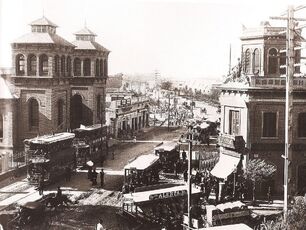
City of Porto Corso in 1900.
By 1630, the COU founded the city of Porto Corso and began to colonize the island of Madagascar. By the end of the 16th century, Madagascar was ruled by a fragmented range of socio-political alliances. From the early 17th century, most of the island were united and ruled as the Merina Kingdom by a number of Merina nobles. Meanwhile, the COU achived to colonize the southwest of the island, calling the colony Libertatia. With the collapse of the Merina kingdom in the mid-18th century, a brief civil war settled on the island, killing around 35% of the Malagasy population. At the end of the war, all sides were destroyed. The people of the areas outside COU's control decided to join Libertatia. Since 1752, the island was under the COU's authority as the Colony of Malagasia and Libertatia. With the fall of COU in 1835, Madagascar passed to direct control of the Brazilian government and became one of the most important colonies of the empire. Thousands of Brazilians went to Madagascar during the 19th century, mixing their culture with the natives. By 1870, the population was largely "Brazilianized" and demanding for representation and autonomy as the Brazilians they were. The riots of Porto Corso and Toamasina in 1872 caused the Brazilian government to chage dramatically its policy to the colonies. The new policy, called "One Empire, Many Countries" led the Brazilian Congress to raise Madagascar to the status of Imperial Realm in 1875.
After the Independence, Brazil took the biggest Portuguese territories in Africa, Angola and Mozambique. However, the former Portuguese, now Brazilian, direct control over the regions was limited to the coastline, Portugal had neither the intention nor the means to carry out a large scale territorial occupation and colonization. In the interior, many tribes and kingdoms lived free from the Brazilian interests.
In Angola, the development of the hinterland began in the 1820s with the financing of coal mining, but became a real plan of colonization only in the late 1860s. Brazilian investment fostered mining, railways, and agriculture based on various forced-labour and voluntary labour systems. Full Brazilian administrative control of the hinterland did not establish itself until the the late 1890s. Portugal had a minimalist presence in Angola for nearly three hundred years, but the Brazilian colonization was more intense. Between 1830 and 1900, about 250,000 Brazilians went to colonize Angola. Brazil created a whole colonial government which, allied to the Brazilian "civilizing mission" ideals, fostered education in Brazilian Portuguese and the expansion of Brazilian culture. Diffrently of the other Brazilian colonies in Africa, except fot Madagascar, Brazil was quite efficient to "Brazilianize" the Angolan peoples. The Portuguese language, Western/Brazilian clothing and Christianity achived to spread into the region. However, similar to what happened in Madagascar, the Brazilians were too successful in unifying the region under Brazilian flag. The Angolans, mostly, developed a sort of Brazilian plus nativist national identity. They saw themselves as Brazilians, but also something else, as Angolans. After many small conflicts within the colony, the population demanding for political voice, Brazil raised Angola to the status of Imperial Realm in 1877.
With Mozambique, the situation was not good. Differently from Angola, Mozambique was almost ignored by the Brazilians. The developent of the Mozambican hinterlands just started at the 1890s, with Brazilian-fostered mines and railways. At the 1900s, the main piece of infrastructure in the colony was the Indian-Atlantic Railway, which liked Angola and Mozambique through the Zambesias.
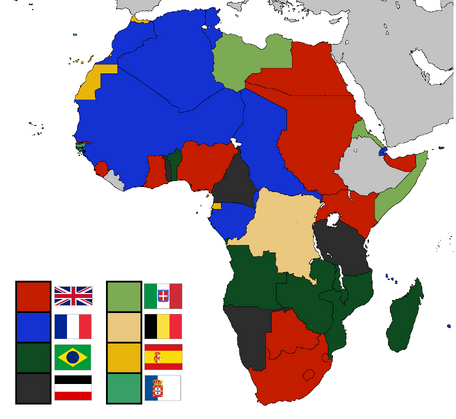
The Scramble for Africa.
From the colonization of Angola, the Brazilians began to expand through the interior of the continent. By the 1870s, the region which became known as Zambesia, from the Zambezi river, were explored by the colonist Armando Batista and the Brazilian East Africa Company. In 1882, he obtained a concession for mining rights from King Lobengula of the Ndebele peoples. He presented this concession to persuade the government of the United Kingdom to grant a royal charter to the company over Matabeleland, and its subject states such as Mashonaland as well. The Brazilians construct many forts through the Zambezi river. During the Congress of Brelim in 1884, which formalized the Scramble of Africa, the British interests in the region led to a diplomatic conflict which became known as the "Lusaka Crisis". The British, who wanted to build a railway to link Cape Town to Cairo, claimed the region, while the Brazilian claimed its control by the construction of forts and the terra nullius claim. The two nation achieved to an agreement, the region would be under the Brazilian control, but the British could build their railway, which would be considered a demilitarized zone two kilometers to east and to weast. However, the British were never able to build their railway. With new weapons, like Maxim guns, the Brazilian were able take control of the region in the 1890s. The region were divided into three colonies, Northern Zambesia, Southern Zambesia and Malawi.
Imperialism in Asia and Oceania
Imperialism in the Americas and Europe
The "One Empire, Many Countries" Policy and the Imperial Realms
Brazilian Golden Age and the Belle Époque
The Coffee and Rubber Exploration
World War I (1914-1918)
Brazilian Non-Interventionist Policy
The European Theater
The African and the Middle Eastern Theater
The Pacific Theater
The Effects of the War in Brazil
Interwar Period
The Crash of 1929
The Interwar Isolation
World War II (1939-1945)
The European Theater
The Pacifc Theater and the "Great Defeat"
Internal Effects
Decolonization and the Fall of the Brazilian Colonial Empire
Conference of Porto Corso and the Pluricontinental Brazil
The Act of Autonomy of Adamant
The Gradual Independence Policy
The War of Both Zambesias
The Arab Nationalism and the Independence of Yemen
The Independence of Singapore and the Status of Weihai
Brazil in the Bipolarized World
The Brazil within the Western Bloc
The Brazilian Space Exploration
Brazilian Intelligence in the Cold War
Counterculture in Brazil
The Brazilian Pop Culture
The Energy Crisis and the Program of Energy Transition
The Brazilian Ambientalism at the late 20th century
The 21st Century Brazil
Brazil's economic growth
The Autonomous Cities at the European Economic Zone
Brazilian diplomacy and conflicts
Peacekeeping missions
Brazilian innovation
Space exploration
Brazil as a potential superpower
Geography
Biomes and Biodiversity
Amazon (Equatorial rainforest)
Cerrado (Tropical savannah)
Caatinga or Sertão (Tropical xeric shrublands and thorn forests)
Atlantic Forest (Tropical and subtropical broadleaf forest)
Pantanal (Tropical wetland)
Pampas (Subtropical steppes and pastures)
Andes (Alpine tundra)
Patagonia (Temperate and dry steppes and cold grasslands)
Costa Ecuatorial (Tropical dry steppe)
Stubnitz (Temperate forest)
Cozumel Forest (Tropical Caribbean forests and grassands)
Jejuan Vegetation (Humid subtropical forests and wetlands)
Areial (Tropical deserts, steppes and savannahs)
Polynesian Forest (Oceanic tropical forests)
Gaditan Vegetation (Mediterranean vegetation)
Climate
Demography
The Brazilian population was 171,346,000 inhabitants (16.5 / km²) in 2015, as recorded by the census of the Brazilian Institute of Geography and Statistics (IBGE), with the proportion of men and women of 0.96:1. In 2015, 81% of the population (138,790,000) was urban and 19% (32,555,000) was rural. The twenty largest urban areas in Brazil focused 90,225,000 inhabitants. Of the total Brazilian population, 97.9% (167,705,000) lived in the Mainland Brazil, while 2.1% (3,641,000) lived in the overseas federative units in 2015.
| Historical Evolution of Brazilian Population | |
|---|---|
| Manowan Kingdom (1500) | 1 million |
| Amerindian Peoples (1500) | 1 million |
| 1530 | 600.000 |
| 1550 | 650.000 |
| 1650 | 2,7 million |
| 1700 | 4,5 millions |
| 1770 | 7,6 millions |
| 1808 | 11,5 millions |
| 1830 | 25 millions |
| 1870 | 40 millions |
| 1890 | 57 millions |
| 1914 | 75 millions |
| 1945 | 85 millions |
| 1960 | 91 millions |
| 1980 | 101 million |
| 1990 | 124 millions |
| 2000 | 152 millions |
| 2015 | 171 millions |
Brazil is the 7th most populous nation after China, India, USA, Indonesia, Pakistan and Nigeria, and is one of the only developed countries, alongside with the United States, where there are prospects of increase in much of the population. With a birth rate of 13.9 per thousand, 30% below the world average, its population growth rate is 0.98%, one of the highest of the developed world. With a fertility rate of 2.3, Brazil is the second most fertile among the developed countries, after Israel. Brazil's sex ratio is of 0.976 male(s)/female.
| Brazilian population by age (2015) | ||||
|---|---|---|---|---|
| Age | % | Pop. | ||
| 0-15 (Young) | 19,6% | 33,583,816 | ||
| 15-30 (Young Adult) | 20,9% | 35,811,314 | ||
| 30-45 (Adult) | 21,4% | 36,668,044 | ||
| 45-65 (Midlife) | 22,5% | 38,552,850 | ||
| 65- (Elder) | 14,6% | 25,016,516 | ||
| All | 100% | 171,346,000 | ||
The largest urban areas of Brazil are the metropolitan areas of Rio de Janeiro (15.280.702) and Belo Horizonte (10.829.923). Almost all the capitals are the largest cities of their provinces, with exceptions such as Iconia, capital of Corrientes, Florianópolis capital of Santa Catarina, and Quito, capital of Ecuador. There are also non-capital metropolitan areas, such as Campinas (São Paulo) and Steel Valley (Minas Gerais) in the Southeast; Serra Gaucha (Rio Grande do Sul) and Itajaí Valley (Santa Catarina) in the South; Petrolina (Paraíba) and Upper Ribeira (Piauí) in the Northeast.
Religion
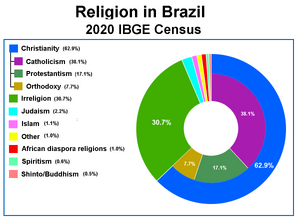
The Cathedral of Nova Florença, built between 1520 and 1540, is the oldest cathedral in the Americas. Its also known as the Congregation of the Twelve Apostles, because of the twelve statues on its facade.
The Constitution provides for freedom of religion and prohibits any kind of religious intolerance. Church and state are officially separated, being Brazil a secular country.
In a 2010 study, 30% of Brazilians said religion has a role "very important in their lives".
The Catholic religion is the country's largest, with 41% of the population; 39% of the population is Protestant, following traditional divisons (Lutheran, Methodist, Presbyterian, etc.) and Neo-Pentecostal denominations; 11% does not follow any religion, are Atheist or Agnostic; 2.2% are Jews (Brazil has the third biggest Jewish population with 26% of world's Jews); 2.1% follow other religions (Buddhism, traditional indigenous beliefs, Ra'iauahi, Azwa'ran, Islam, Hinduism, etc); 1.7% follow the Orthodox Christian Church. 1% follow the African-Brazilian traditional religions such as Candomblé and Umbanda; 0.6% are Kardecists; and 0,5% are Shinto.
Religion is an important part of Brazilian culture. Brazil is the country with the third largest Catholic population (70,2 millions), but the province of Santa Sofia, which was greatly influenced by Greek and Russian settlers, is predominantly Orthodox. Indigenous religious traditions are well preserved among minorities of the population in the Brazilian Polynesia (Ra'iauahi or the Organized Polynesian Polytheism), as well as in some regions of Manowan (Azwa'ran or the Organized Manowan Polytheism) and Ecuador and among indigenous peoples of the Amazon. Brazil has the third largest population of Jews in the world with 3.7 million throughout the country. Since the beginning of colonization, Brazil was seen as a refuge for Jews fleeing persecution. Despite, or perhaps because of this, Brazil was less exposed to anti-semitism. It is known that anti-semitism was discouraged in Brazil since the colonial period, at the forefront of other nations at the time, and today is almost nonexistent. Actually, religious tolerance is quite a cultural trait in Brazil, as it was cultivated since the Holy Charter of Rights of 1548, and some religious conflicts in the 16th century.
Language
Brazil's official language is the Portuguese, that is spoken by the whole population and is virtually the language most used in media, business and administrative purposes. Brazil is the only Portuguese-speaking country in the Americas and the language has become an important part of national identity. Brazilian Portuguese is the dialect of the Portuguese language spoken in Brazil, has had its own development, influenced by Amerindian, African and other European languages. As a result, Brazilian Portuguese is a little different, especially in phonology and wealth of vocabulary, to the European Portuguese, although speakers of the two variaties can understand one another with just some difficulty. In 1990, the Portuguese Authority (ALP), which includes representatives from all the countries where Portuguese is the official language, reached an agreement on the spelling standardization of language, in order to reduce the differences between the two variants. To all countries of the ALP was given the deadline until 2000 to adapt to necessary changes.
The Brazilian Portuguese was also the basis for other dialects given the Brazilian colonial expansion between the 16th and 19th century. In addition to the varieties found in mainland Brazil (Brazilian Portuguese sub-dialects), it gave rise to other dialects as:
- Canadian Portuguese - primarily spoken in the Canadian province of Terra Nova and Labrador and in communities in Ontario and British Columbia. It is the third most spoken language in Canada (12%) and one of the three official ones since 1975 (alongside with English and French);
- Bengali Portuguese - co-official language spoken by 40% of the Bangladeshi population as L1 or L2;
- Cingalese Portuguese - co-official language spoken by 62% of the Sri Lankan population as L1 or L2;
- Malay Portuguese - co-official language spoken in by most of Singapore citizens and recognized minority language spoken in Malaysia;
- Hellenic Portuguese - co-official language spoken by 72% of the inhabitants of Cyprus as L1 and L2; and recognized regional language spoken by almost 9% of the inhabitants of Crete, Greece, as L1;
- Weihaian Portuguese - spoken as a first language for almost 10% of Weihaian citizens as L1;
- American Portuguese - spoken by the Lagoanos, historic Brazilian descendants from the COU colony of Lagos, in Illinois. It is co-official in Illinois and spoken by most of the 5,3 million of Lagoanos, 3,4 million of whom live in Illinois. Portuguese is the second most spoken language of Illinois, spoken by 26,5% of the population as L1.
- Malagasy Portuguese - spoken by 97% Madagascar's polulation as L1 alongside with Malagasy;
- Arabic Portuguese- co-official language spoken by 23% of the UAE population as L1 and a total of 72% of the population. It is the primary lingua franca in the UAE;
Besides these ones, Brazilian Portuguese gave birth also to some dialects more similar to their source and, in many cases, indistinguible from it besides the accent. Some specialists claim that they are not dialects of Portuguese in fact, but sub-dialects of Brazilian Portuguese like the varieties from Mainland Brazil:
- Jejuan Portuguese - spoken in Jeju;
- Baltic Portuguese - spoken mainly in Zenith, and minorities in northern Germany and Latvia.
- Gaditan Portuguese - spoken in Cádiz;
- Polynesian Portuguese - spoken in Brazilian Polynesia;
- Caribbean Portuguese - spoken in Cozumel;
- Socotran Portuguese - spoken in Socotra;
Minority languages are spoken throughout the country, along with Portuguese. The 2010 census counted 305 indigenous groups in Brazil that speak 274 different languages. Between indigenous with five or more years, 23.4% speke an indigenous language, and Portuguese. There are also significant communities of German speakers (mostly Hunsrückisch, a high German dialect) and Italian (mostly the Talian, of Venetian origin) in the South region, which are influenced by the Portuguese language. In Brazilian Polynesia, 13.1% of the population speaks Polynesian dialects, which are co-oficial. In Jeju, Korean is co-oficial and is spoken by a few nativist remaining. Several municipalities co-oficialized other languages, such as São Gabriel da Cachoeira, in the province of Amazonas, where it officiallized Nheengatu, Tukano and Baniwa, which are Amerindian languages. Other cities, such as Santa Maria de Jetibá (Espirito Santo) and Pomerode (Santa Catarina) also co-oficialized other foreign languages, such as German and Pomeranian. The states of Santa Catarina and Southern Rio Grande also have the talian as official linguistic heritage, while Espirito Santo, since 2011, included in its constitution the Pomeranian, along with German as their cultural heritage.
Despite that variety, the scope of Brazilian education in Portuguese, as well as integration policies in annexed regions throughout the 19th century, took Portuguese to be spoken by the entire population. Other languages are spoken normally only within the context of these communities, and have their own publications and even radio and television channels. Still, local schools offer teaching of these languages and the teaching of culture and history of these regions is part of the compulsory curriculum in these locations.
Ethnic Composition
As a predominantly mixed nation, the Brazilian statistical system uses phenotypes (like skin color and distinctive ethnic features) as a research base, not seeking racial purity values. So a person can be classified as White even having recent ancestors of other ethnicities. So, given to the miscigenation, people considered white or black or asian can be as mixed as a person classified as mixed. Such a system is for mere value of study and does not seek to discriminate against any groups or research their ancestry.
The census classifies primarily by ethnic appearance (phenotype). Such groups are:
- White - people with predominantly Caucasian phenotypical features (European and Middle-Eastern/North African). The Brazilian concept of "white race" is different from other countries, it is more based in phenotype than ancestry. A comprehensive study presented by the Brazilian Journal of Medical and Biological Research found that on average, white Brazilians are (>70%) European. Another autosomal study carried out by the geneticist Sergio Pena showed that the overwhelming ancestry of "white" Brazilians is European, but there are Native American and African ancestry as well (an average of 70-80% European ancestry).
- Black - people with predominant phenotypical features of sub-Saharan African origin. As occurs to the Whites, Black Brazilians are not all African. The overwhelming ancestry of "black" Brazilians is African, but there are Native American and European ancestry as well (an average of 70-80% African ancestry).
- Mixed - the most diverse group, characterized by those who have mixture phenotypical features of other ethnicities. Its most common sub-group (about 88% and 49,896,000 people) is the pardo people, a Brazilian ethnicity that are mostly characterized by predominantly European features with light brown/tan skin. The pardo people are also the predominant stereotype about Brazilians in the world. Even if the majority of Brazilians are, tecnically, mixed race, that classification relies only on predominant phenotypes.
- Amerindians - people with characteristics predominantly from Native Americans and pre-Columbian civilizations. That group is difficult to distinguish from some types of Mixed people. People with pure Manowan phenotype (a combination of tan skin, white or silver hair and true purple eyes) are inserted within that category, even if they are not related to any other Amerindian ethnicities.
- Asians - people with Eastern and Southeastern Asian ancestry, mostly Japanese and Korean, and Eastern features. Some groups of different characteristics as Indians are included here, but there are quite few Indians in Brazil. Despite the stereotype of pulled black eyes and straight black hair, it is not uncommon for them exhibit, due to miscegenation, one or another characteristic most common to other ethnic groups, such as blue eyes, curly or blonde hair. Of all Asian-Brazilians, 68% (3,536,000) are Japanese, 27% (1,404,000) are Korean and 5% (260,000) are other (Chinese, Filipino, etc.). Brazil has the largest Japanese population outside Japan and Japanese culture had quite influenced Brazilian culture since the First Japanese Wave in 16th century and more since the Second Japanese Wave in19th century.
- Polynesians - people descending mainly from the original inhabitants of the Brazilian Polynesia. Brazil has the biggest Polynesian population in the world (1.4 out of 2.7 million of Polynesians in the whole world).
According to the IBGE Census 2015, 49.7% of Brazilians were White (about 85.1 million), 33.08% were Mixed (about 56.7 million), 12.07% were Black (about 20.6 million), 3.09% were Asian (about 5.2 million), 1.43% were Amerindians (about 2.4 million), and 0.8% were Polynesians (about 1.4 million ).

Brazilians belong to various ethnic groups. Clockwise, according to the IBGE classification: Lara Morgan (actress) and Julio Bergantim (singer) are Whites; Luma Oliveira (singer) and Rafa Spina (actor) are Blacks; Rebeca Araujo (model) and João Paulo Bernal (model) are Mixed; Jacira Couto (actress) and Juan Calavares (writer) are Amerindians; Arina Chun (presenter) and Ayato Castro (singer) are Asians; Gustavo Palu (surfer) and Mahana Souza (journalist) are Polynesians .
A unique Brazilian feature among other developed countries is the lack of racial enclaves. Unlike countries like the US, where blacks and whites typically have their own separate neighborhoods, or France and the United Kingdom, where Muslim communities or African descendants have their neighborhoods , in Brazil that is, if not non-existent, at least rare. Brazilian culture is usually more welcoming and that racial integration, for example with Muslim communities, is "crucial to public policy and integration of immigrants in Brazilian society", says Gilberto Montagner, sociologist, who explains the rarity of problems with the integration of immigrants in Brazil, unlike European countries, for example. "Brazilian society is more tolerant and welcoming." He says. Except for naturalized foreigners, it is uncommon for Brazilians to classify themselves as German-Brazilian, Japanese-Brazilian or by any other ancestry, actually, 82% of Brazilians do not even know where their ancestors even came from. In Brazil, the racial frontiers are very thin and most of the people born from immigrants consider themselves as just Brazilians, contributing to Brazilian culture by adding their foreigner ancestors' culture in it. However, like any society, there are racism and xenophobia in Brazil, and it is being debated by studants and teachers in Brazilian education system and by politicians.
Immigration
Of the total of the Brazilian population, 8,2% (14,050,372) were of immigrants in 2015. 58% were from the Americas (mostly Argentine, Chile, Peru and Colombia), 22% from Europe (two thirds were Eastern Europeans), 11% were Africans (almost 90% from the old Brazilian colonies and the Subsaharan Africa), and 9% from Asia (mostly China, Japan and Syria). Brazil has the second largest population of immigrants by gross numbers.
Brazil is one of the only developed nations, alongside the USA and Canada, that grants birthright citizenship. As well, most of immigrant-born people are counted as Brazilian citizens.
Government and Politics
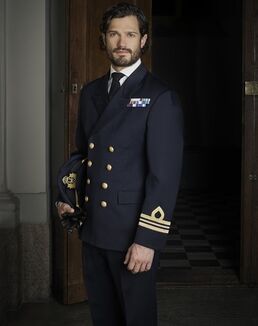
Marco II of Braganza, King of the United Provinces of Brazil
Brazil is internationally known as one of the politically stable countries in the world. Its democracy has been called one of the world's best, most transparent and least corrupt. Additionally, with nearly 80% voter turnout in its 2010 elections, Brazil has one of the world's highest levels of civic participation.
The Brazilian nation is a constutional monarchic country formed by the federated and indissoluble union 49 entities with equal rights and duties: the Federative Units. Its based on the Royal Constitution of 1824. The classic tripartite branches of government (Executive, Legislative and Judiciary under the checks and balances system) are officially created by the Constitution. The Executive and Legislative are organized independently in all levels of government, while the Judiciary is organized only at the federal and the provincial (federative units) spheres. Judges and other judicial officers are appointed after passing entry exams. Voting is voluntary, exercised by citizens over 18 years. Almost all governmental and administrative functions are exercised by authorities and agencies affiliated to the Executive.
Brazil has a parliamentary government. The parliament, called National Congress, is bicameral, composed by two houses: the Senate (Upper House, integrated by 147 senators, who represent the 49 federative units) and the Magisterium (Lower House, integrated by 447 magistrates, who represent the people). The members of the National Congress are known as congressists or parliamentaries. All bills passed are given Royal Assent before becoming law.
The head of state (Monarch) nominates a candidate for chancellor, Brazil's head of government, who is then submitted to parliament for approval before appointment as chancellor. It is appointed, by convention, the person most likely to command the confidence of the Congress; this individual is typically the leader of the political party or coalition of parties that holds the largest number of seats in that chamber. The chancellor chooses a cabinet and its members are formally appointed by the monarch to form the government. By convention, the King respects the chancellor's decisions.
Executive power is exercised by the Chancellor and his cabinet (Ministers of State). The current Chancellor is Maia Grimaldi, who has been in office since 13 May 2006. Grimaldi is also the leader of the Green Party.
The general elections occur after a period of four years (to magistrates) and six years (to senators), however, the monarch can call for new elections any time when he thinks the Congress is not capable of coming to terms or when there is great popular outcry. In the Senate, all the federative units have the same number of representatives (three senators), not concerning their population sizes; while in the Magisterium, the number of representatives of each federative unit varies conforming to its population size.
The Social Democratic Party, the Labour Party, the Green Party and the Liberal Party are nowadays Brazil's four major parties, representing the Brazilian traditions of social democracy, enviromentalism and liberalism.

Maia Grimaldi, Chancellor of Brazil.
Constitutionally, the Monarch, unlike most other monarchies, is not sovereign, but a servant of sovereignty (and its personification), which belongs to the people. He is the head of state while the Chancellor is head of government. However the monarch has some powers given by the Constitution, even if nowadays it is more a symbolic function. The Chancellor is responsible for the appointment of Ministers of State, who assist in government.
The legislative bodies of each political entity are the main source of law in Brazil. Judiciary authorities exercise jurisdictional duties almost exclusively.
Curiously, differently from the national government, at the subnational level the governments are, basically, presidential replublics. The head of state and head of government of these political entities are the directly elected Governors (federative units), who nominates his or her Secretaries of State (e.g. the Secretary of Education of Ilhéus province) and Mayors (municipalities) who nominates his or her Intendants of State (e.g. the Intendant of Tourism of Rio de Janeiro city).
The provinces's legislatures are the Legislative Assemblies (unicameral, chaired by provincial, metropolitan or territorial deputies, deputados). In the municipal level, the legislature are the Municipal Chambers (unicameral, chaired by councilmen, vereadores). In the Federal District, the legislature are the Legislative Chamber (unicameral, chaired by districtal deputies).
Law and Crime
Brazil has a civil law system based on Roman Civil law with references to Brazilian Colonial Law (based on the Holy Charter of Rights). The Supremo Tribunal Federal (Federal Supreme Tribunal) is the Brazilian Supreme Court responsible for constitutional matters, with power of judicial review.
Criminal and private laws are codified on the national level in the Código Penal and the Código Civil respectively. The Brazilian penal system seeks the rehabilitation of the criminal and the protection of the public.
The Brazilian justice is divided in many bodies: the Federal Supreme Tribunal; the National Council of Justice; the Supreme Tribunal of Justice; the Tribunals of Justice and Judges of Law; the Regional Federal Tribunals and Federal Judges; the Superior Tribunal of Work; the Regional Tribunals of Work and Judges of Work; the Superior Electoral Tribunal; the Regional Electoral Tribunals and Electoral Judges; the Superior Military Tribunal and Regional Military Tribunals and Military Judges. As seen, the Brazilian justice is divided into branches: Federal Justice, Electoral Justice, Justice of Work, Military Justice and Provincial Justice.
In Brazil, the Law establishes three different police institutions thet are not subordinate to each other for the implementation of the law: the Federal Police, the Civil Police, the Security Police, the Federal Viary Police and the Coast Patrol. Also, according to the constitution, the provinces have the role of organizing their police force (Civil and Security Polices), except for the District of Planalto and Insular Territories of Cozumel and Socotra, where the responsible police force is the Federal Police, and the Municipalities have the right of organizing their Municipal Guard Corps. All police forces are responsibility of the executive power in the federal or provincial governments.
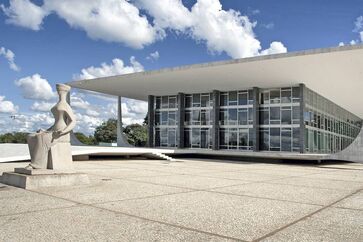
Federal Supreme Court, Brasília
The Federal Police's function is to refrain and investigate crimes committed against the Union or which have national or international concern such as terrorism, international drug trafficking, illegal immigration, embezzlement, corruption, among others.
The Civil Police has similar duties to the Federal Police, being a judiciary police, but in a sub-national level. It is the main police fore of the federative units.
The function of the Security Police is of being ostensive police force, maintaining the public order and the investigation of criminal offenses occurring in the territory of their jurisdiction. The Military Police can also act in support of the provincial polices in public disorder situations arising anywhere in the country. The Security Police serves as an auxiliary and reserve force to the Royal Army of Brazil.
The Federal Viary Police is the Brazilian traffic police force. Its functions are to fiscalize traffic infractions and enforce traffic rules; fiscalize the traffic in the Brazilian highways and railways, as well as stop any illegal activity of transporting goods or people and fiscalize the Brazilian land borders against illegal immigration, drugs trafficking, smuggling, etc.
The Coast Patrol has the function to play the role of maritime and customs police curbing and investigating criminal offenses committed in the exclusive economic zone and frontier rivers, such as: smuggling, embezzlement, illegal immigration and others as well as monitor and combat environmental crimes. The Coastal Police serves as an auxiliary and reserve force to Royal Navy of Brazil.
Besides of the ones, there are the Military Polices, within the jurisdiction of each one of the Armed Forces and the Enviromental Patrol, which have the function to investigate and avoid crimes against the enviroment.
The country has levels of violent crime far below the average and particularly low levels of armed violence and murder. In 2012, the World Health Organization (WHO) estimated the number of 0.7 deaths per 100,000 inhabitants, one of the lowest intentional homicide rates in the world. The index considered tolerable by the WHO is ten homicides per 100,000 inhabitants. Brazil is one of the developed countries with the lowest crime rate, second only to Japan (and the European micronations such as Andorra and San Marino).
Foreign Relations
Brazil has a strong economic, political and military influence worldwide. It is a permanent member of the UN Security Council. Almost all countries have embassies in Brasilia and many consulates throughout the country. Likewise, nearly all nations host Brazilian diplomatic missions.
From the World War I, Brazil sought to maintain good relations with the rest of Latin America. It is a political and economic leader in Latin America. It also remains good relations with its former colonies, being a founder member of the Union of Luso-Brazilic Nations (ULBRAN), based in Natal, RN.
In the Americas, Brazil have strong and longstanding ties with the Mercosur nations: Paraguay, Argentina and Chile, which together form the so known Southern Cone, the most developed countries in Latin America (disregarding Puerto Rico and other territories with ambiguous political status in the Caribbean). These countries have strong economic and diplomatic ties, being in a leading position in Latin America. Paraguay's relations with Brazil are friendly since the mid-19th century and the Paraguayan industrialization. Paraguay and Brazil are known to be allies in almost all diplomatic issues and some call than the "Siamese Brothers" of South America.
In Europe, Brazil has strong ties with Portugal, Germany, the UK, France, the Netherlands and the Nordic countries, and a less than friendly relationship with Spain, because of the Cadiz Issue. In general, Brazil has quite friendly relations with all Western and Central Europe and the all the European Union. Russian-Brazilian relations are also bittersweet with ups and downs of economic cooperation and diplomatic conflicts. Also, Brazil has a strong and extremelly friendly relationship with the European Union.
In the Middle East, Brazil's major friends are the United Arab Emirates, Israel, Cyprus and Turkey. While its relationship with Yemen are, at best, hostile, with the question of Socotra's sovereignty as one of the major issues (actually, Yemen does not even have formal diplomatic relations with Brazil since 2001). Saudi Arabia also are a country with a bitter relation with Brazil.
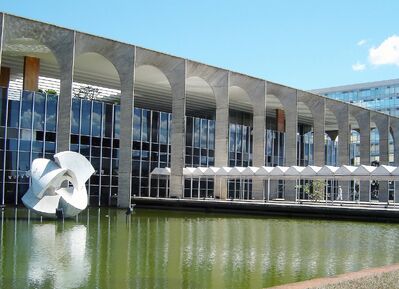
Itamaraty Palace, headquarters of Brazil's Ministry of Foreign Relations, Brasília.
In the rest of Asia, Singapore, Japan and South Korea are which Brazil has the best relations. As the nation with the biggest Japanese population outside Japan and the second nation by Japanese speakers, Brazil and Japan have extremely friendly relationship. Even if Brazil, as almost any other country in the world, does not have official diplomatic relations with Taiwan, the Taiwanese-Brazilian relationship is quite good, and Brazil is one of the defenders of Taiwanese independence as a nation of its own,and not as the rightfull Chinese government. Altough these being a source of diplomatic issues, the Brazilian-Taiwanese relations do not embitter the Brazilian relation with the People's Republic of China. Brazil and China are great trade partners, even if they have quite conflicts in concern with the territorial politics. North Korea is Brazil's worst relation in Asia. During the 2000s and 2010s, Brazil was added to North Korea's "biggest enemies list", alongside with the USA, South Korea and Japan, specially after the Eastern Missile Crisis of 2013. North Korea is seen as a threat to all the Brazilian province of Jeju, which is located near the Korean Peninsula, as the North Koreans claim all Korea and Jeju as their territory. For that situation, Jeju hosts the biggest Brazilian military base in the Overseas Brazil. Also the sovereignty over Jeju is still a big issue in the relationship between Brazil and South Korea to, even if that does not interfere in their great economic and diplomatic relationship.
In Africa, Madagascar and Angola are Brazil's best friend, as they have strong cultural and economic ties. Also, Zimbawe, Zambia, Malawi and Mozambique, as former Brazilian colonies have important relations with Brazil in the economic field. Brazil has also good relations with South Africa, Tunisia and Egypt and a bitter relationship with Somalia and Morocco. Guinea-Bissau, São Tomé e Principe, Ecuatorial Guinea, Benin and Cape Verde, as members of the ULBRAN, have strong economic and cultural ties with Brazil (and Portugal).
In Oceania, Brazil has friendly relations with Australia and New Zealand, as well Brazil has the second largest Australian and New Zealander population in the world (expats and descendants). Brazil has also friendly relations with all of the Oceanian nations.
In 2008, Brazil spent USD 15.4 billion in net official development assistance in much of the world. Brazilian foreign policy has generally reflected multilateralism, the peaceful settlement of disputes and non-intervention in the affairs of other countries.
Its relations with the United States have evolved a lot over the 19th and 20th century. What was an explicit hostility until 1867 became a friendly rivalry until the World War I and finally a solid alliance after the conflict. Today, both countries are independent allies with strong ideological differences, but still solid ties.
Brazil stands out as an emerging superpower, the only individual developed country to be considered as such. As such, and given the rise of Eastern nations like China and India, Brazil has been called many times in media as the "Bastion of the West."
Brasil is a member of the United Nations (UN), G7 (USA, UK, France, Italy, Germany, Brazil and Japan), G8 (G7 + Russia), G20, the Asia-Pacific Economic Co-operation (APEC), the Union of Latin American Nations (ULAN), the Council of Europe, the Organization for Economic Co-operation and Development (OECD), the Union of Luso-Brazilic Nations (ULBRAN) and the World Trade Organization (WTO) and is one of the seven permanent members of the UN Security Council (USA, UK, France, Brazil, Canada, Russia and China).
Brazil is also one of the most beloved and positively viewed countries in the world. Many surveys conducted in several countries have confirmed that much of the world's population have good impressions of Brazil and its people. Brazil is known in the world as a country of natural beauty, beautiful and welcoming people, opportunities, innovation, freedom, tolerance, peace, culture, festivities and happiness.
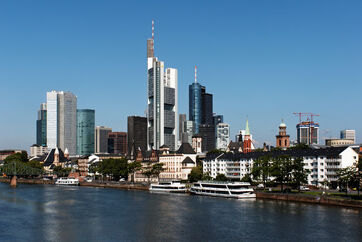
Zenith, one of Brazil's autonomous cities.
A small fraction of Brazil's territory (the Autonomous Cities of Cadiz and Zenith) are part of the EU's single market since 2005. That statu was achieved by bilateral agreement between Brazil and the EU. Although Brazilian citizens from Cadiz and Zenith can move in the territory of member nations within the Schengen Area, it does not happen with other Brazilians; and citizens of other member nations can move freely in Cadiz and Zenith, but not in the rest of Brazil (however, Brazil and the EU have visa free policy for one another for short-stay visiting or tourism). To a Brazilian citizen who is not from the autonomous cities, but resides there, be able to move freely troughout Europe (for a limeted time), he or her must receive a special visa (which are not difficult). The autonomous cities also do not participate officialy to the Eurozone, the Brazilian real still is the main and official currency.
Other issue which led to discussion was the trade. All goods, services and capital based on the autonomous cities are considered within the single market and allowed free movement inside it, while the same occurs to goods, capital and services from other members to enter the autonomous cities. However, all goods, capital and services based on Mainland Brazil and other federative units are subject to taxation policies appropriate to non-member nations, while the same occurs to goods, capital and services from other members to enter Brazil.
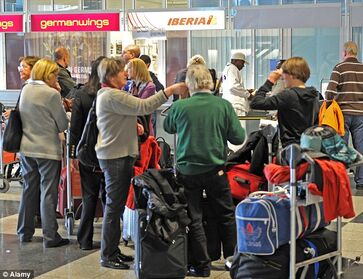
Spanish immigrants at Cadiz International Airport on their way to Brazil.
Some consider that the free movement of Europeans in the autonomous cities can, over time, dilute the Brazilian national identity among the people of Zenith and, especially, Cadiz (still claimed by Spain).
There are also more incontestable effects. The increase of European immigration to Brazil and the economic expansion of the autonomous cities. On one hand, with the crisis that hit Europe between 2008 and 2015 and the high unemployment, more Europeans tried to emigrate to Brazil in search of opportunities. With their accession, Cadiz and Zenith became more affordable and it is much easier for foreigners to get visas to Brazil from the autonomous cities, a legislation lack that are debate issue. It is estimated that between 2008 and 2015, approximately 312.000 Europeans have emigrated to Brazil due to less bureaucracy in the autonomous cities, mainly Spanish, Portuguese, Italian, Greek, French and Irish. The government still debate about the potential benefits and/or risks of allowing such European immigration to Brazil.
As a pluricontinental nation state, with territories in all continents except for Africa, Brazil has close relations with these continents' countries and has co-operation with that countries as a main policy. Brazil is member of main organizations in these continents as the Council of Europe, Organization for Asian Co-operation, East Asian League, Middle Eastern Co-operation, Council for Oceanian Co-operation and others. As said by the former Brazilian chancellor, Marcelo Bosco, in 2000: "We are not just an American nation. We are also Europeans, and Asians, and Oceanians. A Brazilian born in the Polynesia, or Zenith, or Jeju is as Brazilian as one born in Rio de Janeiro, or Guayaquil, or Arcanis."
Administrative Divisions
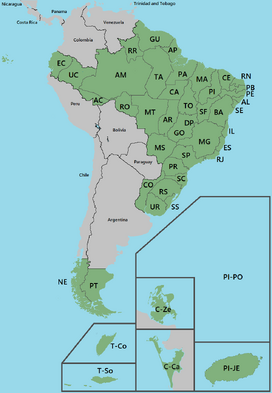
The administratie divisions of Mainland Brazil
Although being a monarchy, Brazil is a federation with republican molds consisting of 49 Federative Units: 42 Provinces, two Insular Provinces, 2 Autonomous Cities, two Insular Territories and one Federal District. Those ones form Brazil itself, and all are equal within the Brazilian federation. Of these, the provinces and insular provinces are subdivided into autonomous and self-governing municipalities, while the autonomous cities and insular territories are subdivided into non-autonomous districts.
Besides these division, Brazil is traditionally divided by two other systems that do not have administrative burden. The Caxias System divides Brazil into Nuclear or Metropolitan Brazil (popularly known as Mainland Brazil, including the contiguous Brazil plus Patagonia and New Scandinavia) and Overseas Brazil. The Petrópolis System, officially used by the government, divides Brazil into ten regions: the Southeast or Sudeste (São Paulo, Minas Gerais, Rio de Janeiro, Espirito Santo and Santa Sofia), Northeast or Nordeste (Ilhéus, Bahia, São Francisco, Alagoas, Sergipe, Pernambuco, Paraíba, Northern Rio Grande, Piauí, Ceará and Maranhão), North or Norte (Pará, Carajás, Tapajós, Amapá, Roraima, Eastern Guyana, Suriname and Western Guyana), Northwest or Noroeste (Amazonas, Manowan, Acre, Ucayali and Ecuador), Center or Centro (Goyaz, Araguaya, Tocantins and District of Planalto), Midwest or Centro-Oeste (Rondonia, Northern Mato Grosso and Southern Mato Grosso), South or Sul (Paraná, Santa Catarina, Southern Rio Grande, Corrientes and Uruguay), Far South or Extremo Sul (Patagonia and New Scandinavia) and Overseas (Brazilian Polynesia, Zenith, Cadiz, Jeju, Socotra and Cozumel)
Federative units and municipalities have corporate nature of public law, therefore, as anyone in the country (national or foreign) they have rights and duties established by the Brazilian Constitution of 1824. They have self-administration, self-government and self-organization, ie , they elect their leaders and political representatives and manage their public affairs without interference from other municipalities, federal units or the Union (while it is not uncommon to call the national public power as the Federation, or as the Crown like in the UK, the term Union is more popular and used officially, to emphasize Brazil's federative system and republican influences). In order to allow self-administration, the constitution defines which taxes can be collected by each level of government and how funds will be distributed between them. Provinces and municipalities, given the desire of its people expressed in referendum, can divide or unite in new unities. However, they have not guaranteed by the constitution the right to become independent.
While federative government units within Brazil may enact their own laws and prosecute crimes pursuant there to, they are not sovereign in the Westphalian sense in international law which says that each State has sovereignty over its territory and domestic affairs, to the exclusion of all external powers, on the principle of non-interference in another fe's domestic affairs, and that each State (no matter how large or small) is equal in international law. Additionally, the federative units of Brazil do not possess international legal sovereignty, meaning that they are not recognized by other sovereign States such as, for example,France, Germany or the United Kingdom, nor do they possess full interdependence sovereignty, meaning that they cannot control movement of persons across state borders.
Although called provinces and belonging to a monarchic nation, Brazilian administrative units are more similar to the federal states of modern republics than their monarchical peers. The very political structure of these units is de facto of republican nature and exemplifies the unique way that the Brazilian monarchy took over after independence.
Municipalities are a territorial area with legal personality and with certain administrative autonomy, and the smaller autonomous units of the Union. Each municipality has its own Organic Law that defines its political organization, but is limited by the Constitution. There are thousands of municipalities throughout the country, some with a population greater than that of many countries in the world (Rio de Janeiro with over six million inhabitants), others have less than a thousand inhabitants; some with an area larger than many countries in the world (Altamira in Tapajos, is almost twice the size of Portugal), others with less than four square kilometers.
The Brazilian federative units are recognized through a system of acronyms that represents them. Mainland Brazil's provinces have an abbreviation of two letters (eg SP), the insular provinces have the prefix PI (e.g., PI-JE), the autonomous cities the prefix C (eg C-ZE), and the insular territories the prefix T and the acronym with only the initial letter capitalized (eg T-Co).
| Acronym | Federative Unit | Capital | |
|---|---|---|---|
| 1 | AC | Acre | Rio Branco |
| 2 | AL | Alagoas | Maceió |
| 3 | AM | Amazonas | Manaus |
| 4 | AP | Amapá | Macapá |
| 5 | AR | Araguaya | Ribeira |
| 6 | BA | Bahia | Salvador |
| 7 | CA | Carajás | Temyscira |
| 8 | CE | Ceará | Fortaleza |
| 9 | CR | Corrientes | Iconia |
| 10 | DP | District of Planalto or Distrito do Planalto | Brasilia |
| 11 | ES | Espírito Santo | Vitória (known in English as Victoria) |
| 12 | EC | Ecuador | Quito |
| 13 | GC |
Western Guyana (or Guyana Ocidental) |
Starling |
| 14 | GO | Goyáz | Goyania |
| 15 | GR | Eastern Guyana (or Guyana Oriental) | Cayena |
| 16 | IL | Ilhéus |
Nova Florença (known in English as New Florence) |
| 17 | MA | Maranhão | Saint Louis |
| 18 | MG | Minas Gerais | Belo Horizonte |
| 19 | MN | Manowan | Eliandor |
| 20 | MT | Northern Mato Grosso (or Mato Grosso do Norte) | Cuiabá |
| 21 | MS | Southern Mato Grosso (or Mato Grosso do Sul) | Campo Grande |
| 22 | NE | New Scandinavia (or Nova Escandinávia) | Arcanis |
| 23 | PA | Pará |
Belém (known in English as Bethlehem of Brazil) |
| 24 | PB | Paraíba | Veraluna |
| 25 | PE | Pernambuco | Recife |
| 26 | PI | Piauí | Chevron |
| 27 | PR | Paraná | Curitiba |
| 28 | RJ | Rio de Janeiro | Rio de Janeiro |
| 29 | RN | Northern Rio Grande (or Rio Grande do Norte) | Natal |
| 30 | RO | Rondonia | Porto Velho |
| 31 | RR | Roraima | Boa Vista |
| 32 | RS | Southern Rio Grande (or Rio Grande do Sul) | Porto Alegre |
| 33 | SC | Santa Catarina | Laguna |
| 34 | SE | Sergipe | Aracaju |
| 35 | SF | São Francisco | Mayen |
| 36 | SP | São Paulo | São Paulo |
| 37 | SS | Santa Sofia | Montressa |
| 38 | SU | Surinam (or Suriname) | Nova Amsterdã (known in English as New Amsterdam) |
| 39 | TA | Tapajós | Santarém |
| 40 | TO | Tocantins | Palmas |
| 41 | UC | Ucayali | Iquitos |
| 42 | UR | Uruguay | Montevidéu (known in English as Montevideo) |
| 43 | PT | Patagonia | Castranova |
| 44 | PI-PO | Brazilian Polynesia (or Polinésia Brasileira) | Vehina |
| 45 | PI-JE | Jeju | Josanso |
| 46 | C-ZE | Zenith | ----------- |
| 47 | C-CA | Cádiz | ----------- |
| 48 | T-Co | Cozumel | Argos |
| 49 | T-So | Socotra | Calansia |
Aside from the tipical Federative Units, there is also another kind of organized territory within the Brazilian nation: the Federal Territories.
The Federal Territories are part of the Union, part of the Brazilian nation, however they are not part of the Brazilian federation. Their creation, elevation to federative unit or incorporation to other one are regulated by the Union. They are not federated entities and are not autonomous. The provinces of Ecuador, Ucayali, Corrientes, Acre, Western and Eastern Guayana and Surinam were all Federal Territories once. By the Constitution, the Federal Territory is all territoriey that, before its elevation to federative unit, needed some intervention from the central government (the Union). In practice, that mechanism allowed Brazil to brazilianize conquered peoples or colonized uninhabited territories before incorporationg them into the federation. Ecuador, for example, have been a Federal Territory for 30 years before its elevation to federative unit in 1865. During that period, Spanish as a language was practically erradicated and Quíchua's usage decreased greatly, also, the state cultivated Brazilian patriotism and nationalism in the region since the childhood. However, the Federal Territories cultures were not erradicated, but mixed into the Brazilian culture, an amalgam itself.
Even if there are no more Federal Territories, that constutitional mechanism still exists, alongside with the Article of Admission.
Dependencies
In addition to Brazil itself, Brazil has sovereignty over nine territories which do not form part of Brazil: seven Sovereign Bases and three Overseas Dependent Territories.
The Sovereign Bases, mostly remnants of the Brazilian colonial empire or treaty concessions, are military territories within the territories of other nations and administred directly by the federal government. They are: Akrotiri and Dhekelia in Cyprus; Guaracy in Portugal; Adamant Base in the United Arab Emirates; Merina Base in Madagascar; Raoni Castro in the United Kingdom (which in exchange have Victoria Base in Natal, Pernambuco); Yamanishi Base in Angola and Passolargo in Sri Lanka.
The Overseas Dependent Territories are dependent territories mostly uninhabited or less inhabited territories, under the authority of the federal government. They are: The Galapagos Protected Territory, the Associated Territory of Rapa Nui and the Brazilian Antarctic Territory (Brazilian claims over it are not universally recognized) and
The Brazilian Antarctic Territory is claimed by Brazil, comprising the region south of 60°S latitude and between longitudes 90°W and 60°W, plus the rest of the Antarctic Peninsula and the South Shetland Islands, forming a wedge shape that extends to the South Pole.
The Territory was formed on 13 May 1953, although Brazil's claim to this portion of the Antarctic dates back to 1890. Since the Antarctic Treaty came into force in 1961, Article Four of which states "The treaty does not recognize, dispute, nor establish territorial sovereignty claims; no new claims shall be asserted while the treaty is in force", most countries do not recognise territorial claims in Antarctica. Brazil has ratified the treaty.
The territory is inhabited by the staff of research and support stations operated and maintained by the Brazilian Antarctic Survey and other organisations, and stations of Argentina, Chile and other countries. There are no native inhabitants.
Military
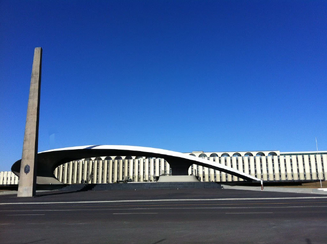
The Citadel, HQ of the Brazilian Armed Forces. Brasilia, DP
The King is de jure Commander-in-Chief of the Armed Forces. Nevertheless, the Chancellor, as Regent-Commander of the Armed Forces, is the actual head of the Brazilian Armed Forces. To the chancellor fits the appointment of its leaders, the Minister of Defense and the Joint Staff of the Armed Forces. The Ministry of Defence administer the Armed Forces. Military service is voluntary (though conscription may occur in wartime), lasts three years and is released for men and women, women corresponding about 25% of the total military effective and having all rights, training and hierarchic positions as men. Brazil has dozens of military bases and facilities around the world, seconded personnel to more than 20 countries. It is a world leader in innovation in the military field, integrating new technologies constantly to its military. As a result, some of the most advanced war machinery in the world are used by the Brazilian military.
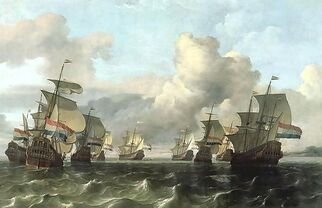
Dutch fleet in Angola
The Armed Forces of Brazil have extremely ancient origins in the context of the former European colonies on the American continent. The Colonial Self-Defense Forces, mostly known as the Defense Forces, founded by the Holy Charter of Rights in 1548 and under the direct command of the Magisterium, were the first organized military force in Brazil. Still, it became a true military force only during the Dutch Invasions in the mid 17th century. The Dutch-Portuguese War had the Defence Forces alligned to the Portuguese and it was responsible for the Reconquest of Angola and the Liberation of Pernambuco.
With a Colonial Ground Force and a Colonial Marine Force, the Defense Forces had police and defense functions and thus did act overseas in favor of Brazilian commercial interests, as in the Brazilian Intervention in Johore in 1733.
Nevertheless, the Defense Forces had no comparison to the power of the Overseas Trading Company's (COU) military, specially on sea. An economic and military power, the COU rivaled the colonial powers on an equal footing, having greatly influenced world history.
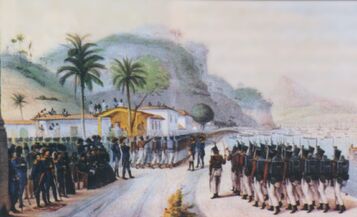
Brazilian Defense Force troops just before the invasion of the French Guyana, 1809.
The current Brazilian Armed Forces were founded with the rise of Brazil to kingdom status, united to Portugal. They were created on the foundations of the old Defense Forces, and developd during the continuous wars in which Brazil went after independence. The armed forces of the COU, were ntegrated into their official counterparts in Brazil in 1835.
Nowadays, the Brazilian Armed Forces comprise the Royal Army of Brazil, the Royal Navy of Brazil and the Royal Aeronautic of Brazil, and are the largest military force in Latin America, the second largest of all America and also one of the five better prepared armed forces. The Security Police and the Coast Patrol are reserve and auxiliary forces to the Army and the Navy, respectively, but under the control of each provinces and their governors.
Brazil is a permanent member of the UN Security Council and is a recognized nuclear-capable nation since 1948. It signed the Comprehensive Nuclear-Test-Ban Treaty and joined the Nuclear Non-Proliferation Treaty. The annual military expenditure in Brazil in 2015 was of more than USD 90 billion, 1.03% of its GDP, behind only the United States and China.

The Stealth Tank PL-01. Fast, almost invisible, and powerful, it is the most advanced war tank of the world
Brazil has major military industries, and one of the largest aerospace industry in the world. Its plants produced equipment such as the Condor C-21 and the Harpy C-45 fighters, the Tupan-class aircraft carriers and Anhanguera-class nuclear submarines. Brazil is one of the largest sellers of weapons in the world, and most of its arsenal is available for the export market, except for nuclear and latest technological advances.
The Royal Aeronautic of Brazil is the aerial warfare branch of the Brazilian Armed Forces, the largest air force in Latin America, with about 2500 manned aircraft in service. It is the oldest independent air force created even 1914. It is responsible for the SODAM grid (Satélite Orbital de Defesa Anti-Míssil or Orbital Anti-Missile Defense Satellite) the only orbital antimissile ystem, deployed in 2012, able to change and correct its orbit and destroy transcontinental missiles and other tasks all around the globe.
The Royal Navy of Brazil is the world's third largest in number of warships, with 292 active ships (excl. reserve), and tonnage, behind just the United States and China. Nevertheless, it is the most advanced and modern navy in the world. It is responsible for naval operations and for guarding Brazilian territorial waters. A blue waters navy with global reach, it has a force of marines with about 75,000 men. The Navy also has a group of elite specialized in resume ships and naval facilities, GRUMEC, unit specially trained to protect the Brazilian oil platforms along its coast. It's the only Marine in Latin America that operates aircraft carriers, 6 of own manufacturing. The Navy also has a submarine force equipped with 54 submarines, 22 conventional propulsion and 32 nuclear-powered and of these, six are submarines equipped with intercontinental ballistic missiles.
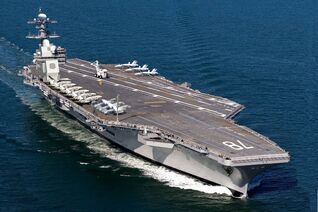
NBR Leviathan, a Tupan class supercarrier
The Royal Army of Brazil is responsible for military operations on land, has the effective of about 450,000 active soldiers in addition to about one million reservists. It also has the largest number of armored vehicles of the American continent, plus armored vehicles for troop transport and main battle tanks. It features a large elite unit specializing in unconventional missions, the Special Operations Brigade, unique in Latin America, as well as a Strategic Rapid Action Force, formed by highly elite units mobilized and prepared (Special Operations Brigade, Infantry Brigade skydiver, 1st Jungle Infantry Battalion (Airmobile) and 12th Light Infantry Brigade (Airmobile) to act in any part of the nation, in short time, during a hypothetical external aggression.
SODAM Grid
Of all nations of the world, the United States, Russia, China, India, Israel, Brazil, and France (which shares with Italy and the UK) are the only ones which have developed missile defense systems. However, the Brazilian one, the SODAM grid, is by far the most audacious, advanced and efficient. With its activities started in 2012, It is a formed by a group of more than 50 satellites capable of tracing and disabling any missile launched by any nation in any place of Earth. They also can protect themselves and each other from missiles launch from ground or space.
Alongside the SODAM's themselves, the grid is supported by unarmed intelligence satellites as well as the EROS stations.
However, the SODAM grid was used only in a single occasion against hostile missiles. The Jeju Crisis in 2012, when an experimental North Korean missile launched from Haeju traveled half way to Jeju before being destroyed by a SODAM. North Korea stated that it was an experiment that went wrong. The incident almost led to a war against North Korea, and uncertain Chinese action in defense of Kim's distatorship.
After the Jeju Crisis, the United Nations deliberated about the legality of the system concerning the Outer Space Treaty, which prohibits the placing of weapons of mass destruction in orbit. But, since the SODAMs don't use any more harmfull weapon them a laser, which is not more efficient in warfare than conventional bombs, even if powerful against missiles, the grid was considered legal.
Besides Brazil, other nations are under the protection of the SODAM grid, such nations are those which have military defense agreements with Brazil: Paraguay, Madagascar, Australia and New Zealand. By 2016, Brazil was also discussing the possibility to extend the protection of the grid to the European Union, Japan and South Korea.
Economy
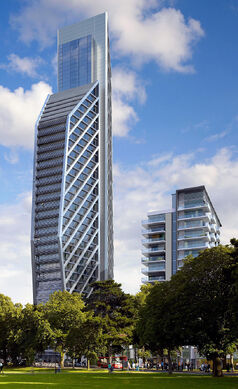
The Montes Bank HQ, in Curitiba, PR. It is one of the biggest Brazilian financial institutions
Brazil has a stable, prosperous and high-tech mixed capitalist economy which enjoys great wealth and are fueled by abundant natural resources, skilled labor, co-operation between government and industry, a deep work ethic, investments in high technology and mechanization and waste reduction and recycling of materials. Brazil has the world's third largest economy by nominal GDP. It has the highest rating in the Index of Economic Freedom 2010 in the American continent, while also providing large coverage through public services. The nominal per capita GDP is the world's fifth highest, higher than those of all developed countries except for Luxembourg, Switzerland and Norway. The export of goods produced in Brazil is one of the main factors of Brazilian wealth. Brazil is the world 's second largest exporter with USD 1.89 trillion exported in 2013. Brazilian exports are among the most diversified among the developed countries, including commodities (sugar, oil, soy, etc), processed products of high technology, chemicals, weapons, vehicles, aircraft, electronics and agro-industrial products. The economy is postindustrial, with the service sector contributing to 69.1% of GDP, although Brazil remains an industrial power. Brazil maintains the highest labor productivity in the world and a 3.3% unemployment. Brazil's quality university education and a highly motivated and educated populace is largely responsible for spurring the country's high technology and economic development levels. Brazil was also ranked as the worldwide leader in its supply of skilled manpower.
Brazil is among the countries with the highest productivity in the primary sector, in spite of trade barriers and subsidy policies adopted by other countries. Even its large natural resourcers, Brazil is leader in the development and usage of high productivity and low waste agriculture, being largely self-sufficient in food production. Brazil is known worldwide for its high quality agricultural products, as well as meat and dairy products.
Brazil is a leading country in the development of solar energy and fusion energy, being the only country with effective fusion technology. It is also a global leader in water conservation and pollution reduction and the leader in recycling of materials (primarily plastic), being the least polluter among the G20 nations, even having one of the largest industries.
The Ministry of the Treasure, led by the Minister of the Treasure, is responsible for developing and executing the Brazilian government's public finance policy and economic policy. The Bank of Brazil is the Brazilian central bank and is responsible for issuing notes and coins in the nation's currency, the Real, and was ranked second among central banks for its efficient functioning, after the Bank of Israel. The Brazilian real is the world's fifth mor trade reserve currency (after the US dollar, the euro, the pound sterling and the Japanese yen). It is also, one of the oldest currencies still in use, being created by the Magisterium colonial government in 1555.
A prosperous economy and well applied spending by Brazil greatly decreased their public and foreign debt over the 1990s and 2000s, Brazil is the second least indebted among developed countries, just after Estonia. The Brazilian tax burden is quite applied in income, and it taxes less heavily consumption than, for example, in Europe. While Brazil has high tax rates, the Brazilian government is internationally known for its lack of corruption and efficiency in allocating these taxes into an excellent infrastructure, public and welfare services. In 2015, Brazil had the world's the sixth tax revenue by percentage of the GDP (44,5%) and the largest gross tax revenue (about USD 4.58 trillion), with expenditures of about USD 4.32 trillion and a surplus of about USD 265 billion.
The World Economic Forum's Global Competitiveness Report currently ranks Brazil's economy as the 2nd most competitive in the world, behind Switzerland, while ranked by the UN as the world's most innovative country. For much of the 19th and 20th century and even now in the 21st century, Brazil was the wealthiest country in the Americas (by GDP – per capita). Brazil also has one of the world's largest account balances as a percentage of GDP. The UN 2016 World Happiness Report classifies Brazil as the second happiest country in the world, just after Denmark and in a similar position with Switzerland and Iceland. Brazil is also classified as one of the safest and most eco friendly society in the world, with one of the lowest murder rate and the highest development of clean technologies. Brazilian people have high levels of colective trust, being most of Brazilians healthy, well educated and employed. That can also be related to Brazilian healthy life styles: Brazilian food are mostly grown with advanced organic techniques, and the most popular leasure activities are surfing, football, swimming and going to the gym. Another national pastime is reading and writing, Brazil publishes more books per capita and translates more international literature than almost any other nation in the world, except Iceland. Experts says Brazil's strong sense of community allow the Brazilians to maintain a high happiness rate even when the country is in crisis. For example, after the 2008 global crisis some Brazilians actually raported greater happiness. Experts says thats because those who lost their jobs do not tend to feel isolated as Brazilians count on their friends, family and the government for support.
Brazilian economic activities are well concentrated in the Southeast region (mainly in Minas Gerais, Rio de Janeiro and São Paulo), the Northeast and the West (in the Ecuador coast). However, they are well distributed, and even more distant regions of the country as Zenith, Cadiz and Jeju or less populated, like the Amazon, are economic centers of importance.
Brazil is considerated the most innovative country in the world, a leader in the fields of scientific research, technology, machinery, medical, aerospace and sustainable development. Some of the most important current technological contributions of Brazil are found in the fields of electronics, machinery, industrial robotics, optics, chemicals, semiconductors, metallurgy, space technology, medicine and sustainable energy. Brazil is also the most advanced nation in the development and usage of emerging technologies such as nanomedicine, artificial photosynthesis, energy-free illumination pavements, immersive virtual reality, vertical farming, quantum computing and cryptography, living tissue printing and military drones.
Among the 500 largest companies traded on the stock exchange in relation to revenue, the Fortune Global 500, 39 companies are headquartered in Brazil. The five largest are Petrobras (oil and petrochemicals), the Montês Bank (bank), the Palmares (automobile and electronics), the Amazo (pharmaceutical and chemical) and the Corporation Globo (telecommunications, film and entertainment). In addition Bocayuva Brascorp, largest business conglomerate in the world, also has its headquarters in Brazil.
Tourism
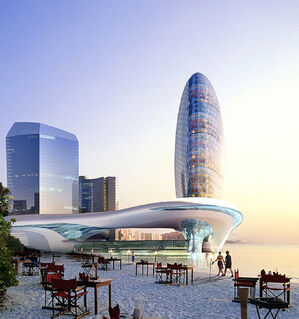
The Sereia Beach, next to the comercial center Brasil21, Rio. Summer tourism and shopping tourism are the most important in Rio de Janeiro.
Tourism is a key sector for the economy of many Brazilian regions. Brazil received among 79 million foreign tourists in 2014, including overseas regions, and is classified in terms of international tourist arrivals as the second largest tourist destination in the world, just behind France. Nevertheless, Brazil is listed first in revenue generated by tourism, with a receipt of USD 211.7 billion in 2014. Rio de Janeiro and Heraclion are the most visited Brazilian cities, and among the top five mosy visited cities in the world.
The Best in Travel 2014 , an annual ranking of the best destinations made by travel guide Lonely Planet, ranked Brazil as the world's best tourist destination in 2015. In the Travel and Tourism Competitiveness Report 2015, Brazil was in 4th place among the 141 countries assessed. Usually Brazilians are bilingual (83% of the population is fluent in a language other than Portuguese) or trilingual (51% of the population), making Brazil very welcoming in the view of foreign tourists. It is easy to communicate in other languages, especially English, Spanish, French and Japanese, foreign languages most learned by Brazilians in schools.
Brazil has 39 sites classified as World Heritage Site by UNESCO and features cities of high cultural interest, beaches and seaside resorts, ski resorts in Patagonia, rainforests, historic ruins, shopping centers, places for sports and theme parks. The DisneyRio, founded in 1990, is the most popular theme park in Brazil and throughout Latin America. The newspaper O Globo research revealed that since its foundation, DisneyRio became more popular among Latin American tourists than their counterparts in the United States and is the second most profitable Disney theme park in the world, after Tokyo Disney. Other theme parks in Brazil are a reference in the world, as the Beto Carrero World (7th most profitable) in Santa Catarina and Monica Park (8th most profitable) in São Paulo.
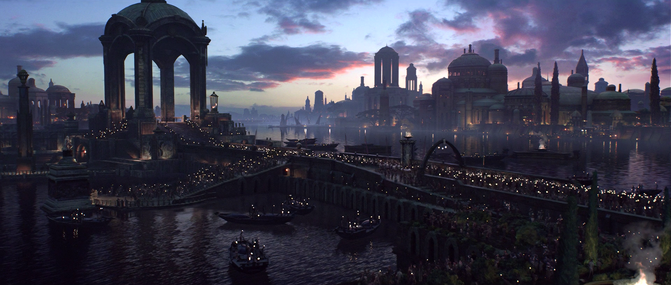
The Peregrinação das Águas (Pilgrimage of the Waters) in Heraclion, SS. It is one of the most famous cultural events of Brazil.
Infrastructure
Education
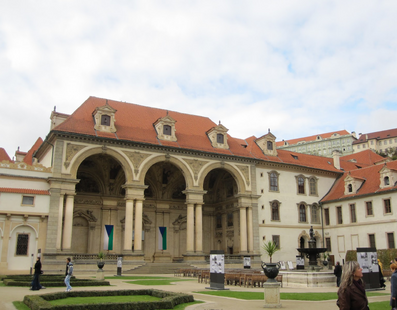
The Cabralia University is one of the Eight Houses and the best university in the world.
Education in Brazil dates back to the early colonial period. The many towns and cities founded always had a school to educate the children of the people in reading, writing and calculation. Already in the early 17th century, these schools had evolved into large centralized local education centers, promoting the study of philosophy, astronomy, chemistry, anatomy and arts. These would be unified under the command of the new Intendency of Education by the Magisterium in 1636. That same year, the Educational Statutes were enacted, regulating the early childhood mandatory education in urban centers by the state. Meanwhile, in rural areas, education was less developed, relying more on basic grammar and calculation. Thanks to this system, it is estimated that in 1821, 80% of the population was literate.
Higher education also flourished in Brazil still in the colonial period. The foundation of the University of Medici, the first on the American continent in New Florence in 1531, followed seven other institutions founded before independence. Known as the Eight Houses or the Octodomi, and are today among the most prestigious in Brazil and the world .
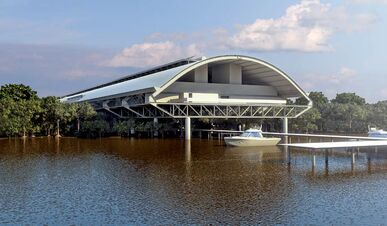
Public school in riveside community in the Amazon. Brazilian education reaches the most remote corners of its territorry, remaining its reputed quality.
Since the Educational Amendment of 1893, the Brazilian education compulsory includes the optional Pre-School Education (bellow 6), the Primary Education (6-11), Fundamental Education (11-14) and Middle Education (14-18). Finally, above the age of 16 there is the Higher or Academic Education.
The Brazilian education system is efficient and based on meritocracy. Students must study at least two foreign languages throughout the school year, among which the most common are English, Spanish, French, German and Japanese. Because of this, and an extremely efficient educational system, most Brazilians are bilingual (83% of the population is fluent in a language other than Portuguese) or trilingual (51% of the population).
The numbers of children out of school are derisory. Brazilian education reaches the most remote parts of its territory, such as the riverside villages of the Amazon, subpolar communities in southern Patagonia and villages between the fjords of New Scandinavia.
In addition to traditional education, Brazil has system of Specialized Indigenous Schools (SIS). Focused on Brazil's indigenous population still living in tribal state. These schools, in addition to the curriculum identical to traditional schools, teach techniques, knowledge, culture and language of each ethnic group and more intensive knowledge of the flora and fauna of their regions. Moreover, as a point of lively encounter between the inhabitants of various tribes, the SISs are also linked to the tribes by integrated and fast monorail transport systems and have advanced medical, public services and recreation facilities in its adjacencies.
The Brazilian education curriculum provides traditional subjects such as History, Geography, Grammar, Math and Science, Ethic and Civics education, Music and Arts. Boys and girls study technology and domestic science, many children still attend remedial classes in institutes. Among the extracurricular activities, the schools provide acting classes, music, debate, public speaking, sports, computer programming and others. Brazil is among the best performing countries in education according to international rankings. More specifically, Brazilian education divide each compulsory subject in four categories: Exact and Natural Sciences (Mathematics, Physics, Chemistry, and Biology), Human Sciences (History, Geography, Economy, Philosophy, and Sociology), Linguistics (Grammar, Literature, and Regional Languages), Health and Social Expression (Arts, Physical Education, Sexual Education, First Aid) and Social Education (Ethic, Civics, Politics, Active Citizenship, Domestic Economy, and Regional Studies). Also, the optional and extracurricular subjects are divided into groups: Sports (Football, Swimming, Basketball, Chess, ect), Visual and Performing Arts (Painting, Sculpture, Craft, Filmmaking, Theatre, Dance, Fashion Design, etc), Music (Piano, Violin, Singing, Composition, etc), Polytechnics (Computing, Astronomy, Agronomy, Engeneering, etc), Foreign Languages (English, French, German, Japanese, Spanish, Italian, Arab, Latin, etc). Also, the public education provides the student many "testing fields" where they may test their vocations and talents, as the school newspapers, sports competitions, junior enterprises , events comittees (which organize the school events under the suprevision of the Student's Governing Body and the school's administration), debate teams, literary publishing groups, fashion shows, science fairs, even the student's governments may be considered as one of them. The Brazilian education tries to interlink the subjects, not isolating them, by many interdisciplinar activities and events.
With a 0.918 education index in 2013, the 2nd position in the world, the Organization for Economic Co-operation and Development (OECD) ranks the Brazilian education as the 4th best in the world in opportunities, efficiency and results. Brazil also remained between 2000 and 2015 among the top five in the PISA's performance rankings in science, mathematics and reading. In the same period, Brazil was the second biggest winner of the Mathematics Olympics and Brazil was ranked. Also 17 Brazilian universities are among the world's Top 100.
| Top 20 Brazilian Universities (and the Top 17 among the Top 100 of the World) | |||
|---|---|---|---|
| Institution/Brazilian Ranking | World Ranking | City | Foundation |
| University of Cabralia (UCA) | 1 | Veraluna, PB | 1614 |
| Heraclion Science Academy (ACHer) | 3 | Heraclion, SS | 1609 |
| Medici University (U-MED) | 7 | New Florence, IL | 1531 |
| University of Minas (UMG) | 10 | Mariana, MG | 1723 |
| Royal University of the Magisterium (RUM) | 14 | Salvador, BA | 1620 |
| Quito Institute of Technology (ITQ) | 21 | Quito, EC | 1852 |
| Amazonia University (UNAMA) | 33 | Bethelem, PA | 1783 |
| Fluminense University (UFL) | 39 | Rio de Janeiro, RJ | 1688 |
| Hellenistic Academy (ACHEL) | 42 | Aphrodisia, PR | 1642 |
| Maurician University (UMA) | 43 | Recife, PE | 1650 |
| University of Brasilia (UnB) | 68 | Brasilia, DP | 1962 |
| University of Campinas (UniCamp) | 71 | Campinas, SP | 1966 |
| University of São Paulo (USP) | 73 | Sorocaba, SP | 1743 |
| Konstantinov University (UniKon) | 89 | Konstantinovia, PT | 1697 |
| University of Jeju
(UNJ) |
92 | Porto Oriental, PI-JE | 1863 |
| University of Zenith (UZEN) | 95 | Zenith, CI-ZE | 1801 |
| University of Montevideo (UNM) | 100 | Montevideo, UR | 1863 |
| Araguayan University (UNAR) | 132 | Araras, AR | 1871 |
| University of Laguna (ULA) | 147 | Laguna, SC | 1713 |
| Manowan University (UMN) | 173 | Liantiss, MN | 1828 |
Health
In Brazil, health services are provided by national and local governments. Payment for personal medical services is offered through a universal health insurance system that provides relative equality of access, with fees set by a government commission. People without insurance through employers can participate in a national health insurance program administered by local governments. All the elderly are covered by insurance sponsored by the government. Patients are free to select doctors or facilities of their choice. Brazil has the fifth highest life expectancy in the world (83.6 years) and the eighth lowest infant mortality rate (3.17 per 1000 births).
Although the Brazilians have the reputation of being one of the people with the lowest obesity rate among the developed countries (below 10%), Brazil, like other Western nations, faces an increasing and recent epidemic of obesity, mainly because imports of unhealthy eating habits. However, Brazil's obesity rate is much lower than the USA and Europe, but is now considered by the authorities as one of the main problems public health and is fiercely fought; childhood obesity rates are slowing in Brazil, while continuing to grow in other countries. The culturally ingrained habit in Brazil to make constant physical activity, which led to many stereotypes, is considered by many the stronghold that keeps Brazil safe on the issue of obesity. For that and other issues, the WHO declared Brazil as the healthiest nation in the world, having also the lowest drug abuse rate and the lowest smoking rate among the developed countries.
Although the number of AIDS cases remained small by international standards, public health officials were concerned in the late 1980s about the worldwide epidemic of acquired immune deficiency syndrome (AIDS). The first confirmed case of AIDS in Brazil was reported in 1987. By 1991 there were 751 reported cases, and by April 1992 the number had risen to 2231. Nowadays, most Brazilians are concerned with contracting AIDS themselves. Various levels of government responded to the introduction of AIDS awareness into the population by establishing government committees, mandating AIDS education, and advising testing for the general public without targeting special groups. A fund, underwritten by pharmaceutical companies that distributed imported blood products, was established in 1988 to provide financial compensation for AIDS patients. Today, Brazil is the developed country with the lowest AIDS rate and it was the responsible for developing the vaccine for AIDS in 2012.
Brazil is one of the world's most important pharmaceutical developers. Since the 1980s, its importance in the international market had increased amazingly. Brazil was responsible for developing vaccines for AIDS, Dengue, Zika, and many other decieses. It has also made more developments in the research with stem cells, the cure for cancer and bioengineered implants than any country.
Energy
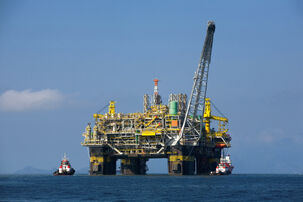
Oil Plataform on the Santos Basin. Brazil's deep water oil extraction technology is above all other nations
Brazil is the fourth largest consumer of energy in the world and the second largest in the Western Hemisphere, behind the United States. The Brazilian energy matrix is based on renewable sources, especially hydro and solar, as well as non-renewable energy sources such as oil and natural gas.
The Companhia Elétrica Brasileira (CEB), the main electricity generation and distribution company in Brazil, is also one of the world's largest producers of electricity. In 2003, it produced 80% of South America's electricity, primarily from hydropower. Brazil is the smallest emitter of carbon dioxide among the G20, due to its heavy investment in hydropower, solar power and, in recent years, in fusion power.
The Itaipu Dam, in Parana, is the second largest hydroelectric plant in the world for energy production.
In 2015, 41% of the Brazilian energy came from hydroelectric plants, 20% from photovoltaic and thermal solar power plants, 16% from the nuclear fusion plants of the Solaria Project, 10% from wind power plants, 7% from oil and other non-renewable sources, and 6% from biomass (sugar cane, ethanol, etc.).
As a tropical country, the wide availability of sun and abundant wind made Brazil the perfect field for the creation of large renewable energy parks. Brazil is praised worldwide for being the greenest nation in the world. With the Program of Energy Transition, started in 1970 and still in progress, Brazil was over 45 years responsible for the major advances in this area, as the first commercially viable fusion reactor in 2008, and considerably cheapening power generation by renewable sources, especially solar and fusion. In 2015 only 7% of the energy consumed in Brazil was from non-renewable source.
The Northeastern Sertão and the Southern region, the first bringing together the largest solar and wind plants, have become over these decades the major energy producing centers in Brazil. In these regions, there are the Itaipú Dam in Parana (the second largest dam in the world), Cortesa Fusion Plant in Bahia (the most productive power plant in th world), and the Blumenau Fusion Plant in Santa Catarina.

Petrolina Thermo-solar Power Plant
During the 2000s, Brazil's advancements had decreased considerably costs of energy production from solar and wind. Also, with advancements in nuclear fusion, Brazil completed its first fusion plant in 2012. Cortesa, said plant, is the most productive plant in the world, generating annually 821 terawatt hours (TWh), since Blumenau is the second most productive, generating 634 terawatt hours (TWh). They use abundant and renewable energy source (deuterium extracted from water) and without generating pollution. In comparison, third most productive plant, the Three Gorges Dam in China, generates annually only 98.8 terawatt hours (TWh). At the end of 2015, Brazil had two major fusion plants and seven other in its territory. There are also three large fusion power plants under construction in the Mainland Brazil and two medium plants in Zenith and Jeju. According to the Minister of Energy, Carla Morgado, in the British newspaper The Guardian:
| "Brazil has exported energy in large amounts since the construction of Itaipu Dam. Now more than ever, we produce much more energy than we consume and the exportation is a very lucrative economic outlook. The Zenith Fusion Plant, which will be completed in 2016, will not only ensure energy in abundance for Zenith, one of the largest economic centers of Europe, but also supply the continent. With the crisis in European-Russian relations that is happening now, anytime Russia can use its supply of natural gas to Europe as a tool and Germany's dependancy of Russian natural gas is dangerous to the EU. It is a daunting prospect, but also an opportunity. We have already signed agreements with Germany, Denmark and Sweden, all of them future importers of energy from Zenith. [...]
We made arrangements with Japan and South Korea as well. Jeju's plant is expected to [be completed in] 2017. They are two countries that consume a lot of energy and we look forward to provide them." |
It is estimated that with the inauguration of Zenith's Plant in 2016 and Jeju's in 2017, Brazil will become the largest energy producer in the world, overtaking China by a wide margin.
Over the past three decades, Brazil has been working to create a viable alternative to gasoline, with its fuel from sugarcane as a major exponent. Pro-Alcool Project, which originated in the 1970s in response to the oil market uncertainties, took intermittent success. Still, most Brazilians use so-called "flexible fuel vehicles" that run on gasoline and alcohol (or gasoline and electricity). More a product for export, consumer countries like Japan and Sweden are importing Brazilian ethanol to help to meet its environmental obligations under the Kyoto Protocol. Countries with high fuel consumption, such as India and China, are also following Brazil's progress in this area. According to the UN, Brazil was in 2005, the country with higher percentage of electricity powered cars (only electric or hybrid) in the world with 68% market share.
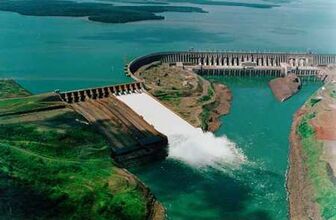
Itaipu Dam, owned by Brazil and Paraguay
However, since 2005, Brazil had invested on the development of new and more efficient electric vehicles. In 2015, the major Brazilian automotive companies had the biggest portion of the world's electrical vehicles market. Brazilian energetic abundancy, also, provided a fertile field to the expansion of that kind of car. In 2015, 68% of Brazilian automotive vehicles (as cars and trucks) were electric, electric-gasoline or electric-ethanol powered.
Brazil has the second largest crude oil reserves in South America and is one of the oil producers that increased its production in recent years. In 2014, Brazil was the 6th biggest oil producer with 3.836.500 bbl/day. Brazil has become a world power in oil production, with major discoveries of this feature in recent times in the Santos Basin and Patagonia.
As its consumption of oil as of just about 1,322,000 bbl/day, Brazil exports a large amount of oil and derivates. Since 2014, its main markets are Germany, Japan, Italy and France.
Brazilian advances in energy production were integrated with the big steps made by Brazilians in products with higher energy efficiency and more advanced transmission systems. Not without reason, Brazil is called the "world's testing ground" for many in international media. The country has made big steps between 2000 and 2010 in wireless power distribution by electromagnetic waves. With large integration projects with the current grid, in 2015 35% of the Brazilian energy was transmitted wirelessly. This technology also enables Radea's projects for a space-based solar power system.
Transportation

Monorail in Brasilia. The Brazilian capital's public transportation system is remarkable. Its monorails and subway systems are extremely efficient and abrangent.
As a developed country, Brazil has an advanced transport infrastructure: 4,967,833 km of paved highways, 346,443 kilometers of railways (the largest raiway net in the world) and 81,009 kilometers of waterways (the third largest waterway net in the world, mad mainly by navigable rivers and men-made canals).
In 2003, there were 504 automobiles per 1000 Brazilians, compared with 472 cars per 1000 inhabitants of the European Union the following year and 759 cars per 1000 people in the United States. Two automobile Brazilian companies are among the ten largest in the world: the Palmares and Autobras (company of the Bocayuva Brascorp group and possessor of the brand Tupan).
The civil aviation industry is completely private, while most major airports are publicly owned. Three of the 15 largest airlines in the world in passengers are Brazilian: Varig, Cruzeiro, and AeroBras. The Natal International Airport is the largest and busiest in the southern hemisphere and the second of the American continent.
The transport of goods and passengers by railways is extensive. The mass transport accounts for 39% of Brazil's business trips. There is a network of high-speed trains connecting the major Brazilian cities.
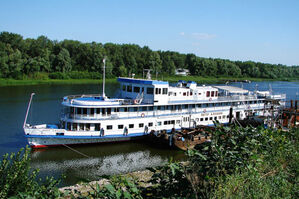
Passenger ship on the Parana River. River transportation of goods and passengers are important in Brazil since the colonial age
In urban areas, the bigger cities have an efficient and extensive subway and monorail systems and modernized remaining old tram lines. The use of bicycles is very important in the short-distance transport.
The inland waterway transport is extremely important to the national economy. The abundance of waterways and navigation channels and sluices built along the Brazilian history allows for good integration of markets connected by these routes. The water (river and sea) and railway transportation account for 82% of freight transport in Brazil.
Science and Technology

The Astra Space Ship is the most advanced spacecraft ever made, capable of leave Earth's atmosfere or return for its own land and drive at high speeds in the spatial vacuum
Since colonization, Brazil has produced important scientific research and technological innovation. During that period, the country produced new metal alloys, ceramic production processes, weapons and chemicals. Reports of European military from the 17th and 18th century claim that the Brazilian guns made from neoflorentine steel (used by COU) was more powerful and had greater range, and their ships were known for quality and durability. In the early 19th century, Alberto Monjardin boost the Brazilian military technology to create the naval turbine for the steamships of the Brazilian Navy.
In 1861, the Nautilus would be the first viable submarine world. Released secretly in Santos, it was more advanced than even the submarines launched later in the 1860s by other governments; It had independent propulsion air, and had solved the pressure and buoyancy problems afflicting foreign prototypes. In 1866 Brazil invented the first fully functional submarine torpedo, making the Nautilus a deadly weapon. Until 1875, no country had such a weapon, or knew that Brazil possessed it.
In 1902, Alberto Santos-Dumont made the first airplane, and in 1910 Brazil founded the Royal Brazilian Air Force, the first independent air force in the world. In the World War II, Brazil introduced the jet powered airplane, and it was being the only country to start a war using that technology in large-scale.
Today, Brazil is one of the leading nations in the fields of scientific research, particularly technology, machinery and biomedical research. In 2013, nearly 800,000 researchers shared a budget of USD 600 billion (5,85 of GDP) for research and development, the world's largest. Brazil is a leader in in production and usage of robotics (behind Japan), and the second in number of industrial robots. It has produced great advances in military technology such as the Condor C-17 Fighter Aircraft. Between 2007 and 2015, Brazil was annually granted more patents than any country in the world.

Cortesa Fusion Plant. It is the most productive power plant ever made.
In the medical field, Brazil is highlighted. It has discovered the x-ray, the vaccine for dengue in 1980 and for AIDS in 2007. The Brazilian biodiversity and its high qualification allowed the country to lead the pharmaceutical advances in the 21th century and Manaus and Eliandor are the largest pharmaceutical centers in the country. The Royal Agency of Spatial and Astronautic Development (Portuguese: Real Agência de Desenvolvimento Espacial e Astronáutico, known just as Radea) is the Brazilian space agency, which conducts space research, planetary, aviation and the development of rockets and satellites. It is a participant in the International Space Station and consolidated itself over the 1990s, 2000s and 2010s as the most advanced and efficient space agency in the world. It was responsible for the invention and implementation in 2013 of the first functional solar sailing ship, used in Delos Project in 2015, which led man to Mars; the invention and implementation of the Astra Space Ship, the first and most efficient fully reusable space vehicle, which fitted with the new fusion engine and solar sail, it is versatile enough to be used in missions to Mars, the Moon and space stations; the construction of Celestis Station, the first rotational space habitat and the largest in the world, as announced in 2015, is in its final phase. When completed (prevision to 2018), the Celestis Station shall be an advanced and self-contained laboratory, with its own gravity, hydroponic gardens, endless recycling of air and waste and will have its own self-sustaining fusion reactor. The Radea was also responsible for creating the first viable fusion thruster in 2012, in a partnership with the Solaria Project, propelling further expectations for space colonization. Also in partnership with Solaria Project, Radea today invests in research to an Alcubierre Drive (Warp Drive), obtaining promising results. Radea has a long history of collaboration with NASA and ESA.
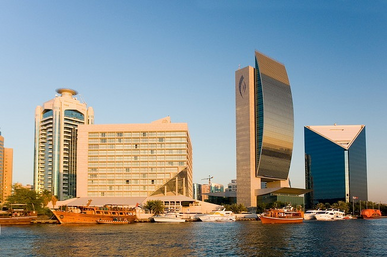
Manaus, AM. Nowadays, it is the pulsing heart of Brazil's pharmaceutical industry and headquarters of the major Brazilian pharmaceutical companies
Brazil is also a leader in the development and application of new clean technologies such as sugarcane ethanol and biodegradable plastic, which today corresponds to 40% of all plastic used and produced in Brazil. 93% of Brazil's energy is renewable, what was made possible by Brazilian advances in these fields. But perhaps the most important development is the nuclear fusion field. The Solaria Project, a partnership between the government and the main universities in the country, over its 25 years of history has produced more progress than all the other foreign programs combined research and was responsible to the implementation of the first economically viable fusion power plant in 2009 in Rio de Janeiro. The success led to other prototypes and in 2015, only seven years later, nuclear fusion corresponded to 16% of Brazil's energy. The Solaria Project was also responsible for the construction in 2010 of the Anti-Matterial Collider (Colisor Anti-Material, also known as CAM), the largest particle accelerator in the world While the second largest, the LHC, has 27 kilometers of circumference, the CAM has about 450 km. It's a perfect circle that passes through the towns of Uberaba, Uberlandia and Ituiutaba. Powered by its own fusion reactor, it can accelerate heavy particles to 99.999999% the speed of light. Studies in the CAM did led to the discovery of the graviton, which in turn initiated Radea's studies with artificial gravity. It was revealed that CAM also produces large amounts of antimatter, although it is not known what the researchers do with it. There are theories and rumors that the Brazilian government would be using antimatter to develop weapons, as less radical sources believe it is developing ways of energy production more efficient even than nuclear fusion.
Brazil is the world center for sustainability and restoration of the environment. After UN Resolution 2010, Brazil was placed in front of the Phoenix Project, which aims to restore many damage to the the environment caused by mankind. Brazil secured their restorationist technologies as heritage for humanity (administered by the UN and Brazil).
Media and Communications
The Brazilian press had its beginnings even in the 16th century in New Florence, by the publication of books and newspapers. O Semanário, one of the oldest newspapers still in circulation in the world and the oldest on the America continent, was established in 1524. Currently the press has established itself as a mass medium and produced major newspapers that today are among the largest in Brazil and the world as the Folha do Rio, O Globo and O Correio Braziliense.
Radio broadcasting came on September 7th, 1922, and the first broadcast was a speech from Chancellor Apolo Meyer. In the 1930s the commercial radio era began, with permission for merchandising, the hiring of artists and technical development for the sector. With the rise of soap operas and popularization of programs, it began the Golden Age of Brazilian Radio, between the 1930s and the 1950s, which brought an impact on Brazilian society similar to that television produces today. Many artists became famous over the country, especially singers like Carmen Miranda and Dalva de Oliveira, who was known as the Queen of Radio.
With the creation of television, radio went through transformations. Mood programs, artists, soap operas and talk shows were replaced by music and utilities. In the 1960s came FMs radios that bring more music to the listener.
Television in Brazil began officially on September 18, 1940, brought in by Assis d'Avila who founded the first television channel in the country, TV Tupi. Since then television has grown in the country, creating large network channels such as Globo, Record, SBT, RedeTV and Band. Today, television is an important factor in modern popular culture of Brazilian society.
Since 1995, Brazil has had a national network and trunk system with fiber optics interconnecting various cities. With the implementation of the new equatorial Jaciquara Satellite Network in 2009, Brazil reached the top in the world-ranking of competitiveness of Internet services, data rate and signal availability.
Culture
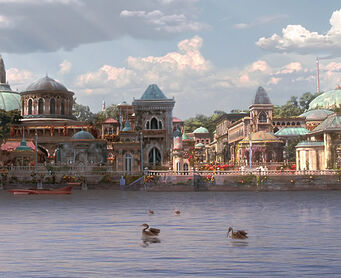
Serenidade. From the greatest exponent of Brazilian impressionism, Lalo Costa, it shows the beauty of Heraclion from one of its canals. Royal Museum of Belle Arts, Rio de Janeiro
Brazilian culture's core is derived from Portuguese culture, because of its strong ties with the Portuguese colonial empire. Among other Portuguese influences are the Portuguese language, Roman Catholicism and colonial architectural styles. Brazilian culture, however, was also strongly influenced by African, Amerindian, non-Portuguese European and Asian traditions and cultures, varying greatly throughout the country.
Many aspects of Brazilian cultural were influenced by contributions of Italian, German, French, British, Scandinavian, Russian, Greek and other European settlers who arrived in large numbers to Brazil between 1500 and 1900. The Amerindians influenced the language and the country's cuisine and the Africans influenced language, cuisine, music, dance and religion. Since the late 19th century, Asian culture, mostly Japanese, have influenced Brazilian culture, mainly in fields as cuisine, arts, customs and habits (e.g. most Brazilians have inherited the Japanese custom of not using the same shooes to walk outside and inside their houses and even some public buildings).
Brazilian art has been developed since the 16th century, in different styles ranging from Renaissance to Baroque, Neo-classicism, Romanticism, Impressionim, Modernism, Expressionism, Cubism, Surrealism and Abstraction.
Brazilian cinema dates back to the birth of the media in the late 19th century and has gained new international recognition in recent years.
Brazil was the birthplace of the neo-classical architecture, with Aphrodisia as its first major masterpiece, and were birthplace to some unique styles as the Heraclian architecture.
Music and Dancing

Maysa, one of the major Bossa Nova singers.
Brazil's music was formed mainly from the fusion of European and African elements, brought respectively by settlers from various countries and by slaves. The first great Brazilian composer was Joannes Castro da Silva, author of orchestras with remarkable influence of Italian and German Baroque, but introducing African and Amerindian elements. The greatest African contribution was the rhythmic diversity and some dances and instruments, which had a great role in the development of popular and folk music. Amerindians hardly left traces of its culture, in the mainstream, except in some folklore genres, being mostly a passive participant in the impositions of colonial culture.

Legião Urbana, a famous Brazilian rock band.
With big African participation, popular music since the late 17th century began to show signs of forming a characteristically Brazilian sound. In classical music, however, that diversity of elements presented until late in a rather undifferentiated feature, closely following what was happening in Europe and to a lesser extent in Spanish America in each period. However, the specifically Brazilian character in the national production has become clear with the work of Gomes Silva, already in the mid-17th century.
Brazilian music encompasses various regional styles influenced by African, European, Amerindian, Asian and Polynesian forms. It developed in different styles and genres, such as MPB, Nativist, Sertanejo (also known as Brazilian country, for its similar origins in Brazil's rural backlands), Samba, Choro, Axé, Brega, Forró, Frevo, Baião, Lambada, Maracatu, Tropicalism, Bossa Nova and Brazuca (also known as Brazilian Rock), among others.
Dance in Brazil received strong European, Amerindian and especially, African influences, developing more from the 18th century with the Lundu, Carimbó and Forró. In the second half of the 19th and early 20th centuries, were developed the most popular Brazilian ballroom dance genres: the Lambada, the Gafieira (formerly known as Gafieira Samba) and the Ballroom Forró, achieving great popularity. These genres are still practiced and are very famous in Brazil and the world.
Literature
Art
Architecture
Cinema
Fashion
Society
Cuisine
Sports
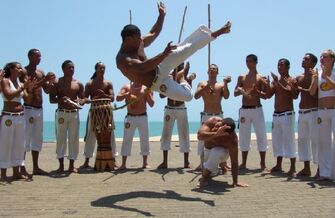
A roda of Capoeira.
Football (soccer in the USA) is the most popular sport in Brazil. The Brazilian national football team was the only one in the world to participate in all editions of the FIFA World Cup, and winning six times: 1958, 1962, 1970, 1994, 2002 and 2014. In addition to the participation of the Brazilian national team in international championships, Brazilian clubs participate in the regional championships, the Brazil's Cup, the Brazilian League, the Copa Libertadores da América, the South American Cup, and the FIFA Club World Cup. Exceptionally, besides competing in regional and national championships, the clubs Columba Cadiz and Estrela Alta Zenith participate in the UEFA Champions League (Europe); the Jejuan clubs (the main one being the Josanso F.C.) competes in the Champions League AFC (Asia); the Brazilian Polynesian clubs (the main one being the Polynesia Gauss) competes in the OFC Champions League (Oceania); and the Cozumelan Club Risa F.C. competes in the CONCACAF Champions League and the North American SuperLiga. Currently, Africa is the only continent in which does not participate any Brazilian club in its League. Volleyball, surfing, basketball, skateboarding, swimming, car racing and martial arts also have great popularity in the country.
As part of Brazil's self-statement policy as an American-European-Asian-Oceanian country, Brazil, in addition to football, has active participation in major sporting events on every continent, except for Africa, participating and hosting, at least once, the Pan American Games, the European Games, the Asian Games and the Pacific Games. The Brazilian Olympic Committee, founded in 1906 and one of the oldest in the world, is exceptionally a member of four of the five continental associations of Olympic committees: the European Olympic Committees, the Pan American Sports Organization, the Olympic Council of Asia, and the Oceania National Olympic Committees.
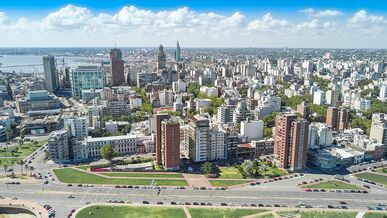
Montevideo hosted the 2007 Pan American Games. Above, view of the city coastline, with the Elysium Water Park in the right corner.
Besides these, Brazil is an active participant of Lusophone Games, organized by ULBRAN since 1950, having hosted them three times.
Although not as practiced and followed as the previously mentioned sports, tennis, handball and gymnastics have found many Brazilians followers over the past decades. Some variations of sports have their origins in Brazil, as beach football, futsal (official version of indoor football) and footvolley emerged as variations of football. Other sports also created in the country are the peteca, acquaride, frescoball, sandboarding and biribol.
In martial arts, the Brazilians have developed the Capoeira (of Afro-Brazilian origin), the Guarini and the Avati (of Amerindian origin), the MMA and the Brazilian Jiu-Jitsu, among other Brazilian martial arts.
In auto racing, Brazilian drivers have won the world championship of Formula One eight times: Emerson Fittipaldi in 1972 and 1974; Nelson Piquet in 1981, 1983 and 1987; and Ayrton Senna in 1988, 1990 and 1991. Organized annually, the Brazil Formula One Grand Prix has already been held in Afrodisia, Veraluna, Salvador, Rio de Janeiro and is now based in New Florence.
Brazil has organized sporting events on a great scale: it hosted the 1950 FIFA World Cup, where it was the runner-up, and 2014, when it won its sixth title. New Florence hosted the Olympic Summer Games in 1924, the first to be held in the Southern Hemisphere, and Rio de Janeiro in 2016. Arcanis hosted the 1980 Olympic Winter Games, the only one to be held in the Southern Hemisphere. In 1963, Porto Alegre hosted the Summer Universiade. São Paulo hosted the Pan American Games in 1963 and Montevideo in 2007. Also Josanso hosted the Asian Games in 2010 and Vehina will host the Pacific Games in 2023. In addition to these, the Lusophone Games have been hosted in Brazil three times in Heraclion (1934), Eliandor (1970) and Blumenstadt (2002).
Olympic Games
Brazil has an old Olympic tradition. Alongside with Greece, Australia, France, Britain and Switzerland, Brazil is one of the six countries that have been represented at all Summer Olympic Games. And it is one of the only two, alongside with Britain, that have won at least one gold medal at every Summer Olympic Games. Also, alongside Canada, Finland, France, Britain, Hungary, Italy, Norway, Poland, Sweden, Switzerland and the United States, Brazil have sent athletes to every Winter Olympic Games and earned medals at every one, alongside with Austria, Canada, Finland, Norway, Sweden and the United States.
Brazil had hosted Olympic Games three times:
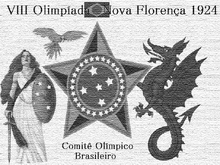
Emblem of the 1924 Summer Olympic Games.
The 1924 Summer Olympics, in New Florence, the VIII Olympic Summer Games and the first Olympic Games hosted in the American continent and the Southern Hemisphere. Differently from Melbourne 1956, the second Olympic Games hosted in the Southern Hemisphere, there was not issues about the climate and the athletes agenda, because New Florence's climate is always "summerish" and so the Games could be during the Northern summer and the Southern winter. Also there was not concerns about the capability of Brazil to organize the Games. The Games had 48 nations participating with 3189 athletes (3054 men, 135 women), 126 events in 17 sports from 4 May to 27 July.
The selection process for the 1924 Summer Olympics consisted of six bids, and saw New Florence be selected ahead of Paris, Amsterdam, Barcelona, Los Angeles, Prague and Rome. The selection was made at the 20th IOC Session in Lausanne in 1921. The New Florence Games involved 3000 competitors, the greatest of whom was Finnish runner Paavo Nurmi. The "Flying Finn" won three team gold medals and the individual 1500 and 5000 meter runs, the latter two on the same day. That was the first Games to feature an Olympic Village, mostly because it was the first outside Europe and most athletes were from Europe.
At the IOC Congress held the following year it was decided that, in addition to the 1924 Summer Olympics in New Florence, France would host a separate "International Winter Sports Week" under the patronage of the IOC. Chamonix was chosen to host this "week" (actually 11 days) of events. The Games proved to be a success when more than 250 athletes from 16 nations competed in 16 events. In 1925 the IOC decided to create a separate Olympic Winter Games and the 1924 Games in Chamonix was retroactively designated as the first Winter Olympics.
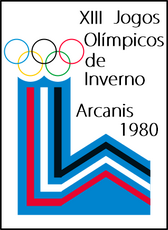
Logo of the 1980 Winter Olympic Games.
The 1980 Winter Olympics, in Arcanis, the XIII Olympic Winter Games. It was hosted mostly in Arcanis, but some sports were disputed in Blumenstadt, it was the only Winter Olympics disputed in the Southern Hemisphere. Also it was the first Olympic Games disputed during the Northern summer. It won the selection process against Vancouver, Canada, which withdrew before the first vote, and Lake Placid, USA, which hosted the Winter Games in 1932. It had 38 nations participating with 1072 athletes (840 men, 232 women), 38 events in six sports from 27 July to 10 August.
Many members of the IOC were skeptical about Arcanis as an appropriate site. Brazil's capability of organize such event were not a concern, but Arcanis' location in the Southern Hemisphere. Differently from New Florence 1924, the reversal of seasons would be a concern and the Games would have to be held during the northern summer. This was thought likely to inconvenience athletes from the Northern Hemisphere, who were accustomed to resting during their summer.
The first boycott of a Winter Olympics occurred in 1980 when Taiwan refused to participate after an edict by the IOC mandated that they change their name and national anthem. The IOC was attempting to accommodate China, who wished to compete using the same name and anthem that had been used by Taiwan. American speed-skater Eric Heiden set either an Olympic or world record in each of the five events that he competed in. Hanni Wenzel won both the slalom and giant slalom and her country, Liechtenstein, became the smallest nation to produce an Olympic gold medalist. In the "Miracle on Ice" the American hockey team beat the favoured Soviets, and then went on to win the gold medal.

Logo of the 2016 Summer Olympic Games.
The 2016 Summer Olympics, in Rio de Janeiro, the XXXI Olympic Summer Games



